- The Top 10 Things To...

Top 19 Things To Do and See in Bangkok, Thailand

As one of the world’s top tourism destinations, Thailand’s capital city has countless sites all competing for space on your itinerary. Get the most out of your stay, sampling a full spread of Thai experiences with these top things to do in Bangkok.
With hundreds of temples, markets and street food stalls within Bangkok’s lively city limits, exploring the Thai capital in full can be as relentless as its whizzing tuk-tuks and all-hours nightlife. This guide will help you see the city through experiences that highlight its history alongside elements of modern Thai life, from street art that explores Bangkok’s communities to the intricate preparation of centuries-old cuisine.
1. Cruise the city’s ancient khlongs
Natural Feature

Bangkok was once a flourishing trade centre, connecting areas of the expansive Siam Kingdom through its series of canals – or khlongs – throughout the Chao Phraya River Delta. Today, these narrow waterways of Thonburi still evoke the city’s old soul, lined as they are with floating wooden shopfronts, weathered teak homes and quiet temples. You can hire a colourful long-tail boat from any of the major tourist piers, like Tha Tien, or go hassle-free with a tour that picks you up right from your hotel. Pandan Tours are recommended, and cost around 500THB (£13) an hour for a boat rental, or 2,000THB (£53) per person for a day-long tour.
2. Learn how to meditate at the country's first Buddhism school
Buddhist Temple
The Land of Smiles didn’t earn its moniker without a bit of soul-searching. Thailand’s Buddhist tradition is grounded in Vipassana meditation, a practice centred on mindfulness and gratitude. There are centres throughout the city that offer everything from introductory classes to multi-week silent retreats, or to just test the waters you could check out the International Buddhist Meditation Centre at Wat Mahathat, right near the Grand Palace. Three free guided meditation classes are held daily from 7am to 10am, 1pm to 4pm and 6pm to 8pm, assisted by English-speaking monks.
4. Cook like a royal chef at the Blue Elephant
Restaurant, Thai

5. Explore Phra Nakhon street art
Building, Art Gallery
In 2018, the Thai government commissioned 10 street artists to design murals throughout the Phra Nakhon neighbourhood. Beginning at the Pipit Banglamphu Museum, you can follow a self-guided walking or bicycle tour through Bangkok’s Old Town. The murals on the route reflect the spirit of the neighbourhood’s unique communities, depicting artists’ interpretations of local crafts, traditions and foods. You can also take a break from the city heat at the museum itself, which highlights the area’s long history of mixed cultures, music, silver and goldsmithing and unique crafts like banana stalk carving.
6. Get a vintage portrait taken at Chaya Jitrakorn
Art Gallery
This classic portrait studio was once the most distinguished in Thailand, photographing prominent Thai politicians and celebrities over the last century. The shop’s three floors evoke another era altogether – there’s a vintage changing room, a salon with classic dress uniforms and an opulent Rococo-style portrait studio. Join photographer Chaya Jitrakorn’s elite clientele by having your photo taken the old-fashioned way and touched up by hand using traditional oil-painting techniques.
7. Try the city's oldest soup in Ekkamai
Hole in the Wall, Thai
The chefs at Wattana Panich have been cooking the same pot of soup for the last 60 years and over three generations. This family-run kitchen in Ekkamai is famous for its beef stew, and they are constantly topping up the enormous cauldron with fresh ingredients that are absorbed into the broth, ever deepening the flavour. The exact recipe is a prized family secret. Each morning, 25 kilograms (55 pounds) of fresh beef is added straight to the pot and cooked twice, then served with a selection of menu items.
8. Find your own protective amulet at Tha Prachan Market

This century-old market along the Chao Phraya features enormous collections of amulets with images of the Buddha, enlightened monks, Thai kings and more. In Thai Buddhist tradition, amulets are blessed by monks to guard against bad fortune or bring good luck. The most powerful ones are made with additions like ash from a sacred temple, or hair from a famous monk, to bolster their protective powers. Replicas fetch a few dozen baht and are considered good enough for garnering a daily dose of good fortune. But throughout the market there are prized pieces that attract the attention of dedicated collectors, who conduct their own appraisals and argue over the backstories and histories of individual amulets.
9. Catch a free Muay Thai fight at MBK
Shopping Mall, Stadium, Shop

10. Cycle around Bangkok's green lung, Bang Krachao

11. Feast on authentic pad thai at Thipsamai
Restaurant, Food Stall, Thai

This famous noodle dish has a unique – and surprisingly recent – history. Developed by the country’s prime minister after World War II in response to the high cost of rice production, its creation also served to unite the country’s provinces with a single national dish. Thipsamai in Bangkok’s Old City opened in the 1950s as one of the country’s first pad thai stalls, and adheres to the same family recipe today. Using soft sen chan noodles, a secret prawn-oil recipe and expertly thin egg wrap, Thipsamai whips up its signature dish over searing hot charcoal with a routine that takes its resident chefs more than three months to learn. The effort recently earned the local haunt a Bib Gourmand Award for exceptionally good food at a modest price.
12. Watch takraw showdowns in Lumpini Park

13. Get over-the-top entertainment at a katoey show

14. Brave Bangkok's glass skywalk at Mahanakhon
Architectural Landmark, Building

At 310 metres (1,017 feet) high, this transparent glass skydeck extends over the edge of the King Power Mahanakhon building – Thailand’s tallest building – with uninterrupted views of Bangkok in every direction. The rooftop features Thailand’s newly crowned highest bar, with a full menu of champagne, spirits, wines and beers available in case you need a little liquid courage before stepping out over the edge. There’s also an indoor observation deck and the building’s highest point, The Peak, which offers full 360-degree panoramic views over the massive capital city.
15. Make flower garlands at Pak Khlong Talat
16. give in to your sweet tooth at baan dok pud.
Thailand’s cuisine is famously spicy, but its menus also offer decadently sweet dessert options, beautifully prepared and infused with local flavours. Staples like mango sticky rice are available at any street market or Thai restaurant, and different communities feature their own unique fare, like the Portuguese-inspired Kudeejeen cupcake from Bangkok’s Old City. But don’t miss treating yourself to the full spread of traditional Thai sweets. Baan Dok Pud in Lad Phrao has a gorgeous – and air-conditioned – space surrounded by a quiet koi pond, and serves colourful dessert sets afternoon tea-style. Try the bua loy , glutinous rice balls filled with mung bean paste drenched in coconut milk, or the popular tong yip , flower-shaped egg yolk tarts. Some Thai desserts are even believed to bring good luck , so there’s no need for sweetness in moderation.
17. Sample Thailand's up-and-coming craft beers at Golden Coins Taproom
Bar, Craft Ale Bar, Beer
Thai laws have long been difficult for home-brewers to navigate, favouring the behemoth national beer brands like Singha and Chang. But some craft patrons are driving a burgeoning local beer scene in the city, blending Thai flavours and regional ingredients to serve up locally inspired brews. Golden Coins Taproom is an Ekkamai pub that brews its crafts in Vietnam and then imports them to Bangkok, making use of a handy loophole in the legal code. There are 12 taps and a range of bottled beers, from stouts to pale ales and IPAs, as well as a great menu of pub grub if you’re craving comfort food from home.
18. Make a wish at one of the most haunted sites in Bangkok

19. Float in a restorative healing pod at Bangkok Float
Spa, Health Spa
Thailand’s wellness tradition has forged full-speed into the 21st century. At Bangkok Float, floaters are immersed in magnesium-infused saltwater kept exactly at room temperature, fooling your body into thinking it’s hovering in mid-air. The experience is designed for floaters to achieve the deep delta-wave state of mind of Buddhist monks more easily than through traditional meditation, while reportedly resetting the body’s hormonal and metabolic balance, improving immunity and generating high levels of endorphins.
This article is an updated version of a story created by Olga Lenczewska .
Since you are here, we would like to share our vision for the future of travel - and the direction Culture Trip is moving in.
Culture Trip launched in 2011 with a simple yet passionate mission: to inspire people to go beyond their boundaries and experience what makes a place, its people and its culture special and meaningful — and this is still in our DNA today. We are proud that, for more than a decade, millions like you have trusted our award-winning recommendations by people who deeply understand what makes certain places and communities so special.
Increasingly we believe the world needs more meaningful, real-life connections between curious travellers keen to explore the world in a more responsible way. That is why we have intensively curated a collection of premium small-group trips as an invitation to meet and connect with new, like-minded people for once-in-a-lifetime experiences in three categories: Culture Trips, Rail Trips and Private Trips. Our Trips are suitable for both solo travelers, couples and friends who want to explore the world together.
Culture Trips are deeply immersive 5 to 16 days itineraries, that combine authentic local experiences, exciting activities and 4-5* accommodation to look forward to at the end of each day. Our Rail Trips are our most planet-friendly itineraries that invite you to take the scenic route, relax whilst getting under the skin of a destination. Our Private Trips are fully tailored itineraries, curated by our Travel Experts specifically for you, your friends or your family.
We know that many of you worry about the environmental impact of travel and are looking for ways of expanding horizons in ways that do minimal harm - and may even bring benefits. We are committed to go as far as possible in curating our trips with care for the planet. That is why all of our trips are flightless in destination, fully carbon offset - and we have ambitious plans to be net zero in the very near future.

Places to Stay
The best spa hotels in bangkok.

The Meaning of Colours in Bangkok

Guides & Tips
Stay curious: experience bangkok from your living room.

Meet the Monk Making Buddhist Robes Out of Plastic

Food & Drink
City on a plate: bangkok at its best, from the dynamic duo behind bo.lan.

Chinatown: Bangkok's Yaowarat Enshrines 700 Years of Chinese Heritage

Where to Book a Stay in Bangkok for a Local Experience

Bars & Cafes
Airline launches restaurant serving airplane food to grounded passengers.

The Best Resorts in Bangkok

Hip Apartments in Bangkok You'll Want to Call Home

The Best Chinese Restaurants in Bangkok

See & Do
12 ways to discover bangkok by bike, barge and tuk-tuk, culture trip spring sale, save up to $1,100 on our unique small-group trips limited spots..

- Post ID: 396005
- Sponsored? No
- View Payload
THE 10 BEST Thailand Cultural Tours
Cultural tours in thailand.
- Ports of Call Tours
- Sightseeing Tours
- Walking Tours
- Cultural Tours
- Up to 1 hour
- 1 to 4 hours
- 4 hours to 1 day
- 5.0 of 5 bubbles
- 4.0 of 5 bubbles & up
- 3.0 of 5 bubbles & up
- 2.0 of 5 bubbles & up
- Likely to Sell Out
- Special Offers
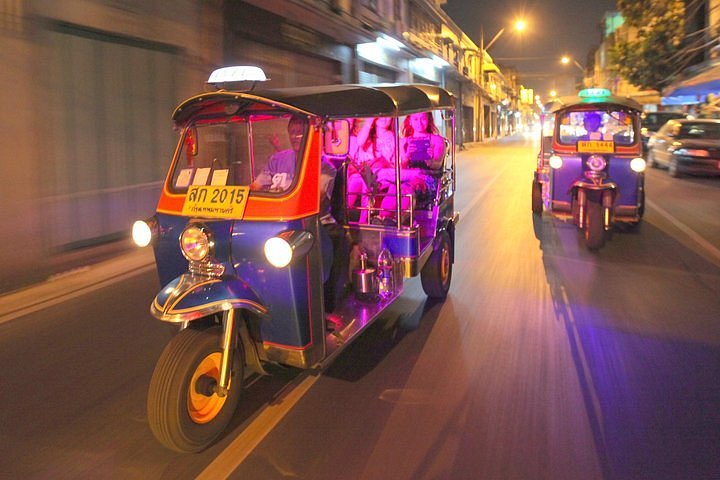
- The ranking of tours, activities, and experiences available on Tripadvisor is determined by several factors including the revenue generated by Tripadvisor from these bookings, the frequency of user clicks, and the volume and quality of customer reviews. Occasionally, newly listed offerings may be prioritized and appear higher in the list. The specific placement of these new listings may vary.

1. Half-Day Railway Market and Floating Market Tour in Thailand

2. Bangkok Half-Day Tour: Three Must-Visit Temples

3. Ayutthaya and Glittering Sunset Boat Afternoon Tour from Bangkok

4. Bangkok Midnight Food Tuk Tuk Tour

5. Phuket City Tour: Karon View Point, Big Buddha, Wat Chalong

6. Bangkok by Private Guide: Full Day Tour In and Around

7. All in One Bangkok Landmark Tour with Grand Palace & Lunch

8. Damnoen Saduak Floating Market and Maeklong Railway Market Tour

9. River Kawai Day Trip from Bangkok

10. Small Group Tour to Ayutthaya Temples from Bangkok with Lunch

11. Chiang Rai Temples: Private Tour from Chiang Mai

12. Chiang Rai White Temple, Blue Temple, Black House from Chiang Mai

13. Historical City of Ayutthaya - Unesco Full Day Tour From Bangkok

14. Bangkok Jungle Bike Tour: Pickup and Lunch Included

15. Pattaya Landmark Tours - All Famous Points in One Day

16. Lopburi Monkey Temple & Ayutthaya Old City Tour From Bangkok

17. ️ Phuket Private Instagram Tour: All-Inclusive

18. Royal Grand Palace and Bangkok Temples: Half Day Tour

19. Best seller!! Amazing Night tour, Doi Suthep + Wat umong - Top Must visit!

20. Ayutthaya Sunset Boat Ride Famous Attraction Tour From Bangkok

21. Private Excursion to Maeklong Railway and Floating Markets

22. Travstore Original Phuket Discovery Tour - Shared Half Day City Tour

23. Floating Market and Ayutthaya Guided Day Tour from Bangkok

24. Ayutthaya and Bang Pa-In Summer Palace: Private Tour from Bangkok

25. Experience Real Bangkok by Bike

26. Top Sights of Samui City Tour

27. Doi Inthanon National Park 1-Day Tour with Nature Trail Trekking

28. The Best City Tour View Points Wat Doi Suthep, Wat Chedi Luang and Wat Pha Lat

29. Erawan National Park and Bridge Over River Kwai: Small Group Tour

30. Bangkok Tuk-Tuk Tour by Night with Chinatown Street Food
What travelers are saying.

Top 12 Cultural Experiences in Thailand You Must Try
Thailand is a country that captivates travelers with its rich cultural heritage, mouthwatering cuisine, stunning natural beauty, and famous hospitality. From exploring ornate temples to learning to cook authentic dishes, Thailand has something to delight all of your senses.
In this article, I will highlight the top 12 cultural experiences that you simply must have when visiting this amazing country. These are the quintessential Thai experiences that will allow you to connect deeply with the local culture and create unforgettable memories. Whether you are interested in festivals, food, nature, or history, you will find an incredible array of cultural activities in Thailand to enjoy.
1. Explore the Grand Palace and Wat Pho Temple in Bangkok
No trip to Thailand is complete without a visit to the Grand Palace and Wat Pho in Bangkok. As the most revered site in Thailand, the Grand Palace complex was built in 1782 and is a stunning display of intricate architecture and design. The grounds are home to the Temple of the Emerald Buddha, Thailand’s most sacred temple, as well as the Thai King’s royal residence. Visitors can marvel at the glittering spires and extensive gold ornamentation found throughout the palace.
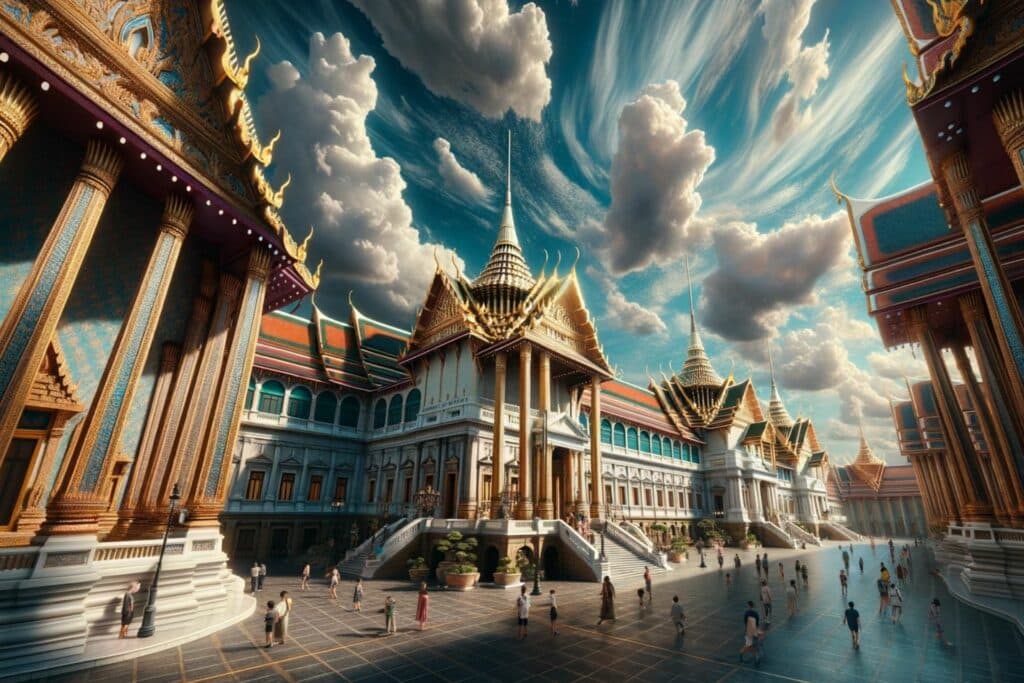
Right nearby you’ll find Wat Pho, known for its enormous reclining Buddha statue and its status as Thailand’s first university. Take time to wander around the expansive temple grounds, admiring the ornate stupas and chapels. Wat Pho is also a great place to experience Thailand’s traditional massage as the temple is considered the birthplace of Thai massage and hosts a renowned massage school. A visit to these impressive Bangkok landmarks provides insight into Thailand’s royal history and Buddhist traditions.
2. Take a Thai Cooking Class and Learn to Cook Authentic Dishes
Thai cuisine is world-famous, so learning to cook authentic Thai dishes is a must-do cultural experience on any trip to Thailand. You can find cooking classes offered throughout the country that provide you with the chance to learn from expert local chefs. Try your hand at making classic Thai dishes like pad thai, tom yum soup, green curry, and more. You’ll also learn about key ingredients used in Thai cooking such as lemongrass, kaffir lime, galangal root, and fresh herbs.
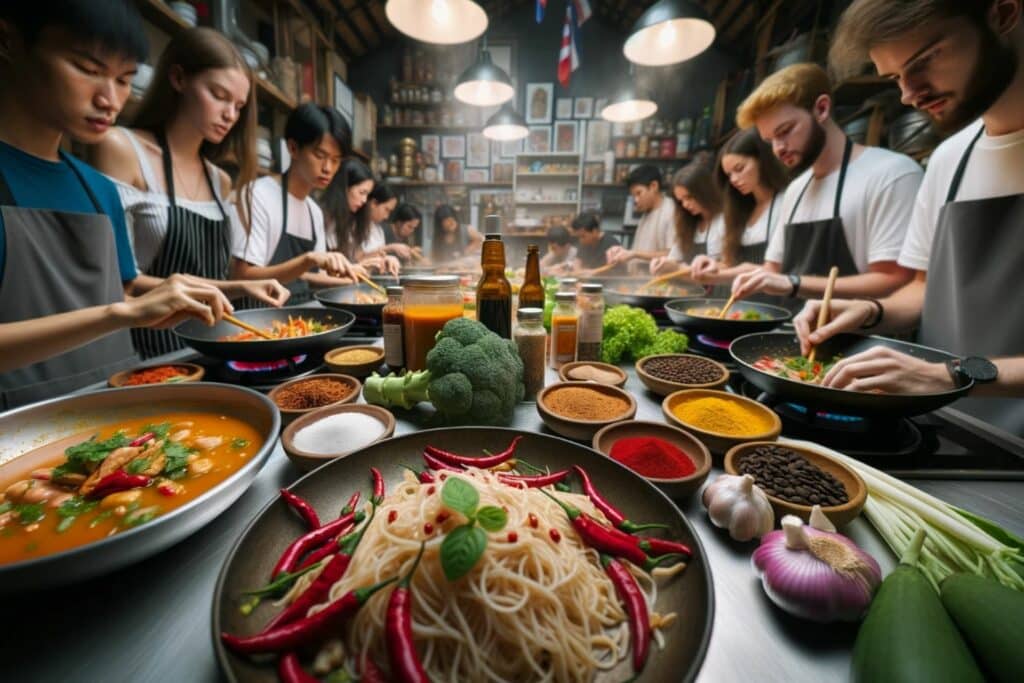
Most classes take you to local markets to learn about Thai produce, spices, and foods. Then you head to the kitchen to prepare your feast before sitting down to enjoy eating the mouthwatering Thai meal you cooked. With its balance of sweet, sour, salty, and spicy flavors, Thai food is a delicious gateway to experiencing true Thai culture.
3. Visit the Ancient Siamese Capital of Ayutthaya
Just outside of Bangkok lies the ruins of Ayutthaya, the former capital of the ancient Kingdom of Siam. Established in 1350, Ayutthaya was one of the world’s most cosmopolitan and affluent cities until it was destroyed by the Burmese army in 1767. Today, Ayutthaya Historical Park is an archaeological site and UNESCO World Heritage Site with many remaining temple ruins and Buddha statues.
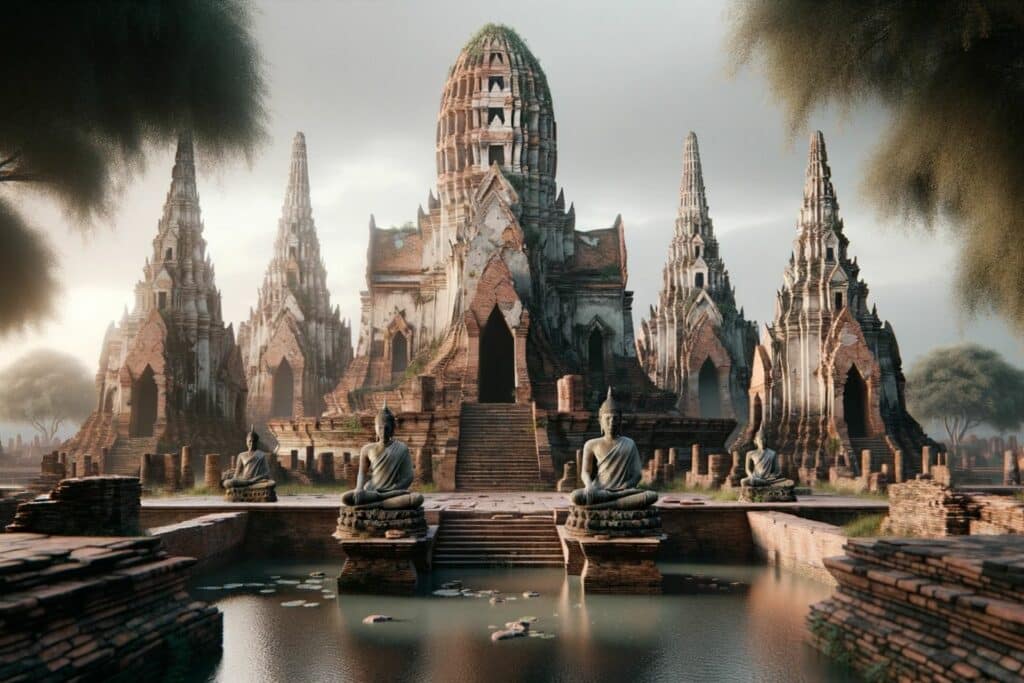
Taking a day trip to Ayutthaya provides a glimpse into fascinating Siam history as you explore the palaces, monasteries, and monuments of this iconic city. Highlights include Wat Phra Si Sanphet, Wat Phra Mahathat, Wat Ratchaburana, and Wat Chaiwatthanaram. You can also hire a bike or join a guided tour to fully experience historical Ayutthaya and imagine what life was like centuries ago in the influential Siamese Kingdom.
4. Eat Your Way Through Bangkok’s Famous Thai Street Food Scene
Bangkok is considered one of the best food cities in the world. So eating your way through the city’s bustling streets and night markets is an essential part of embracing Thai culture. From pad Thai noodles to mango sticky rice and fresh tropical fruit, you’ll find endless options for cheap, authentic Thai food literally on every corner.
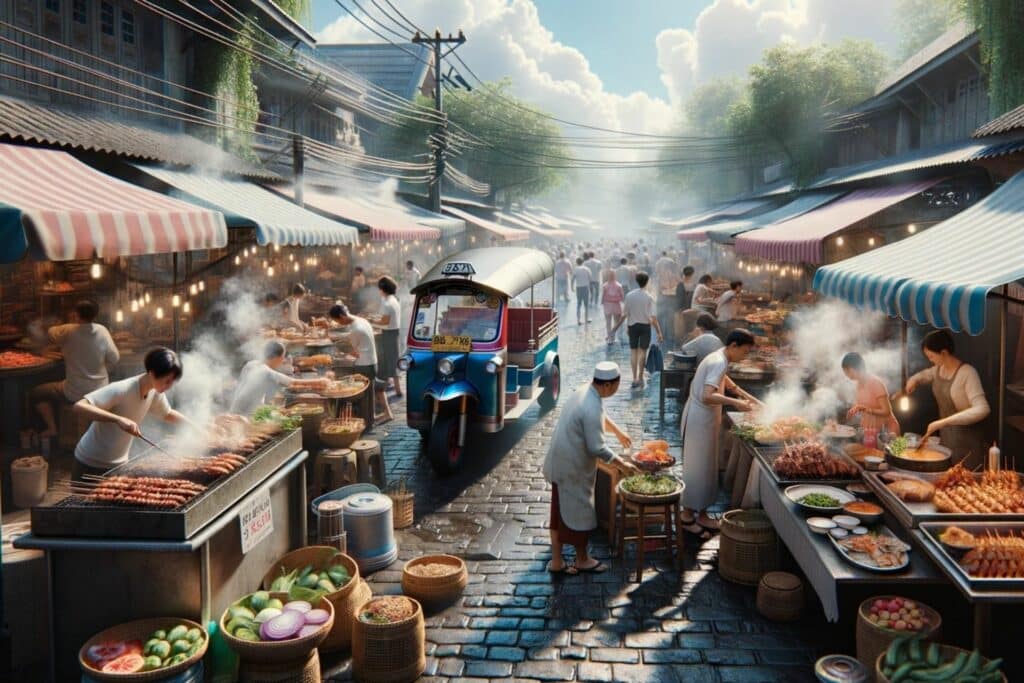
Yaowarat Road in Chinatown comes alive after dark with street food vendors whipping up classics like khao soi and tom yum noodle soup. Khao San Road and Chatuchak Weekend Market also have amazing selections. Be sure to look for popular dishes like gai tod (Thai fried chicken), som tam (green papaya salad), and khanom krok (coconut rice pancakes). Trying all the incredible street food in Bangkok provides your tastebuds with a true immersion in Thai cuisine and culture.
5. Get a Traditional Thai Massage for the Ultimate Relaxation
After eating your way through Bangkok’s streets, take time to relax and rejuvenate with a traditional Thai massage. Thai massage originated at Buddhist temples and involves a combination of gentle rocking motions, applied pressure with fingers and palms, and assisted stretching to loosen muscles and joints. This ancient healing art provides deep relaxation while relieving pain and tension.
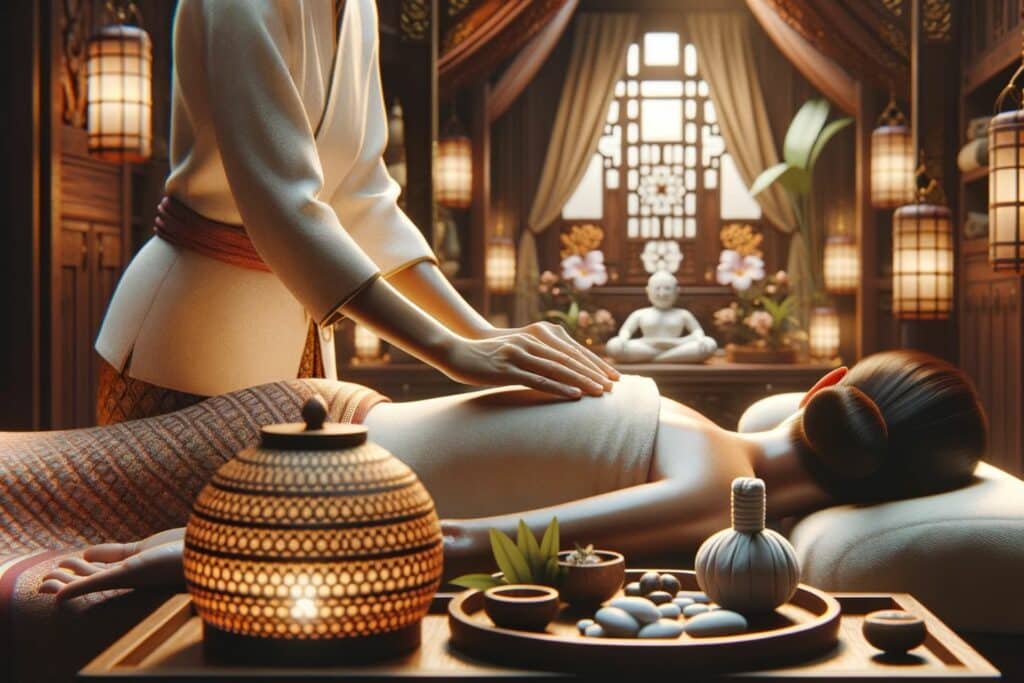
You can get an inexpensive massage at local shops all over Thailand, with some temples like Wat Pho also offering massages. Aromatherapy massages infused with pleasing scents are also popular. The soothing strokes of a Thai massage are the perfect way to experience this unique part of holistic Thai health and wellness culture.
6. Experience the Enchanting Loy Krathong Festival
One of the most magical festivals in Thailand is Loy Krathong, celebrated each November on the night of the full moon. During this festival, people release small “Krathong” boats made of banana leaves and flowers into rivers, lakes, and other waterways across the country. As the Krathongs drift away lit by candles, it creates a spellbinding spectacle of flickering lights.
The tradition began in the ancient Kingdom of Sukhothai as a way to pay respect to the water goddess. Today, Loy Krathong represents letting go of grudges, bad feelings, and misfortunes to start the new year fresh. Locals also believe releasing a Krathong brings good luck.
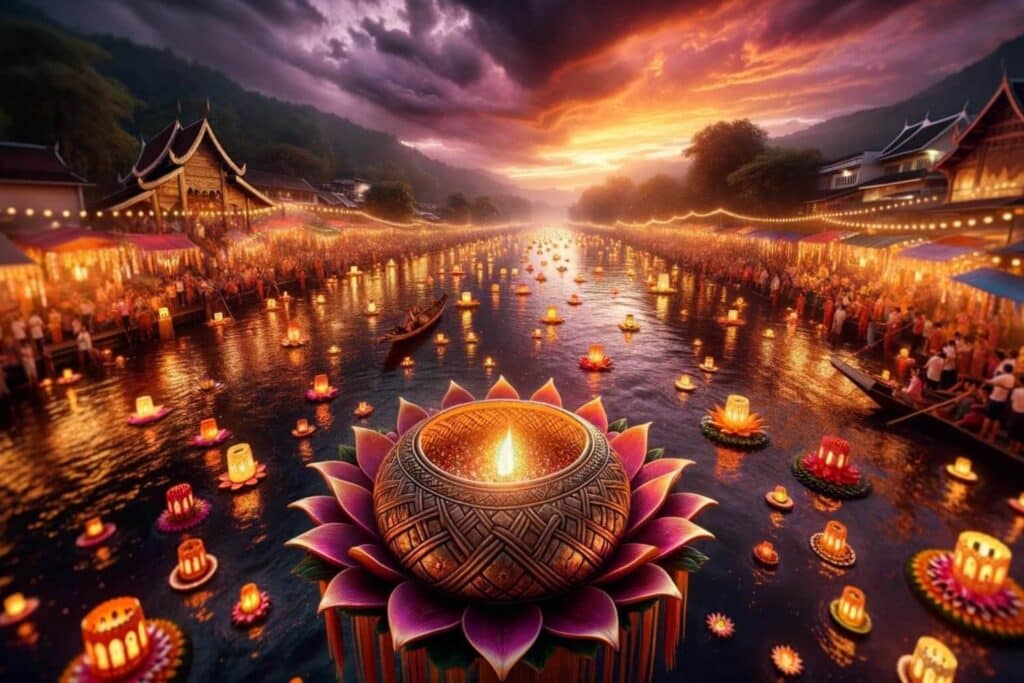
The best spots to experience Loy Krathong are along the Chao Phraya River in Bangkok, the old moat in Chiang Mai, and beaches in Phuket. Watch locals release their Krathongs then make your own mini Krathong from natural materials to add to the illuminated display. You can also see beautifully elaborate Krathongs built for competitions.
Other Loy Krathong festivities include floating paper lanterns, cultural performances like dancing, fireworks, and street food stalls. Immerse yourself in this beloved Thai tradition for a night you’ll never forget. The peaceful image of candles flickering across the water captures the tranquil beauty of Thai culture.
7. See Skilled Muay Thai Fighters in Action
Viewing a live Muay Thai match is not to be missed when in Thailand since Muay Thai is the country’s national sport. Also referred to as the “Art of Eight Limbs,” Muay Thai has ancient origins as a form of self-defense and combat. Today, it is a hugely popular spectator sport. Fighters use intensive punching, kicking, elbow, and knee strikes during matches.
Attending a Muay Thai fight is an exciting way to witness the strength and skill of Thai boxers firsthand. Major stadiums like Rajadamnern and Lumpini in Bangkok host matches where you can cheer alongside enthusiastic local fans.

If you’re inspired to try Muay Thai for yourself, you can also take classes at Muay Thai gyms across Thailand . Feel the energy and pride Thais have for their iconic martial art by watching professionals in the ring.
8. Witness the Yi Peng Lantern Festival in Chiang Mai
One of the most magical festivals in Thailand is the Yi Peng Lantern Festival held annually in Chiang Mai. On the full moon of the 12th lunar month, thousands of paper lanterns are released into the night sky for good luck and fortune. People also float decorative lanterns called Khom Loi down the Ping River.
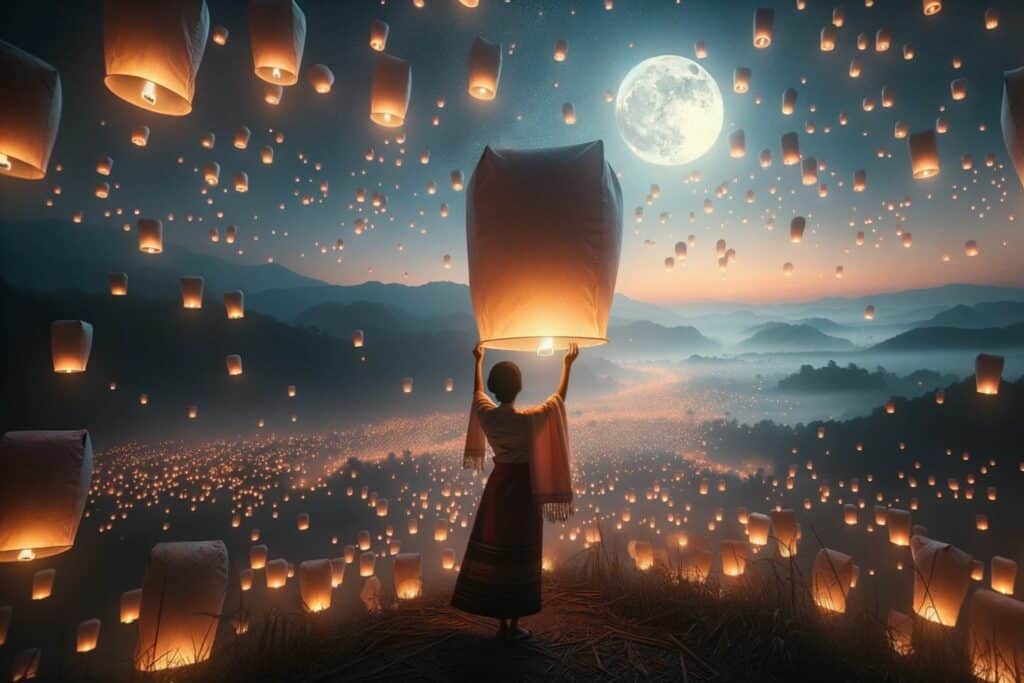
In addition to the countless illuminated lanterns, the festival features live music, street food vendors, and cultural performances. Taking part in this traditional Buddhist merit-making ceremony is a visual treat and a highlight of the many cultural festivals celebrated in Thailand. The spectacular lantern display is an iconic symbol of Thailand and a once-in-a-lifetime cultural experience.
9. Learn about the history of Sak Yant Tattoo
Sak Yant tattoos are an iconic part of Thai culture, with deep spiritual meaning and intricately beautiful designs. Sak Yant literally translates to “sacred tapping” or “blessed tattoo”, and they are traditionally done by monks, ascetics, and masters. The geometric patterns and Buddhist images are believed to impart mystical powers to the wearer, like protection, luck, and charisma.
While the most authentic way is to get a Sak Yant directly from a monk, you can also visit a professional tattoo studio for this experience. Top tattoo shops have artists well-versed in the spiritual legacy of Sak Yant and can create designs bursting with traditional Thai style.
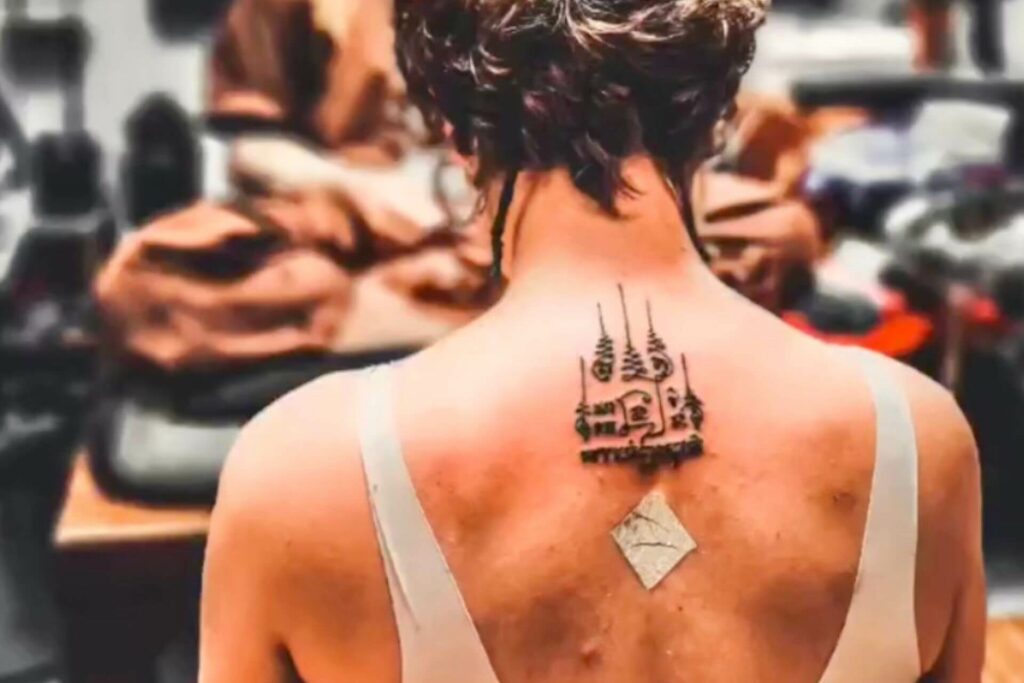
While not identical to those done in temples, Sak Yants from reputable tattoo studios still retain the energy and significance of this ancient Thai tradition. Their beauty and spirituality will stay with you forever.
10. Cruise the Floating Markets and Canals of Bangkok
For a distinctly Thai experience, cruise along the city’s network of canals to experience Bangkok’s famous floating markets. These bustling markets are located along the canal banks, with local vendors in small boats selling fresh fruits, vegetables, spices, and tasty Thai snacks. It provides an up-close look at a traditional way of life and commerce.
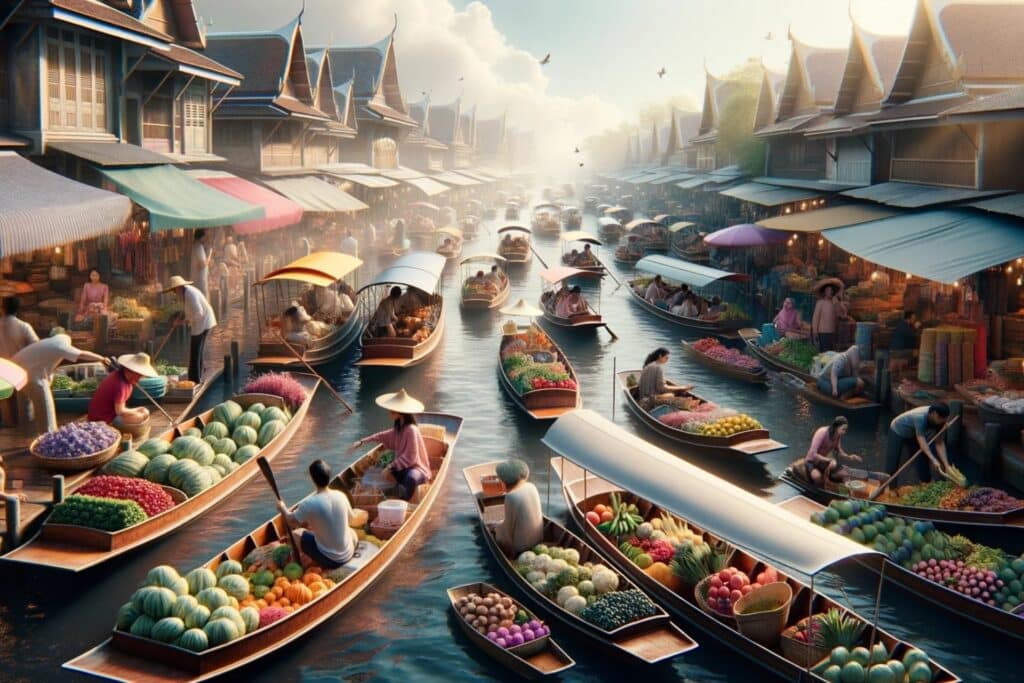
The most popular floating markets near Bangkok include Taling Chan, Khlong Lat Mayom, Amphawa, and Damnoen Saduak floating market. Wandering the crowded, vibrant scene by boat and perusing the offerings from sellers is a fun, interactive way to experience local markets and Thai river culture. Don’t forget to try delicacies sold right from the boats!
11. Marvel at the Magnificent Buddhist Temples of Chiang Mai
The over 300 Buddhist temples found in Chiang Mai showcase the superb Thai temple architecture and design found throughout the country. The old city area of Chiang Mai itself has around 30 historic and important temples that should not be missed. These include Wat Phra That Doi Suthep, the most famous, Wat Chedi Luang, Wat Phan Tao, Wat Chiang Man, and more.
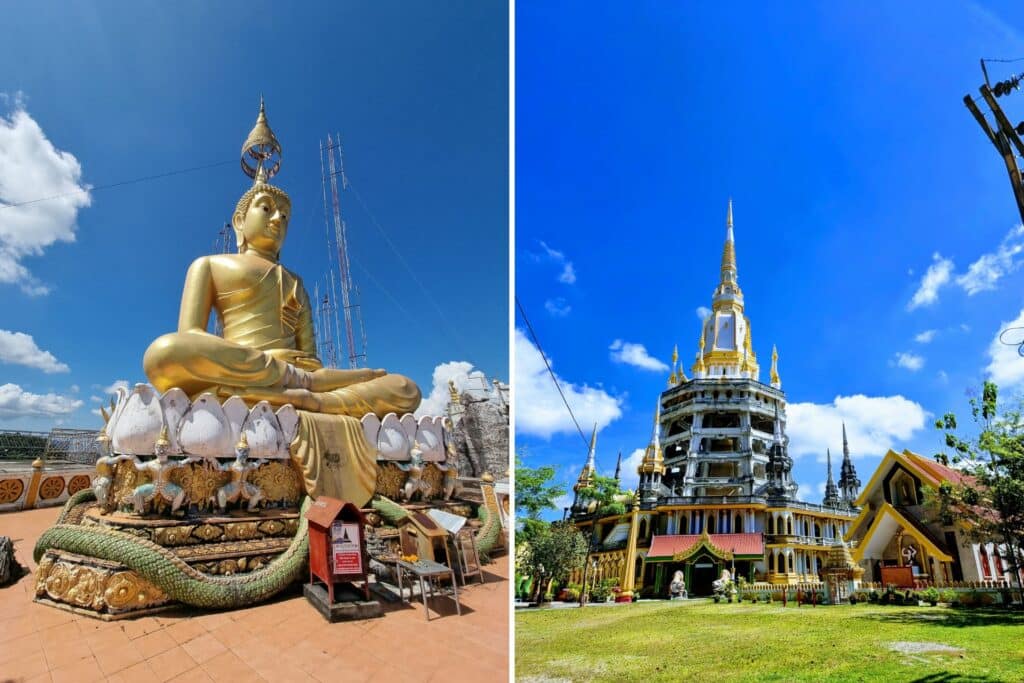
Many of these temples offer monk chats where you can talk to Buddhist monks and learn about their lives. You may also have the chance to partake in traditional ceremonies or witness locals giving alms to monks.
Visiting the impeccable northern-style temples of Chiang Mai shows the significance of Buddhism within Thai spirituality and day-to-day life.
12. Celebrate Songkran and Get Soaked in the Thai New Year
For a wet and wild cultural experience, head to Thailand on April 13-15 to take part in Songkran. This Thai New Year festival involves three days of exuberant nationwide water fights as Thais and tourists joyously drench each other with water guns, buckets, hoses, and more.
Originating as a respectful ritual of sprinkling water over elders and temples to bring good fortune, it has evolved into one of the world’s largest water parties.

Besides the water fun, Songkran is also a time for making merit at the temple, cleaning houses, enjoying delicious food, and gathering with family.
Join in the madness by celebrating on the streets of Bangkok, Chiang Mai, Phuket, and other cities. Songkran’s thrilling water-throwing activities immerse you in this famous Thai festival.
Summary of Top Cultural Experiences in Thailand
- Explore Bangkok’s ornate Grand Palace and Wat Pho complex to see Thailand’s most significant holy sites and learn about the monarchy’s role in Thai culture.
- Take a Thai cooking class and discover how to create authentic and delicious dishes like pad thai, curry, and tom yum soup.
- Wander among the temple ruins of ancient Ayutthaya, the historic capital of Siam, for insight into Thailand’s past.
- Feast on mouthwatering street food at Bangkok’s bustling day and night markets for an immersive local dining experience.
- Rejuvenate both body and mind with a soothing traditional Thai massage.
- See Muay Thai boxing matches to witness Thailand’s fiercely proud martial art heritage.
- Release paper lanterns into the sky during Chiang Mai’s enchanting Yi Peng Festival every November.
- Explore Bangkok’s floating markets and canal network by boat for a unique cultural adventure.
- Be awed by the stunning Buddhist temples found throughout Chiang Mai and Northern Thailand.
- Join the crowds in rambunctious Songkran festivities and water fights to mark the Thai New Year.
Thailand’s wealth of cultural experiences allows you to truly engage with the heritage, cuisine, beliefs, and warmth of the Thai people. The activities above enable you to gain memorable insights into what makes Thailand such a captivating country. Let your trip become an inspiring cultural journey by including some of these fabulous Thai experiences.
FAQs: Best Cultural Experiences in Thailand
What is thailand best known for culturally.
Some of the key aspects of Thai culture that Thailand is renowned for include its devotion to Theravada Buddhism, the importance placed on family and community, its distinctive cuisine, classical dance, ubiquitous massage traditions, Muay Thai martial arts, and ancient history as the kingdom of Siam.
What Should You Avoid Doing In Thailand For Cultural Reasons?
To respect Thai cultural norms, travelers should avoid public displays of affection, touching someone’s head, pointing feet at people or religious statues, wearing overly revealing clothing at temples, losing their temper, and being impatient. It is also important not to disrespect the royal family.
What is a traditional Thai greeting?
The Thai greeting called “Wai”, which involves placing palms together in a prayer-like fashion and bowing slightly, is a traditional greeting and sign of respect. Foreigners will receive smiles and a welcome when they attempt the wai themselves.
How Much Do Cultural Attractions And Activities Cost In The Land Of Smiles?
The cost of living in Thailand is quite low in general. Cultural attractions in Thailand like temples, markets, and museums generally have very low entry fees or are free. Activities like cooking classes, language lessons, and special performances cost more but are still very reasonable, usually under 1000 baht ($30 USD).
What Thai cultural souvenirs should I look to buy?
Great Thai cultural souvenirs include Thai silk, bamboo fans, nielloware bowls, celadon ceramics, umbrellas from Bo Sang, silver jewelry, miniature Thai spirit houses, carved wood items, Thai puppets, and packaged Thai herbs or spices. Most of the items above you can find in Thai markets such as Chatuchak Weekend Market in Bangkok.
What Is The Best Way To Experience Thai Culture?
The best ways to truly experience Thai culture include sampling authentic cuisine, interacting with monks at temples, visiting local markets and festivals, learning basic Thai phrases, receiving a Thai massage, and attending cultural shows. Exploring outside the major tourist hubs also provides a richer cultural experience.
Are there cultural festivals year-round in Thailand?
Many parts of Thailand have festivals and cultural traditions happening at some point year-round. However, big festivals like Songkran, Loi Krathong, and Yi Peng have set dates annually. Check an official Thai tourism calendar of events to plan your trip around specific festivals.
Apisit Chai, armed with a Master’s in Thai Studies from Chulalongkorn University, brings a wealth of knowledge about Thai history and culture to his role as Editor-in-Chief. His meticulous eye for detail and deep understanding of Thai narratives ensure that our publications are not only captivating but also rich in cultural insights, providing readers with authentic and engaging journeys through the stories of Thailand.
Similar Posts

Beginner’s Guide to Training Muay Thai in Thailand – Is the Trip Worth It?
Dive deep into training Muay Thai in Thailand. Discover the intricacies of training, the best gyms, and whether this adventure is truly worth your time and effort.

All You Need To Know Before Getting A Sak Yant Tattoo in Thailand: Traditional Tattoos By Buddhist Monks
All You Need To Know Before Getting A Sak Yant Tattoo in Thailand: Traditional Tattoos By Buddhist Monks Intricate,…
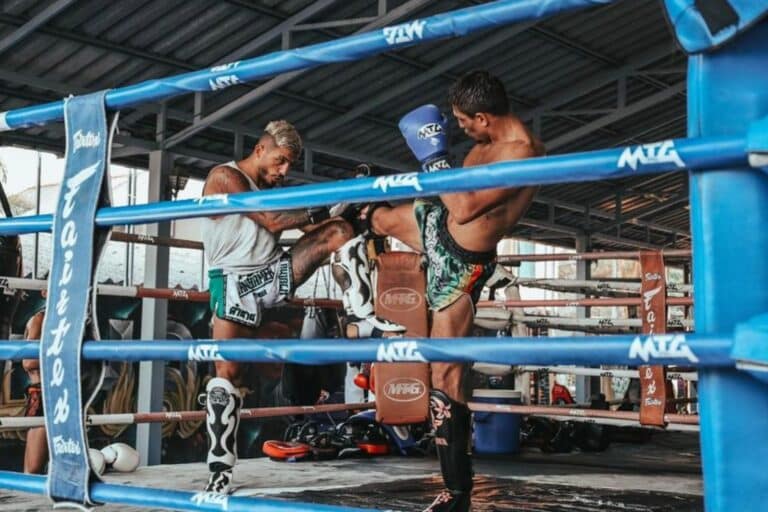
9 Best Muay Thai Gyms in Thailand for Foreigners – What to Look For
9 Best Muay Thai Gyms in Thailand for Foreigners – What to Look For As the birthplace of Muay…
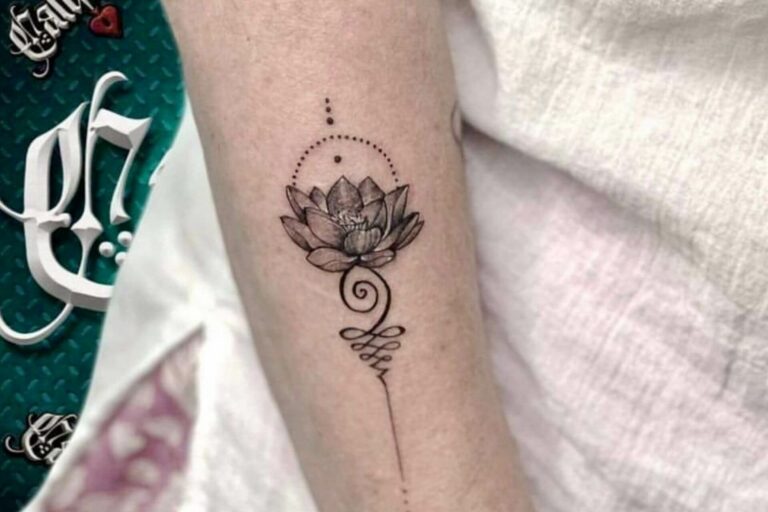
The Ultimate Guide To Getting a Tattoo in Thailand: Everything You Need To Know Before Your First Thai Tattoo
Discover everything you need to know before getting a tattoo in Thailand. From understanding the costs, hygiene standards, and traditional Thai tattoos.
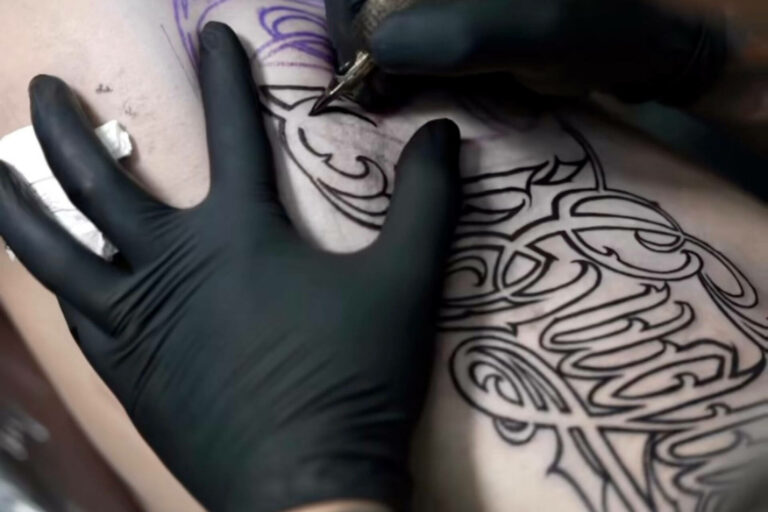
11 Best Tattoo Shops in Thailand: Top Tattoo studios in Bangkok, Phuket and Chiang Mai
This article will introduce you to the best tattoo shops in Thailand’s major cities including Bangkok, Phuket, and Chiang Mai. Dive in and find the perfect place to get inked on your next Thai adventure!
Leave a Reply Cancel reply
Your email address will not be published. Required fields are marked *
Save my name, email, and website in this browser for the next time I comment.
7 unique cultural experiences you can only do in Thailand
Recently updated on July 10th, 2023 at 02:42 pm
The enchanting Land of Smiles is absolutely packed with rich traditions and cultural heritage. From ancient Buddhist temples and spiritual ceremonies to unique floating markets, delicious cuisine and beautiful arts like silk-making, there are dozens of extraordinary cultural experiences in Thailand you can’t miss on your trip. Our Thailand cultural tours will show you some of the best, from enjoying a massage at the oldest temple in Bangkok, to meeting local palm sugar farmers and learning how to cook authentic Thai food.
1. Enjoy a Thai massage in the grounds of Bangkok’s oldest temple
View this post on Instagram A post shared by Bangkok | Features (@beautiful_bangkok)
You can’t come to Thailand without experiencing an incredible Thai massage, so we’ll take you to one of the most beautiful massage centres in Bangkok.
First, you’ll arrive at the Grand Palace, the official residence of the Kings of Siam since 1782. Here you’ll visit Wat Phra Kaew, or the Temple of the Emerald Buddha . It’s the most sacred Buddhist temple in Thailand and home to the revered image of the Emerald Buddha, made of jade and clothed in gold.
Next, you’ll wander through the Grand Palace complex to Wat Pho, the oldest temple in Bangkok. It’s famed for housing one of the largest reclining Buddhas in Thailand, standing at 15-metres high and 46-metres long.
View this post on Instagram A post shared by Official Thailand Tourism (@thailandinsider)
The temple is also the site of a traditional medicine and massage school which opened in 1955, one of the first in the country.
You can enjoy a traditional Thai massage in this historic centre – and it’s one of the most soothing cultural experiences in Thailand. With the skilled therapists working out all your travel aches, you’re sure to come away feeling like a new person!
We’ll then top off this amazing experience with a river cruise down the iconic Chao Phraya. Keep watch as we pass by the stunning Wat Arun, the Temple of the Dawn.
EXPERIENCE IT FOR YOURSELF: Treasures of Thailand
2. Explore a rural market and learn how to cook authentic Thai food
We’ll leave the gleaming skyscrapers of Bangkok behind and journey into the tranquil scenery and culture of rural Thailand. You’ll meet a Local Specialist and stop by a Buddhist temple, then visit a food market on the banks of the Tha Chin River.
The market is famed for its huge variety of fruit, vegetables and Thai snacks, and you’ll learn all about the local produce with your Thai host leading the way. You’ll even get to meet their favourite vendors in the market where they’ll buy some of the freshest ingredients for your cooking adventure later on.
Next up, you’ll sail down the river past local homes and lush jungle landscapes, before arriving at your Local Specialist’s riverside home and restaurant. Now it’s time to take to the kitchen, where you’ll learn all about the intricate flavours of Thai herbs and spices with an open-air cooking demonstration.
Once you’ve watched the master at work, you’ll get a turn at making your own authentic Thai dishes using your host’s favourite recipes. Best of all, you’ll get to sit down and enjoy the dishes you’ve prepared. Delicious!
RELATED CONTENT: 13 yummy street food dishes you must try in Thailand
3. Discover the Jim Thompson factory’s local silk-making community
View this post on Instagram A post shared by Jim Thompson Fabrics (@jimthompsonfabrics)
If you love the Thai arts, you’ll adore this visit to the local community that produces Thai silk for the famous Jim Thompson factory. We’ll take you wandering through the community passing tailor-made suit stores, along with open-air goldsmiths and silver houses. You’ll marvel at the skilled artisans colouring the silk in all kinds of brilliant colours, and weaving the delicate silk fabric into stunning garments.
You’ll also have the chance to learn the story of Jim Thompson, with a visit to the Jim Thompson House. Here, you’ll find an exquisite collection of Southeast Asian art collected by Jim Thompson himself. Plus the house is one of the most beautiful examples of traditional Thai architecture in the country.
Discover how Thompson, an American businessman, fell in love with Thailand while working there as an intelligence agent during WWII. Thompson later moved to Thailand permanently in the 1950s and started supplying fine Thai silk to international fashion houses, helping to revive the once-dying industry.
His silk company and the whole Thai silk industry still thrives today, and Thompson used the proceeds of his business for his incredible art collection, now displayed in his former home-turned-museum. Admire the antique furniture, ceramics, paintings and Buddha images, and wander through the living areas that have been preserved as they were when Thompson lived there before his mysterious disappearance in 1967.
EXPERIENCE IT FOR YOURSELF: Saigon and Bangkok Explorer
4. See the remarkable way of life at the Maeklong railway market
We’ll board a scenic train journey and rumble by lush rice paddies, arriving quite literally, into the Maeklong railway market. As one of the most thrilling cultural experiences in Thailand, you’ll soon discover how this unique market operates .
The stalls are laid out on either side of the railway tracks, but whenever the train comes through, the stalls are moved away from the railway at an astonishing speed. Once the train has passed, the stalls are just as swiftly returned – as if nothing ever happened. The whole experience will leave you scratching your head and wondering whether there was a train at all!
You’ll also get to explore the treasures of the market, before hopping on a traditional long-tail boat and cruising the small canals into the Mae Klong river. We’ll make our way to another famous Thai market – the Damnoen Saduak floating market. Here you’ll be amazed by all the boats selling fresh produce, tasty Thai food and all kinds of trinkets.
We’ll also take you to an open-air Khao Lam producer, where you’ll learn how this sweet dish is made (sticky rice with coconut cooked in a bamboo tube). You can even try out this sugary delicacy for yourself!
5. Meet a local family for a traditional Thai meal
Sampling the local cuisine is one of the very best cultural experiences in Thailand, and tasting the traditional northern food is an unmissable part of any trip to Chiang Mai. You’ll get to experience a real northern meal when you meet the Saiwangjit family and join them in their classic wooden Thai stilt house.
We’ll sit down together to enjoy an authentic, home-cooked lunch, and learn all about their life in Chiang Mai. Feeling satisfied after the delicious meal, we’ll then get to meet a local monk at Wat Suan Dok, famed for its stunning golden chedi. Here you’ll learn all about Thai Buddhism while relaxing in the temple’s tranquil grounds.
6. Explore the local markets and discover the rich history of Phuket Town
View this post on Instagram A post shared by Indulgent Eats | NYC Hong Kong (@indulgenteats)
You’ll have the special opportunity to see what Phuket is like in the early hours during a walking tour of Phuket Town with a Local Specialist. It’s one of our favourite cultural activities in Thailand, and you’ll get to explore the morning fresh food market and mingle with the locals who come here to enjoy a quick breakfast or do their shopping.
You’ll then visit the amulet market and learn how the locals wear these metal charms to bring them good luck or protect them from harm. You might even like to pick out a special amulet for yourself, before we continue on to discover the rich trading history of the island.

With a vibrant fusion of Thai, Chinese, Indian, Arabic and Portuguese influences, you’ll get to see everything from the restored shop-houses lining the streets of Old Phuket Town, to the stunning Sino-Portuguese-style colonial mansion of Baan Chinpracha. We’ll also learn about the history of Phuket at the Thai Hua Museum, before fueling up on local snacks in a beautifully restored coffee house.
EXPERIENCE IT FOR YOURSELF: Treasures of Thailand with Phuket
7. Meet a local farmer at a coconut palm sugar plantation
View this post on Instagram A post shared by #TGB • All About Thailand (@thailandguidebook)
As we cruise down the scenic Mae Klong on our way to the famous Damnoen Saduak floating market, we’ll stop by a real working coconut palm sugar plantation. You’ll get to meet the farmer and discover how he creates palm sugar by extracting the sap from the coconut palm trees and boiling it.
After all the sugary treats you’ve likely indulged in on your trip, it’s amazing to see for yourself how the local palm sugar is made. You might even like to take some home to experience the sweet taste of Thailand long after you’ve left.
Which cultural experiences in Thailand are at the top of your bucket list? Let us know in the comments below!
Want to hear more from us?
Sign up to receive inspiring travel articles, offers & news
" * " indicates required fields
Privacy Overview
Sign up for our emails.
Wander-Lush
Thailand for Cultural Travellers: 7 Unmissable Cultural Activities in Thailand
On one hand, you could argue that no one really needs to seek out cultural experiences in Thailand. Whether it’s due to religion, tradition or cuisine, everyday life is so steeped in Thai culture that experiencing it during your trip is almost automatic.
On the other hand, if you’re especially culture-minded , there’s value in proceeding mindfully before you touch down in Bangkok . For some travellers, this will involve timing your trip to coincide with once-a-year festivals , while others will simply want to save time for cooking classes or visits to agricultural venues.
No matter which of these camps you fall into – in reality, you’re probably somewhere in-between – you’re going to want to continue reading.
About the author: Robert Schrader from Thailand Starts Here is a former resident of Thailand who has traversed the Kingdom countless times. He has visited more than half of Thailand’s provinces over the past 13 years, yet he still finds new cultural experiences to enjoy on every trip.
Please note: This post contains affiliate links, meaning I may earn a commission if you make a purchase by clicking a link (at no extra cost to you). Learn more.
Why Thailand is a top destination for culture
Foreign travellers tend to love Thai cultural experiences – and many are already familiar with some of them, even before they visit the Kingdom. For example, you can find a Thai massage parlour in almost every big city in the world. Thai cuisine, whether or not you’ve learned to cook it, has become as ubiquitous as Mexican , Italian or Chinese.
There’s also the nature of Thai culture itself. Thailand is a primarily Buddhist country and, because of this, there’s a gentleness and kindness to Thai people and their traditions, starting with the Thai wai , a typical greeting that takes the form of a bow.
Thai people, for their part, are happy to share their customs and heritage with visitors , part of an innate hospitality that’s behind Thailand’s nickname, the ‘Land of Smiles’.
7 of Thailand’s most interesting cultural experiences
1. get wet at songkran.

Songkran , a festival that commemorates the Buddhist New Year, has come a long way since the tradition began in central Thailand hundreds of years ago. What began as a Buddhist ‘water throwing’ cleansing ritual has now become – at least in Bangkok’s Silom district – a raucous water gun battle.
Whether you prefer to experience the contemporary take on Songkran in Bangkok or a more tranquil, traditional version in Thailand off the beaten path , you’ll want to plan to be in the Kingdom between April 13-15, when Songkran takes place every year.
2. Learn how to cook Thai food

A huge array of cultural experiences in Thailand are associated with food, including the various cooking classes available throughout the Kingdom. Some of these take place at large, high-profile cooking schools such as the Blue Elephant , which has branches in Bangkok and Phuket.
Wondering is Phuket Thailand worth visiting for a cultural experience? Check out this guide for all the answers.
Others are lower-profile: you might notice them advertised at local eateries in Chiang Mai or Krabi. No matter which path you follow, learning to cook Thai dishes (both favourites such as Pad Thai and green curry, and local specialties such as som tam papaya salad alike) is a great way to understand (and taste!) Thai culture in a deeper way.
3. Release an offering for Loy Krathong
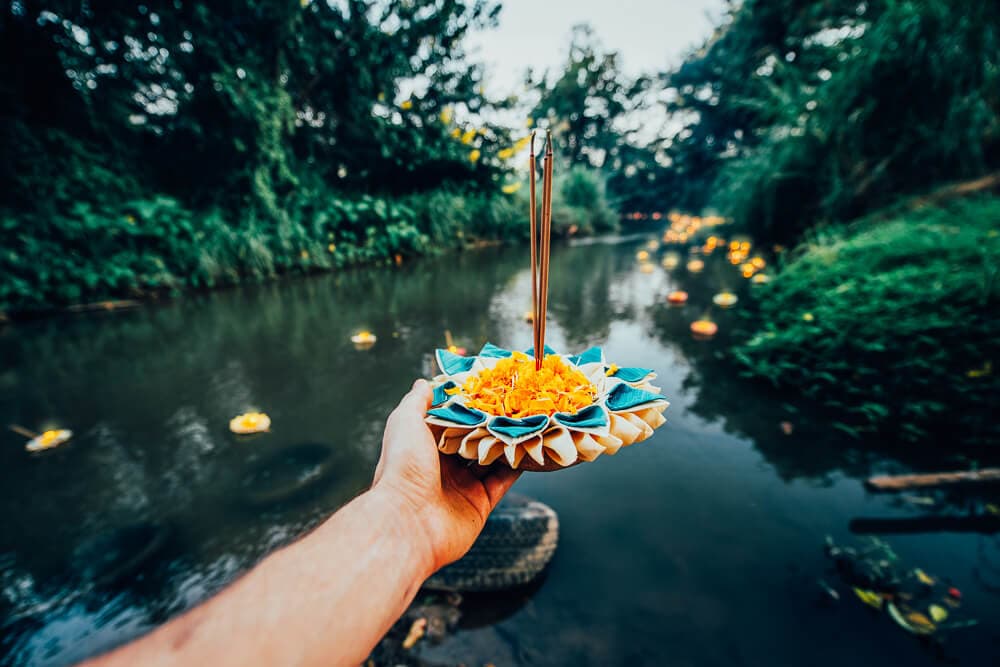
Want to experience a Thai festival, but can’t manage a trip in April? Visit instead for Loy Krathong, an equally important Thai holiday that takes place every November.
What Loy Krathong represents is open to interpretation: some see it as honouring the water goddess or the Buddha, while others view it as a general means of releasing bad energy and thoughts. No matter why you end up celebrating, you’ll do so by floating a krathong onto any nearby body of water or releasing a paper lantern into the sky – likely along with thousands of other people.
Click here to see future dates for Loy Krathong , which takes place on the full moon day of the 12th month of the Thai calendar.
4. Browse bouquets at the Bangkok Flower Market

Pak Khlong Talat in Bangkok’s Chinatown is the world’s largest 24-hour flower market. While it’s unlikely that you’ll take advantage of the late hours and visit during the middle of the night, a trip to the market is nonetheless an amazing opportunity to enjoy Thai culture, as well as to see some very gorgeous flowers and plants.
Some are ornamental or just romantic, such as cut roses or dyed carnations wrapped casually in newsprint. Others are garlands made with marigolds or jasmine and meant to be used, ultimately, in the temple or home for religious purposes.
5. Eat street food – one of the most popular cultural activities in Thailand

If you want to discover Thailand’s culture through its food but don’t want to cook while you’re on vacation, you’re in luck. Street food stalls are plentiful in every city across Thailand and especially common in big cities such as Bangkok and Chiang Mai, whose Sunday ‘walking street’ is famous all over the Kingdom.
Eating Thai street food has numerous cultural elements, whether you participate by eating a local breakfast , observe each seller’s cooking methods, or simply stop to notice the intricacies of which utensils and condiments Thai people use. You can also simply use affordable street meals to quickly, cheaply discover Thai cuisine beyond the usual suspects.
6. Visit tea and coffee farms in Chiang Rai

Another food-related cultural experience Thailand offers comes in the form of visits to its various coffee and tea farms . While you can find these all throughout the country, some of the best are in Thailand’s far north, just outside the city of Chiang Rai.
Visit coffee farms such as Doi Chaang to see the bean-to-beverage process before sitting down for a fresh brewed mug, or instead choose Chui Fong tea plantation , where you can wash down scones and cakes with locally-grown black and green teas while enjoy stunning views of seemingly endless rows of verdant tea bushes.
7. Study at a Thai language school
Thai might seem like a difficult language, particularly if you’ve never studied an Asian language before, but learning how to speak (and especially read/write!) Phasa Thai provides a truly beautiful window into Thai culture.
While some schools offer very short-term courses you can take while in Thailand on a tourist visa, others offer longer and more in-depth courses, which will require you to convert your tourist visa into an education visa. This latter option can be a golden opportunity if you want to experience what might just be the ultimate way to get into Thai culture: Living in Thailand!
Everyday Cultural Experiences in Thailand
Don’t have time off during any of the festivals listed above, or don’t have space in your itinerary for cooking classes or coffee farm visits? No worries! It’s easy to experience Thai culture without much disruption to your travel.
This can be as simple as taking a stroll around the local fresh market in the neighbourhood where you’re staying, walking into a massage parlour and booking a 30-minute foot rub, or finding a nearby Muay Thai gym to learn more about Thai boxing and its cultural importance.
Other Thailand cultural experiences are as functional as they are fun. For example, when you’re exploring Bangkok’s old city of Rattanakosin, hop on a tuk-tuk auto rickshaw to zip between temples and palaces.
Or, when visiting Thai shops or restaurants, use simple Thai phrases like sawasdee (which means “hello”) or kob khun (which means “thank you”), which will be sure to get you a famous ‘Thai smile’ in return.
Other FAQ about Thai cultural travel
How do you experience thai culture.
You can experience Thai culturally as casually or intentionally as you’d like. On any given day in Bangkok, for example, you can wake up early and head out to the street to watch monks collect alms or offerings from faithful Buddhists.
Alternatively, you can specifically plan your trip to coincide with a festival such as Songkran, the Thai new year.
What are some cultural traditions in Thailand?
Thailand’s cultural traditions range from the everyday to the extraordinary. For example, Thai greetings such as the wai (bow) and the famous Thai smile are touches of Thai culture that perfume almost every interaction you’ll have with a Thai person.
Booking a Thai massage or travelling to Thailand during the annual Loy Krathong festival, meanwhile, will ensure you enjoy an even more unique and singular cultural experience when visiting Thailand.
What is Thai culture known for?
Thai culture is known for its hospitality, as well as for how open it is to foreigners who are curious to discover. Unlike some people who are protective of their traditions and cautious about sharing them, Thais invite visitors from other countries to enjoy and even partake in local culture, from simple applications like cooking classes and tea plantation visits, to more involved experiences like intensive Muay Thai boxing courses.
The Bottom Line
Enjoying cultural experiences in Thailand is sometimes a matter of osmosis and other times a matter of planning, but usually ends up falling somewhere between the two.
For example, you could plan to visit the Kingdom in November so that you can attend Loy Krathong in Chiang Mai , then accidentally happen upon a massage shop or night market in the vicinity of your hotel.
Indeed, regardless of how you find culture as you explore Thailand, one thing is for certain: Cultural experiences will define your adventure, both as you travel and in retrospect, when you look back on your trip.
You might also be interested in…
- The world’s best cultural tourism destinations
- Local culture in Luang Prabang, Laos
- Penang, Malaysia cultural travel guide
- How to immerse yourself in Burmese culture
- Singapore traditions for travellers
- A cultural traveller’s guide to Sri Lanka
Leave a Reply Cancel reply
Your email address will not be published. Required fields are marked *
- Subscribe to future posts
- Search Please fill out this field.
- Manage Your Subscription
- Give a Gift Subscription
- Sweepstakes
20 Best Places to Visit in Thailand — From the Country's Oldest National Park With Secret Waterfalls to Stunning Islands With Excellent Diving
There's no shortage of beautiful places to visit in Thailand.
:max_bytes(150000):strip_icc():format(webp)/IMG_9924-Meagan-Drillinger-2000-b5b1ef20b8b940e397c81373504ecbed.jpg)
EPasqualli/Getty Images
Thailand is so much more than a travel destination — visiting is a bona fide rite of passage. From hostel-hopping backpackers to well-heeled five-star hotel aficionados, there’s something for everyone in “The Land of Smiles.”
My most recent trip to Thailand was in early 2022, when the country implemented strict entry requirements due to the COVID-19 pandemic. At the time, I was one of a few hundred thousand tourists who were allowed into the country, and it felt like I had many of the typically crowded attractions all to myself.
The beauty of Thailand is that it will show you different sides of itself no matter how many times you visit. From the idyllic white-sand beaches and palm-fringed islands in the south to the misty hillsides and temple-peppered mountains of the north, the rattle and hum under neon lights of nonstop Bangkok, and the ruins of ancient cities surrounded by jungle, Thailand never disappoints.
So, what are the best places to visit in Thailand? I reached out to a Thailand travel expert and threw in a bit of my own first-person experience to help you narrow down this ever-growing list.
Tessa Desjardins/Travel + Leisure
For most travelers, an adventure in Thailand will likely kick off in the nonstop, energetic capital city, Bangkok. A dizzying destination and one of my favorite international cities, Bangkok is full-on sensory overload — but in the best way. Dig into sizzling street food; meander back alleys and bustling thoroughfares in search of small markets, shops, and hidden temples; cruise along the Chao Phraya River, and grab a cocktail at the dozens of sky-high rooftop bars.
Tip: Book a room at the Capella Bangkok or Mandarin Oriental, Bangkok — two iconic luxury hotels with stunning locations perched on the Chao Phraya River.
IronHeart/Getty Images
Second to Bangkok on most visitors’ lists is the northern city of Chiang Mai. Many travelers even prefer Chiang Mai to Bangkok for its relatively slower pace of life. The spectacular city is bursting with temples (Wat Phra That Doi Suthep is a must) and humming with restaurants and bars.
"I would say for anybody, whether it's their first time or a repeat trip to Thailand, if you have been there or you haven't, [you have to visit] Chiang Mai," said Grant Ekelund , Travel + Leisure A-List advisor and senior travel consultant and Asia specialist at InsideAsia. "It's such a neat city. It’s one of those destinations that has something for everyone … Are you a foodie? Do you want to hike? See cool temples? Have amazing trekking opportunities? It can all be done [here], and it slots into any itinerary perfectly."
Koh Phi Phi
Thailand has more than 1,400 islands scattered around its coastline, but few are as famous or iconic as the Phi Phi Islands in the Andaman Sea. Comprising two islands — Phi Phi Don and Phi Phi Leh — Koh Phi Phi is known for its natural beauty, excellent diving, and raucous party scene. For the latter, Phi Phi Don is the most famous. Phi Phi Leh, meanwhile, is uninhabited and beloved by those looking to disappear into nature. It was blasted into the public eye about two decades ago, when Leonardo DiCaprio's character went in search of an island paradise in the film "The Beach," which is set in real-life Maya Bay.
Alexander Spatari/Getty Images
While we’re on the topic of Koh Phi Phi, we’d be remiss not to mention Krabi province as a whole. Located in southern Thailand, bordering the Andaman Sea, Krabi is home to many of the beautiful beaches and islands that make Thailand famous.
"I've been booking many [trips to] Krabi lately," said Ekelund. "It ticks a lot of boxes for people. You've got the beauty, cool cliffs, and interesting geology. It has a beach, but it's for people who don't want to simply park it on the sand for 10 days. Krabi offers activities and more." Some highlights include the beach town of Ao Nang, as well as islands like Phuket, Koh Lanta, Koh Yao Yai, Koh Lipe, Railay Beach, and several national parks.
Koh Yao Noi
Sunphol Sorakul/Getty Images
My first trip to Thailand was to the small island of Koh Yao Noi back in 2013. One of the most beautiful islands in Phang Nga Bay, Koh Yao Noi is flecked off the coast of its sibling island, Koh Yao Yai. Sandy beaches and small fishing villages comprise most of the land here, along with the luxe Six Senses Yao Noi resort tucked along the eastern coast. The property’s infinity pool is legendary for its explosive sunrise views that blur the distinction between the sky and sea.
pratan ounpitipong/Getty Images
Many Thai cities have the ability to make visitors feel like they’re stepping back in time. But few create the illusion as vividly as Ayutthaya. Once the capital of the Kingdom of Siam, the ruins of Ayutthaya are breathtaking and hauntingly beautiful. It’s only an hour from Bangkok, making it an easy day trip or a great overnight excursion.
Boyloso/Getty Images
Sukhothai is another beautiful ancient city. "Sukhothai is for people who like history. I was taken by how beautiful the area is and how extensive the ruins are," said Ekelund. "We cycled around the ruins with a guide and got a great sense of the history. Sukhothai is much more rural and harder to reach, meaning it has fewer tourists. You also don't have a city built up around it."
Mae Hong Son Loop
Piriya Photography/Getty Images
Of all the places I've visited in Thailand, none stick with me as much as the Mae Hong Son Loop. This 300-mile route is most often tackled by travelers on the back of motorbikes looking to brave the mountain switchbacks that descend into the thick jungle and pass from small village to small village. It's not a journey to be taken lightly — motorbike experience is strongly recommended — but those who make the trip are rewarded with spectacular scenery and access to remote communities.
Khao Yai National Park
Bunphot Phairoh/500px/Getty Images
Thailand has more than 100 national parks. The oldest is Khao Yai National Park, which also happens to be the country's third-largest. Within the park lies a web of hiking trails, secret waterfalls, and herds of elephants.
"Khao Yai has a lot of bat caves, too, which is one of the coolest things I've ever experienced," said Ekelund. "I stood there for 30 minutes while an unending stream of bats flew over my head. It was all so beautiful. It's a beautiful park with waterfalls, trekking, and hiking. Plus, it's just a couple of hours [by car] from Bangkok."
wichianduangsri/Getty Images
Approximately two hours southeast of Chiang Mai is the city of Lampang. Much like many large cities in Thailand, Lampang has its fair share of temples, street food, and markets. But unlike the others, it feels like a place where time has stood still. Just listen for the sound of clip-clopping horse carts, still used for transportation, and you'll understand what I mean. Because of Lampang's integral role in the teak trade, many migrants from Myanmar made this northern city home, and you'll find teak mansions and Burmese-style temples everywhere.
fokkebok/Getty Images
Chiang Rai, a northern Thai city, is often glossed over as most visitors opt to stop in Chiang Mai instead. "I am always struck by how chill Chiang Rai is," said Ekelund. "It's a relaxing place to be and has cool stuff to do. It's a great city to walk through the neighborhoods and see people living their daily lives. I enjoyed the mountains, nearby villages, and opportunities for cultural exchange."
Jackyenjoyphotography/Getty Images
No list of best places to visit in Thailand would be complete without Phuket. While Phuket has a reputation for being crowded with resort after resort, the truth is it’s for a reason — the island is a beautiful place to be. Thailand's largest and most easily accessible island brings visitors in by the millions each year for its wide array of hotels, white-sand beaches, parties in Patong, colorful snorkeling, and eclectic culinary scene.
Oleh_Slobodeniuk/Getty Images
Thailand’s second most popular island sits off the country’s eastern coast in the Gulf of Thailand. Koh Samui is wreathed in bone-white sandy beaches, peppered with temples, veined with hiking trails, and splashed with fabulous resorts and energetic beach towns and villages.
"It's hard to beat Koh Samui. It's just beautiful," said Ekelund. "If you want easy access without a full resort stay, I recommend Anantara Bophut . You can walk to Fisherman's Village, and you won’t feel like you're 'stuck' at a resort. If you want a full resort experience, I like Banyan Tree Samui for its private beach and spectacular rooms."
Cavan Images/Getty Images
The tiny island of Koh Tao, located in the Gulf of Thailand and not too far from Koh Samui, is one of the country’s best locations for diving and snorkeling. In fact, most avid divers will tell you that Koh Tao is their destination of choice in Thailand. The palm-fringed island is best known for its abundance of sea turtles.
Kanchanaburi
Thanit Weerawan/Getty Images
Shrouded in thick jungle and sliced by miles of track belonging to what was once known as the “Death Railway,” Kanchanaburi has a dark and tragic history. The infamous train route, which crosses the River Kwai, was built from 1940 to 1943 by prisoners of war taken by the Japanese in World War II. Today, only a small section of the rail route is open and takes travelers on a journey through the mountain cliffs and bamboo forests of Kanchanaburi. "If you're into history, beautiful vistas, trains, and wildlife, you can get all of that in Kanchanaburi. It's a place not many tourists go, either, so it has a lot to offer," said Ekelund.
Tieu Bao Truong/Getty Images
Trang is the province directly south of Krabi, which means it has the same beautiful stretch of Andaman Sea coastline, except with a fraction of the crowds. There’s no shortage of islands to explore around Trang, like Koh Kradan and Koh Muk. Koh Muk's crown jewel is the secret Emerald Cave, which can be entered via a dark tunnel that leads to a protected beach surrounded by towering limestone cliffs.
Pierrick Lemaret/Getty Images
Located in the province of Phang Nga, Khao Lak can be thought of as Phuket’s much quieter cousin. Less than two hours from Phuket International Airport, Khao Lak is home to miles of sprawling, empty beaches, plus it offers easy access to beautiful national parks.
"I've been hyping Khao Lak quite a bit for people who want something quieter," said Ekelund. "You have easy access to the Phuket International Airport, but it's much more chill than the other Andaman Islands. It has beautiful beaches, good infrastructure, a great spot for dining, and it’s not hard to get to."
Inigo Arza Azcorra/Getty Images
Whether or not you drive the Mae Hong Son Loop, you’ll want to stop in Pai when visiting northern Thailand. Once a sleepy community of expats, Pai has morphed into a must-visit backpacker destination. Visitors will find funky cafes and coffee shops, endless bars, guest houses, hostels, and a dispensary or two, particularly now that cannabis is no longer considered a narcotic in the country.

Khao Sam Roi Yot National Park
awaywithtrex/Getty Images
South of Bangkok, the province of Prachuap Khiri Khan is best known for the glamorous, frenetic beach town of Hua Hin. The province runs down the skinny arm of the country, bordering the Gulf of Thailand on one side and Myanmar on the other. Here’s where you'll find Khao Sam Roi Yot National Park, Thailand's first marine national park. The park's top attractions include a series of spectacular caves and a sprawling freshwater marsh. Visitors can enjoy the park’s beaches, islands, walking trails, and thick mangrove forests. It’s just an hour from Hua Hin and about 3.5 hours from Bangkok.
4FR/Getty Images
This long, skinny island, also in the province of Krabi, flies under the radar, but it’s one of my favorite places in the country. Koh Lanta is home to beautiful beaches, great restaurants, and the Mu Ko Lanta National Park, an amazing spot for diving and seeing undeveloped beaches.
- Testimonials

0084 983 787 868
Viber Available
[email protected]
Send us an e-mail
Culture in Thailand: What You Need to Know Before You Visit
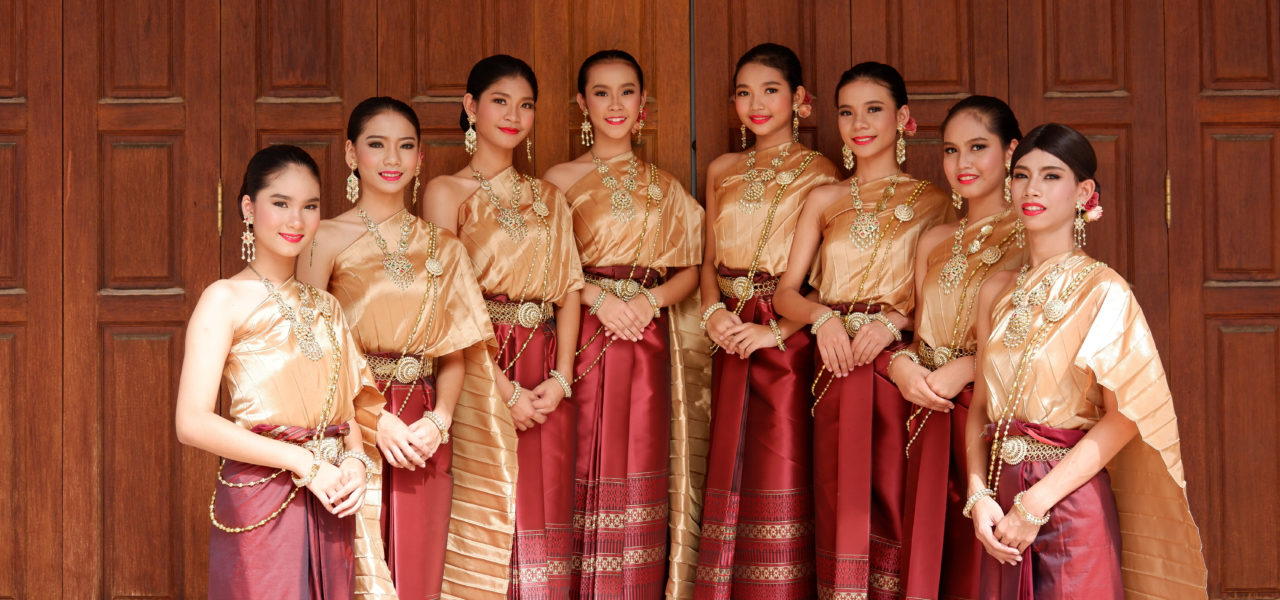
Thailand is a country with a rich and diverse culture that attracts millions of visitors every year. The culture in Thailand is a mix of strong Indian influences, Chinese traditions, and elements that are uniquely Thai. With its diverse geography, friendly people, and stunning scenery, the “Land of a Thousand Smiles” is a must-see destination in South East Asia.
Thai People and Society
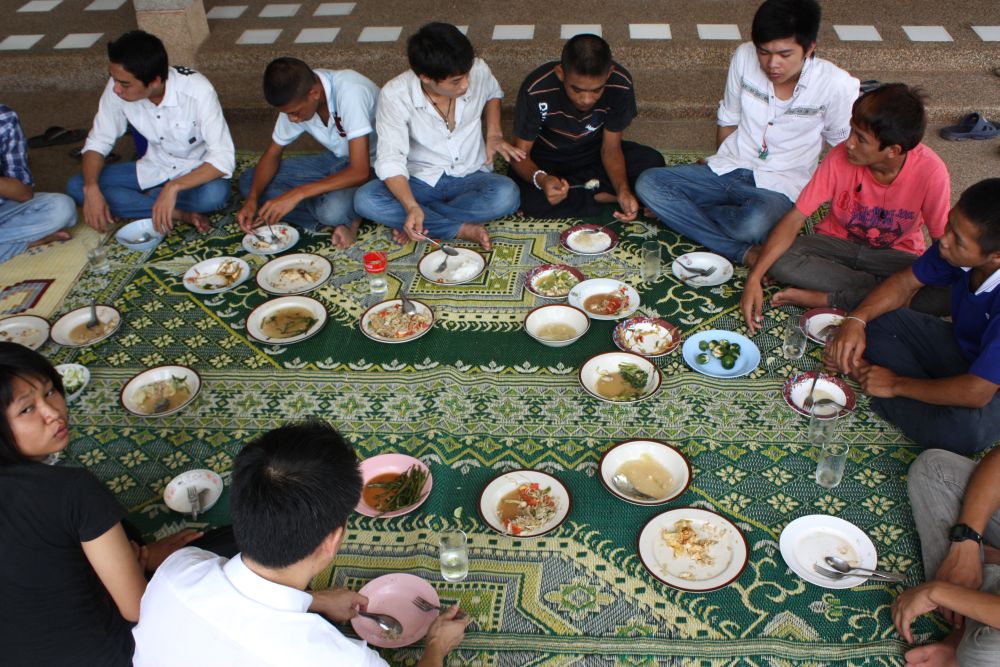
The Thai people are the largest ethnic group in Thailand and make up over 80% of the population. They are believed to have migrated from southern China to the area that is now Thailand more than a thousand years ago. Over the years, the Thai people have developed a rich cultural heritage that is reflected in their customs and traditions.
Thailand is a hierarchical society, with a strong emphasis on respect for authority and social status. The concept of "face" (saving face or losing face) is important in Thai culture, and it's considered impolite to criticize or confront others in public. Thai people are generally polite, friendly, and hospitable, and they place great value on maintaining harmony in social interactions.
Family is a cornerstone of Thai society, and the extended family is often involved in decision-making and child-rearing. Elders are highly respected and are expected to be cared for by their children in their old age. Thai families also tend to be close-knit and supportive of one another.
Community is also an important aspect of Thai society, and people often identify with their region or hometown. Rural communities, in particular, have a strong sense of community and are known for their close-knit relationships.
In terms of social customs and traditions, Thai people typically greet each other with a wai, a gesture of respect that involves placing the palms together at chest level and bowing the head. Gift-giving is also an important part of Thai culture, and it's customary to bring small gifts when visiting someone's home or attending a social event.
Overall, Thai society is characterized by a strong emphasis on respect, harmony, and social cohesion. Understanding these cultural norms is key to building positive relationships with Thai people and navigating the intricacies of Thai society.
In Thailand, family takes precedence, and there is a greater emphasis placed on the extended family than in western countries. The large number of siblings a Thai person may have is often due to the inclusion of cousins, as there is no word for "cousin" in Thai, and they are referred to as brothers and sisters.
Extended families tend to reside in close proximity, and many Thais maintain strong connections to their hometowns, even if they relocate for work. It's not uncommon for children to be raised by grandparents, aunts, or uncles if their parents work elsewhere. The younger generation is expected to contribute to the care of older family members, whether financially or by performing household tasks.
Religion in Thailand
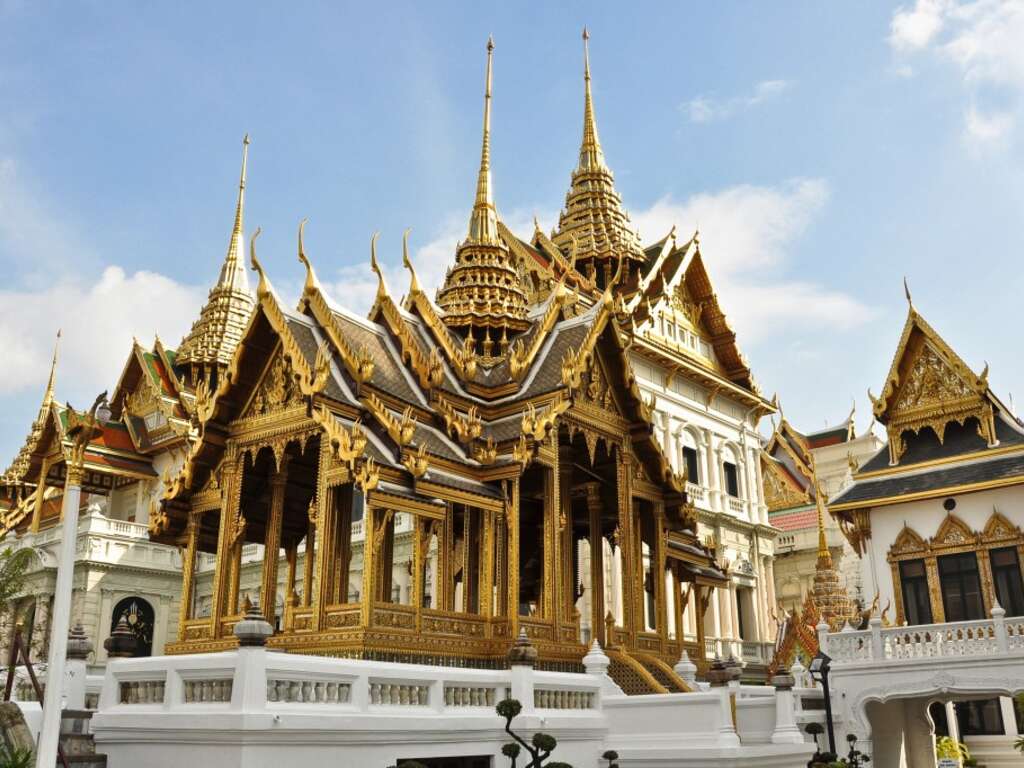
Religion is a significant aspect of Thai culture, with Buddhism being the predominant religion, practiced by over 90% of the population. The Theravada branch of Buddhism, which emphasizes personal spiritual development and meditation, is particularly prominent. Buddhism in Thailand is considered a philosophy of life, and its influence can be seen in everyday routines and practices. The Sangha, or monastic community, is an essential institution in Thailand, providing education and a way for laypeople to accrue good karma. Aside from Buddhism, other religions are also present in Thailand, such as Islam, Christianity, Sikhism, and Hinduism. While over 93% of the Thai population practices Buddhism, the country recognizes and respects other religions. Muslims, who are mostly of Malay origin, reside mainly in southern Thailand, while Christians and Hindus make up smaller portions of the population. Incorporating elements of Animism and Hinduism, Buddhism in Thailand displays unique features such as the widespread use of spirit houses and other religious practices. Many homes and public buildings feature a "spirit house" or "san phra phum," which is a small shrine where people can leave offerings to honor the spirits believed to dwell in the land. Thai Buddhist monks, or "bhikkhus," are highly respected and play a crucial role in the community. They live in monasteries, or "wat," and follow strict rules regarding their clothing, behavior, and diet. It is common for Thai men to spend some time living as a monk, particularly before getting married or pursuing a career. Religious customs and traditions are evident in various aspects of daily life in Thailand, from traditional architecture to cultural events and festivals. There are many religious festivals and ceremonies throughout the year, which often involve elaborate processions, music, and dancing. Some of the most famous include Songkran, the Thai New Year, and Loy Krathong, the Festival of Lights, which feature floating lanterns and offerings on waterways throughout the country. Overall, religion is an essential component of Thai culture, shaping the country's customs and traditions, and providing a deep sense of meaning and purpose to the lives of many Thais. The diverse religious landscape in Thailand reflects the country's rich history and cultural heritage, and its people's openness and respect towards various faiths.
The Influence of Buddhism and Hinduism on Thai Culture
Buddhism and Hinduism are the two major religions in Thailand, and they have had a profound influence on Thai culture.
- Buddhism is the dominant religion in Thailand, with over 95% of the population identifying as Buddhist. Buddhism teaches the importance of non-violence, compassion, and wisdom. These values are reflected in many aspects of Thai culture, such as the emphasis on politeness and respect for elders. Buddhism also plays a central role in Thai festivals and ceremonies.
- Hinduism has had a significant influence on Thai culture, even though it is not the majority religion. Many Hindu deities and symbols are found in Thai art, architecture, and literature. The Thai national epic, the Ramakien, is based on the Hindu epic the Ramayana. Hindu beliefs about karma and reincarnation are also found in Thai folk religion.
Here are some specific examples of the influence of Buddhism and Hinduism on Thai culture:
- Art and architecture: Thai art and architecture is heavily influenced by both Buddhism and Hinduism. Many Thai temples are decorated with images of Buddha, Hindu deities, and other religious motifs. The Wat Pho temple in Bangkok is home to a giant reclining Buddha statue, and the Wat Arun temple is known for its intricate mosaics.
- Festivals: Many Thai festivals are influenced by Buddhism and Hinduism. The Songkran festival, which is celebrated in April, is a water festival that marks the beginning of the Thai New Year. The Loy Krathong festival, which is celebrated in November, is a festival of lights that honors the water spirits.
- Beliefs and practices: Thai beliefs and practices are also influenced by Buddhism and Hinduism. For example, many Thai people believe in karma and reincarnation. They also believe in the importance of merit-making, which is the act of doing good deeds in order to improve one's karma.
- Religion: Buddhism was born in ancient India in the 6th century BC before spreading across much of Asia. Today, over 95% of Thailand's population practice Theravada Buddhism, which has become integrated with folk religion and Chinese religions. Buddhism is also evident in the architecture and art of Thailand, with more than 40,000 temples across the country. Hinduism has also made important contributions to Thai culture, especially in the fields of literature, dance, and drama. The Ramakien, the national epic of Thailand, is based on the Hindu Ramayana of India. Hindu-Buddhist deities are worshiped by many Thais, such as Brahma, Ganesh, Indra, and Shiva.
- Ceremonies: Many of the ceremonies that are important to Thai culture have been adopted from Indian traditions, including ceremonies of marriage, ordination, merit making, and cremation. Thai culture's biggest inspiration comes from the Lord Buddha but is also influenced by Hindu deities and Hindu ceremonial rites, particularly those concerned with royal ceremonies. The monarchy and the royal family play a significant role in Thai culture and politics. The king is revered as the head of state and the protector of religion and the people. The royal family is involved in many social and charitable projects, as well as promoting Thai culture and heritage.
- Food: Although Thailand has its own unique cuisine which is comprised of sweet, sour, bitter, salty, and spicy flavours, it has evolved from Indian and Chinese influences. The influences of foreign trade played a vital role and it is believed that Buddhist monks from India originally brought the curry to Thailand. The most popular curries today are the masaman curry which contains dried spices, including cinnamon and nutmeg, and yellow curry which is infused with turmeric, cumin, ground coriander seed and chili powder.
- Language: The Thai language was created by King Ramkhamhaeng the Great by modelling it on ancient Indian Sanskrit and Pali alphabets. The Thai language was also strongly influenced by Khmer, Malay, English, and Chinese. After developing over the past 700 years, the Thai alphabet consists today of 44 characters. Thai is a tonal language, saying the same word in a different tone has a different meaning.
- Literature and Dance: The Thai national epic, the Ramakien, is based on the Hindu epic the Ramayana. The Ramakien tells the story of Rama, a prince who is exiled from his kingdom and must fight to reclaim his throne. The story is full of adventure, romance, and moral lessons.Traditional Thai literature and drama have been heavily influenced by the arts and legends of India. Historically Thai literature was only concerned with a few subjects; with religion, royalty and aristocracy, before a shift where prose became one of the preferred forms of writing. The Ramakien is one of the most important Thai literary pieces which was derived from the Hindu epic Ramayana of India. Both the 'Khon' and 'Lakhon' classical Thai dances also draw inspiration from the Ramakien.
As you can see, Buddhism and Hinduism have had a profound influence on Thai culture. These religions have shaped the way Thai people think, act, and celebrate.
Buddhism in Thai Culture
Buddhism is a major influence on Thai culture, as it is the official religion of the country and practiced by more than 95% of the population. Buddhism in Thailand is mainly of the Theravada school, which emphasizes the teachings of the historical Buddha and the attainment of enlightenment. Buddhism in Thailand has also incorporated elements of folk religion, Chinese religions, and Hinduism over the centuries. Here are some of the ways that Buddhism shapes Thai culture:
- Temples: Thailand is home to over 40,000 Buddhist temples, which are known as wats. They are the centers of religious and social life for many Thais, who visit them regularly to pray, make merit, meditate, receive blessings, and participate in festivals. Temples are also places of learning, where monks teach the Buddhist scriptures and moral precepts. Temples are also architectural and artistic marvels, with elaborate designs, statues, paintings, and stupas that reflect the Buddhist cosmology and history.
- Monks: There are about 300,000 monks in Thailand, who are highly respected and revered by the lay people. Monks follow a strict code of conduct, which includes celibacy, poverty, and non-violence. They also practice meditation and study the Buddhist texts. Monks depend on the donations of food and other necessities from the lay people, who in turn receive merit and spiritual guidance from them. Every Thai male is expected to ordain as a monk for a period of time in his life, usually before he turns 20. This is seen as a way of repaying one's parents for their kindness and gaining moral and spiritual maturity.
- Ceremonies: Many of the ceremonies that are important to Thai culture have been influenced by Buddhism, such as weddings, funerals, ordinations, merit-making, and festivals. Some of the most famous Buddhist festivals in Thailand are Songkran (the Thai New Year), Loy Krathong (the festival of lights), Vesak (the celebration of Buddha's birth, enlightenment, and death), Asalha Puja (the commemoration of Buddha's first sermon), and Uposatha (the observance days). These ceremonies often involve rituals such as offering flowers, incense, candles, food, and water to the Buddha images or monks; chanting prayers and sutras; listening to sermons; giving alms; releasing animals; and performing acts of generosity and kindness.
- Values: Buddhism also influences the values and attitudes of Thai people, such as respect for elders, gratitude for parents, compassion for all living beings, generosity for the needy, humility for oneself, tolerance for diversity, harmony for society, and detachment from worldly pleasures. Buddhism also teaches the concepts of karma (the law of cause and effect), rebirth (the cycle of birth and death), samsara (the realm of suffering), nirvana (the state of liberation), anatta (the doctrine of no-self), anicca (the impermanence of all phenomena), and dukkha (the unsatisfactoriness of existence). These concepts help Thais understand their place in the world and cope with the challenges and uncertainties of life.
Hinduism in Thai Culture
One of the most prominent influences on Thai culture is Hinduism, which arrived in Thailand between the 6th and 12th centuries CE, along with the expansion of the Khmer Empire from present-day Cambodia. Hinduism is one of the oldest religions in the world, originating from ancient India. It is a complex and diverse system of beliefs, practices, and traditions that worship a multitude of gods and goddesses, such as Brahma, Vishnu, Shiva, Ganesha, Lakshmi, and Saraswati.
Although Thailand is predominantly a Buddhist country today, with over 95% of the population following Theravada Buddhism, Hinduism has left a lasting impact on many aspects of Thai culture, such as art, architecture, literature, language, ceremonies, and values. Here are some of the ways that Hinduism has shaped Thai culture over the centuries:
- Art and Architecture: Thailand is home to many stunning temples, palaces, monuments, and sculptures that reflect Hindu influences. For instance, the Grand Palace in Bangkok features statues of Hindu giants (yakshas) guarding the gates. The Phanom Rung temple in Buriram province is a Khmer-style temple dedicated to Shiva, the god of destruction and regeneration. The temple is built to represent Mount Kailash, the sacred mountain of Hinduism. The temple also features reliefs and statues of other Hindu deities, such as Ganesha, Vishnu, Brahma, and Durga. Another example of Hindu-inspired architecture is the Erawan Shrine in Bangkok, which houses a four-faced statue of Brahma (Phra Phrom), the god of creation. The shrine is a popular destination for both locals and tourists who seek blessings and make offerings to the god.
- Literature and Drama: Thailand's national epic, Ramakien, is based on the Hindu epic Ramayana, which tells the story of Rama, an incarnation of Vishnu, who rescues his wife Sita from the demon king Ravana. The Ramakien was adapted by Thai kings and poets to suit the local culture and context. The Ramakien is also the main source of inspiration for classical Thai dance and drama forms, such as khon and lakhon. These forms use elaborate costumes, masks, gestures, and music to portray the characters and events of the epic. The Ramakien is also depicted in mural paintings that adorn many temples in Thailand.
- Language: The Thai language was influenced by Sanskrit and Pali, two ancient languages of India that are used in Hindu scriptures and Buddhist texts. Many Thai words have Sanskrit or Pali roots or are borrowed directly from these languages. For example, the word for king in Thai is raja (from Sanskrit raja), the word for teacher is ajan (from Pali acariya), and the word for elephant is chang (from Sanskrit gaja). Some Thai names are also derived from Sanskrit or Pali names of Hindu gods or characters. For example, Narai (from Vishnu), Isuan (from Shiva), In (from Indra), and Phikanet (from Ganesha).
- Ceremonies: Many Thai ceremonies have been influenced by Hindu rituals and traditions. For example, weddings in Thailand often involve the exchange of garlands (malai) between the bride and groom, which is a symbol of love and respect in Hindu culture. Another ceremony that has Hindu origins is the ordination of Buddhist monks (buddhasikkha), which involves shaving the head and eyebrows of the novice monk as a sign of renunciation. This practice was adopted from the Hindu custom of tonsure (mundana), which is performed as a rite of passage or purification. Furthermore, some Thai festivals have Hindu elements or are derived from Hindu festivals. For example, Songkran , the Thai New Year festival celebrated in April , involves splashing water on each other as a way of cleansing and blessing. This festival is similar to Holi , the festival of colors celebrated by Hindus in March .
- Values: Hinduism also influences some of the values and attitudes of Thai people. For instance, respect for elders , gratitude for parents , compassion for all living beings , generosity for the needy , humility for oneself , tolerance for diversity , harmony for society , and detachment from worldly pleasures are some of the values that are shared by both Hinduism and Buddhism. Moreover, some concepts that are central to Hindu philosophy , such as karma (the law of cause and effect), rebirth (the cycle of life and death), samsara (the realm of suffering), nirvana (the state of liberation), anatta (the doctrine of no-self), anicca (the impermanence of all things), and dukkha (the dissatisfaction or suffering that arises from attachment) are also adopted by Buddhism and influence the worldview of Thai people.
Literature in Thai Culture
Literature is an important aspect of Thai culture, as it reflects the history, values, and identity of the Thai people. Thai literature has been influenced by various sources, such as Indian, Chinese, and Western cultures, as well as indigenous beliefs and traditions. Thai literature can be divided into four main periods: Sukhothai, Ayutthaya, Thon Buri, and Rattanakosin.
Sukhothai Literature (1238-1377)
The Sukhothai period is considered the first golden age of Thai literature, as it witnessed the emergence of a distinctive Thai language and script. The literature of this period was mainly written in stone inscriptions, which provide vivid accounts of the contemporary life, politics, and religion. The most famous of these is the Ramkhamhaeng inscription of 1292, in which King Ramkhamhaeng records the economic abundance of his kingdom and the benevolence of his rule.
The Sukhothai period also produced some of the earliest examples of poetry in Thai, such as rai (rhymed verses), khlong (couplets), and kap (quatrains). Some of these poems were based on indigenous stories, such as Thao Hung Thao Cheuang, a shared epic story about a noble warrior of a Khom race in mainland Southeast Asia.
Ayutthaya Literature (1350-1767)
The Ayutthaya period was the second golden age of Thai literature, as it saw the development of various literary genres and styles. The literature of this period was influenced by Indian culture, especially Buddhism and Hinduism. The Ayutthaya period produced many religious works, such as Maha chat (The Great Birth), the Thai version of the Vessantara jataka, which recounts the story of the future Buddha's penultimate life on earth; Lilit phra Lo (The Story of Prince Lo), a tragic romance based on the legend of Prince Vessantara's previous life; and Lilit Yuan phai (The Defeat of the Yuan), a historical work celebrating Ayutthaya's defeat of the forces of the northern Lan Na kingdom. The Ayutthaya period also introduced new poetic forms, such as nirat (poems describing journeys or separations), chan (poems using Sanskrit meters), and khlong si suphap (poems using a complex rhyme scheme). Some of the most highly regarded nirat poems date from this period, such as Si Prat's Nirat khlong kamsuan (A Mournful Journey), describing his journey into exile in Nakhon Sri Thammarat.
Thon Buri Literature (1767-1782)
The Thon Buri period was a short but significant period in Thai literature, as it marked the restoration of Thai sovereignty after the fall of Ayutthaya to the Burmese invaders in 1767. The literature of this period was mainly concerned with rebuilding the nation and reviving the culture. Many law codes, religious works, and literary texts were rewritten or recovered from the ruins of Ayutthaya. One of the most notable works of this period is the Ramakian, a Thai version of the Indian Ramayana, which was composed during the reign of King Rama I (1782-1809). The Ramakian is considered the national epic of Thailand, as it depicts the heroism and morality of Rama and his allies against the evil Ravana.
Rattanakosin Literature (1782-present)
The Rattanakosin period is the current era of Thai literature, which began with the establishment of Bangkok as the new capital of Thailand by King Rama I. The literature of this period is characterized by its grandeur and diversity, incorporating elements from various sources such as Sri Lanka, China, Persia, Europe, and neighboring kingdoms. The Rattanakosin period features many elaborate temple complexes with gilded spires, chedis, ubosots, wihans, mondops, prasats, ho trais, bai semas, and Buddha images in various postures and materials. The Rattanakosin period also introduces new forms of art such as mural paintings, lacquerware, nielloware, and royal barges.
Some of the most splendid examples of Rattanakosin art can be seen at Wat Phra Kaew, Wat Arun, and Wat Pho in Bangkok. The Rattanakosin period also produced many literary works in various genres and styles. Some of these include Khun Chang Khun Phaen, an epic poem full of martial and amatory exploits; Phra Aphaimani, a fantasy adventure named after its hero; Nang Tanee, a folk tale about a female ghost; Inao, a romance based on a Javanese legend; Si Phaendin, a historical novel about the four regions of Thailand; and Khwam Mai Phayabat, a political satire about corruption and dictatorship.
Literature in Thai culture is not only a reflection of beauty and aesthetics, but also a manifestation of the Thai people's faith and values. Literature in Thai culture also contributes to the country's social and economic development, as it attracts tourists, generates income, preserves traditions, and promotes innovation. Literature in Thai culture is not static or stagnant, but rather dynamic and evolving, as it responds to changing times and contexts. Literature in Thai culture is a source of pride and joy for the Thai people, as well as a gift and a challenge for the world.
Art and Architecture in Thai Culture
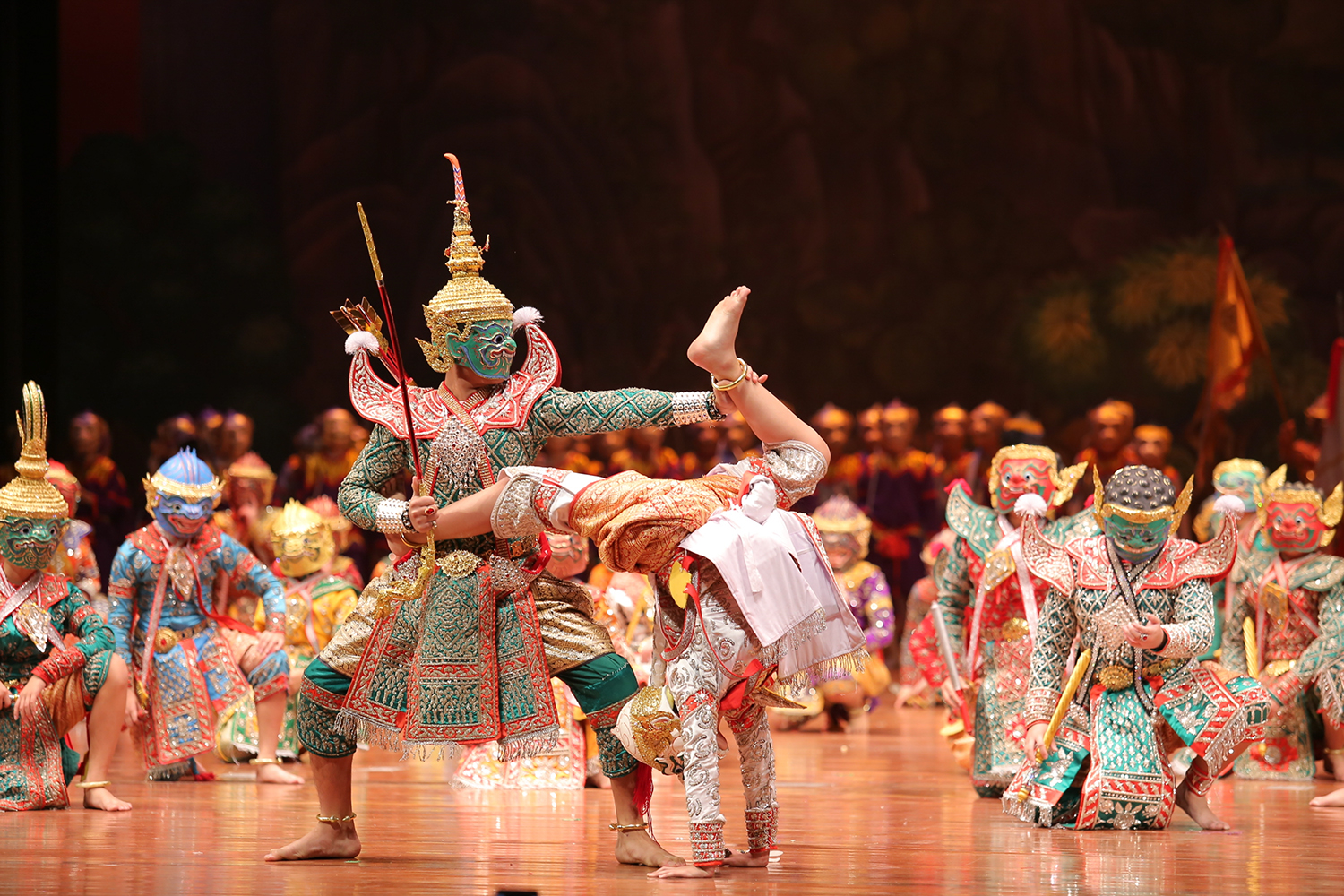
Thailand is a country rich in culture and history, with a diverse and vibrant artistic heritage that reflects its unique identity and values. Art and architecture in Thailand have been influenced by various sources, such as Buddhism, Hinduism, indigenous beliefs, and neighboring civilizations, resulting in a distinctive style that is both elegant and expressive. In this article, we will explore some of the main features and examples of art and architecture in Thai culture, from ancient times to the present day.
One of the earliest forms of artistic expression in Thailand is rock art, which can be found in over 410 documented sites across the country. These sites feature monochrome red pictograms that depict animals, humans, geometric shapes, and handprints, dating back to 3,000–5,000 years ago. Some of the most notable rock art sites are Pha Taem National Park in Ubon Ratchathani province, Tham Phraya Nakhon Cave in Prachuap Khiri Khan province, and Khao Pla Ra in Uthai Thani province.
The Dvaravati period (6th–12th centuries CE) marked the spread of Theravada Buddhism throughout Thailand, which had a significant impact on the development of art and architecture. The Dvaravati style is characterized by circular or oval stupas (relic mounds), stone Buddha images with oval faces and curly hair, terracotta votive tablets, and decorative motifs such as lotus flowers, naga serpents, and makara sea creatures. Some of the best examples of Dvaravati art can be seen at Wat Phra Men in Nakhon Pathom province, Wat Phra Si Rattana Mahathat in Lopburi province, and Wat Ku Kut in Lamphun province.
The Angkor period (11th–13th centuries CE) saw the influence of the Khmer Empire on Thai art and architecture, especially in the northeastern and central regions. The Angkor style is known for its elaborate temple complexes with towering prangs (spires), carved bas-reliefs depicting scenes from Hindu epics and Buddhist legends, and colossal stone statues of gods and guardians. Some of the most impressive examples of Angkor art can be found at Phimai Historical Park in Nakhon Ratchasima province, Phanom Rung Historical Park in Buriram province, and Lopburi Historical Park in Lopburi province.
The Sukhothai period (13th–14th centuries CE) witnessed the emergence of a distinct Thai identity and artistic expression, as the Sukhothai Kingdom became independent from the Khmer Empire and established its own cultural and political center. The Sukhothai style is renowned for its graceful and refined Buddha images with slender bodies, elongated limbs, flame-like ushnishas (cranial protuberances), and serene smiles. The Sukhothai style also introduced the lotus-bud chedi (stupa), a conical structure with a pointed top resembling a lotus bud. Some of the most exquisite examples of Sukhothai art can be seen at Sukhothai Historical Park in Sukhothai province, Si Satchanalai Historical Park in Sukhothai province, and Wat Si Chum in Sukhothai province.
The Ayutthaya period (14th–18th centuries CE) was a golden age of Thai art and architecture, as the Ayutthaya Kingdom became a powerful and prosperous empire that dominated Southeast Asia for over four centuries. The Ayutthaya style is characterized by its grandeur and diversity, incorporating elements from various sources such as Sri Lanka, India, China, Persia, Europe, and neighboring kingdoms. The Ayutthaya style features massive temple complexes with prangs (spires), chedis (stupas), ubosots (ordination halls), wihans (assembly halls), mondops (square pavilions), prasats (palaces), ho trais (libraries), bai semas (boundary stones), and Buddha images in various postures and materials. Some of the most magnificent examples of Ayutthaya art can be seen at Ayutthaya Historical Park in Ayutthaya province, Wat Phra Si Sanphet in Ayutthaya province, and Wat Phra Mahathat in Ayutthaya province.
The Rattanakosin period (18th century CE–present) is the current era of Thai art and architecture, which began with the establishment of Bangkok as the new capital of Thailand by King Rama I after the fall of Ayutthaya to the Burmese invaders. The Rattanakosin style is influenced by the Ayutthaya style but also incorporates new elements from Western culture and technology. The Rattanakosin style features elaborate temple complexes with gilded prangs (spires), chedis (stupas), ubosots (ordination halls), wihans (assembly halls), mondops (square pavilions), prasats (palaces), ho trais (libraries), bai semas (boundary stones), and Buddha images in various postures and materials. The Rattanakosin style also introduces new forms of art such as mural paintings, lacquerware, nielloware, and royal barges. Some of the most splendid examples of Rattanakosin art can be seen at Wat Phra Kaew in Bangkok, Wat Arun in Bangkok, and Wat Pho in Bangkok.
Traditional Thai houses are another important aspect of Thai art and architecture, which reflect the adaptation of the Thai people to their natural environment and social context. Traditional Thai houses are usually built on stilts to protect from floods and animals, and have a steep roof to facilitate drainage and ventilation. Traditional Thai houses are made of wood, bamboo, or thatch, and have a simple layout with a central living area, a kitchen, a bathroom, and a veranda. Traditional Thai houses are decorated with carvings, paintings, textiles, and handicrafts that showcase the skills and creativity of the Thai people. Some of the most charming examples of traditional Thai houses can be seen at Jim Thompson House in Bangkok, Ban Chiang National Museum in Udon Thani province, and Ban Rai Kong Khing Community in Chiang Mai province.
Art and architecture in Thailand are not only expressions of beauty and aesthetics, but also manifestations of the Thai people's faith and values. Religious buildings such as temples, shrines, and spirit houses are ubiquitous in Thailand, and serve as places of worship, meditation, education, and community. Religious buildings in Thailand are often adorned with symbols and motifs that represent Buddhist teachings, cosmology, mythology, and folklore. Some of the most common symbols and motifs are the lotus flower (purity), the naga serpent (protection), the garuda bird (power), the makara sea creature (wealth), the lion (courage), the elephant (royalty), the monkey (wisdom), and the swan (grace). Some of the most sacred and revered religious buildings in Thailand are Wat Phra That Doi Suthep in Chiang Mai province, Wat Phra That Phanom in Nakhon Phanom province, and Wat Phra That Lampang Luang in Lampang province.
Art and architecture in Thailand are also reflections of the Thai people's culture and lifestyle. Sala Thai (Thai pavilions) are open-air structures that provide shade and shelter for various purposes such as resting, meeting, eating, studying, or performing. Sala Thai are usually built near water sources such as rivers, canals, ponds, or wells, and have a roof supported by pillars and a floor raised above the ground. Sala Thai are decorated with carvings, paintings, or sculptures that depict scenes from Thai literature, history, or nature. Some of the most beautiful examples of Sala Thai can be seen at Vimanmek Mansion in Bangkok, Sala Rim Naam Restaurant in Bangkok, and Sala Keoku Sculpture Park in Nong Khai province.
Community places such as markets, schools, museums, theaters, and stadiums are also important venues for art and architecture in Thailand. Community places are designed to facilitate social interaction, cultural exchange, education, entertainment, and recreation. Community places in Thailand often incorporate elements of traditional Thai architecture such as roofs, pillars, windows, doors, and ornaments. Community places in Thailand also display various forms of art such as paintings, sculptures, photographs, posters, and graffiti that convey messages, stories, emotions, or opinions. Some of the most lively and colorful examples of community places in Thailand are Chatuchak Weekend Market in Bangkok, Siam Niramit Cultural Show in Bangkok, and Rajadamnern Stadium in Bangkok.
Art and architecture in Thailand are not only products of the past but also sources of inspiration for the present and the future. Contemporary Thai art is a dynamic and diverse field that explores various themes such as identity, politics, religion, society, environment, and technology. Contemporary Thai art employs various media such as painting, sculpture, installation, performance, video, and digital art to express ideas, critiques, or visions. Contemporary Thai art also engages with local and global audiences through exhibitions, festivals, workshops, and collaborations. Some of the most prominent and influential contemporary Thai artists are Thawan Duchanee, Chalermchai Kositpipat, Montien Boonma, Rirkrit Tiravanija, Navin Rawanchaikul, Apichatpong Weerasethakul, and Araya Rasdjarmrearnsook.
Art and architecture in Thailand are integral parts of the country's cultural heritage and national identity. They showcase the creativity and diversity of the Thai people, as well as their values and beliefs. Art and architecture in Thailand also contribute to the country's social and economic development, as they attract tourists, generate income, preserve traditions, and promote innovation. Art and architecture in Thailand are not static or stagnant, but rather dynamic and evolving, as they respond to changing times and contexts. Art and architecture in Thailand are a source of pride and joy for the Thai people, as well as a gift and a challenge for the world.
Food and Cuisine
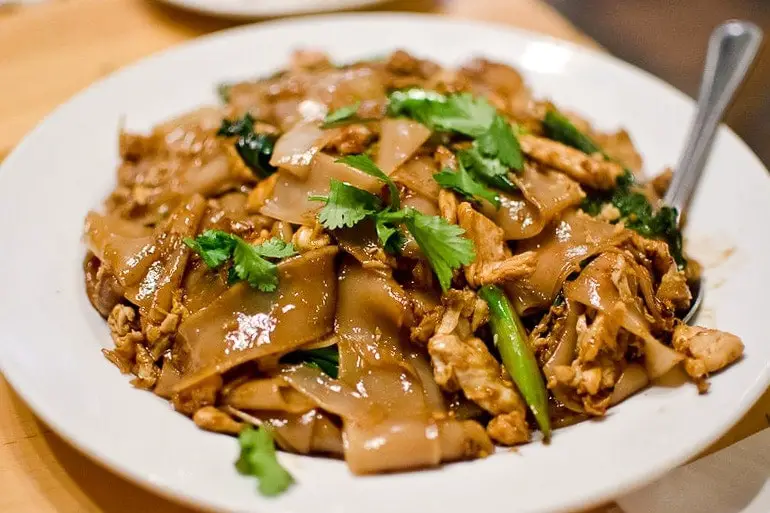
Thai cuisine is an essential part of Thai culture and identity. The country's diverse culinary heritage reflects its unique blend of cultures, geography, and history. From spicy curries to sweet and savory desserts, Thai food is renowned for its complex flavors and aromatic herbs and spices. The most common flavors in Thai cuisine are sweet, sour, salty, bitter, and spicy, which are often combined in a single dish to create a harmonious balance of flavors. Some of the key ingredients in Thai cooking include lemongrass, chili peppers, galangal, coconut milk, fish sauce, and palm sugar. However, there are also many regional variations in Thai cuisine, depending on the availability of local ingredients and the influence of neighboring countries.
Thai cuisine is known for its diverse range of dishes, which can vary from region to region. Some of the most popular Thai dishes include appetizers and soups such as spring rolls, tom yum, and tom kha gai, as well as salads and curries such as som tam, green curry, and massaman curry. Main dishes like pad Thai, stir-fried basil chicken, and pad kra pao are also widely enjoyed. In addition, Thai street food is a must-try for any visitor to Thailand, with favorites including mango sticky rice, banana pancakes, and satay.
If you want to discover the best foods to try in Thailand , click here to read our mouth-watering guide.
Thai cooking techniques and tools are also an important aspect of Thai cuisine. The most common cooking techniques are stir-frying, deep-frying, and grilling, which are used to create dishes with intense flavors and textures. Thai cooks often use woks and mortar and pestle to prepare ingredients and create a distinctive taste and aroma. The freshness and seasonality of ingredients are also important considerations in Thai cooking, with many dishes featuring herbs and spices that are locally grown and harvested.
Thai dining customs and etiquette are also an important part of Thai culture. In Thai culture, food is typically served family-style and shared among diners, with everyone using utensils and chopsticks to eat. Thai table manners and customs include a polite and respectful approach to dining, such as not using chopsticks to point or leaving food on your plate as a sign of respect to the host.
Thai cuisine is not only influenced by geography and history but also by religion and culture. For example, Chinese and Indian influences have had a significant impact on Thai cuisine, with Chinese-style noodles and Indian-style curries being popular dishes in Thailand. Royal Thai cuisine, which developed from palace cooking, is another significant aspect of Thai cuisine, featuring a range of elaborate and refined dishes that reflect the country's royal heritage. Food offerings in Thai religious ceremonies are also an essential part of Thai culture, reflecting the importance of food and its spiritual significance.
Thai food and cuisine are an essential part of Thai culture and identity. With its rich diversity of flavors, ingredients, and techniques, Thai cuisine offers a unique and unforgettable dining experience. Whether you're sampling street food in Bangkok or enjoying a royal Thai banquet, the cuisine of Thailand is sure to tantalize your taste buds and provide a glimpse into the country's fascinating history and culture.
Festivals and Celebrations
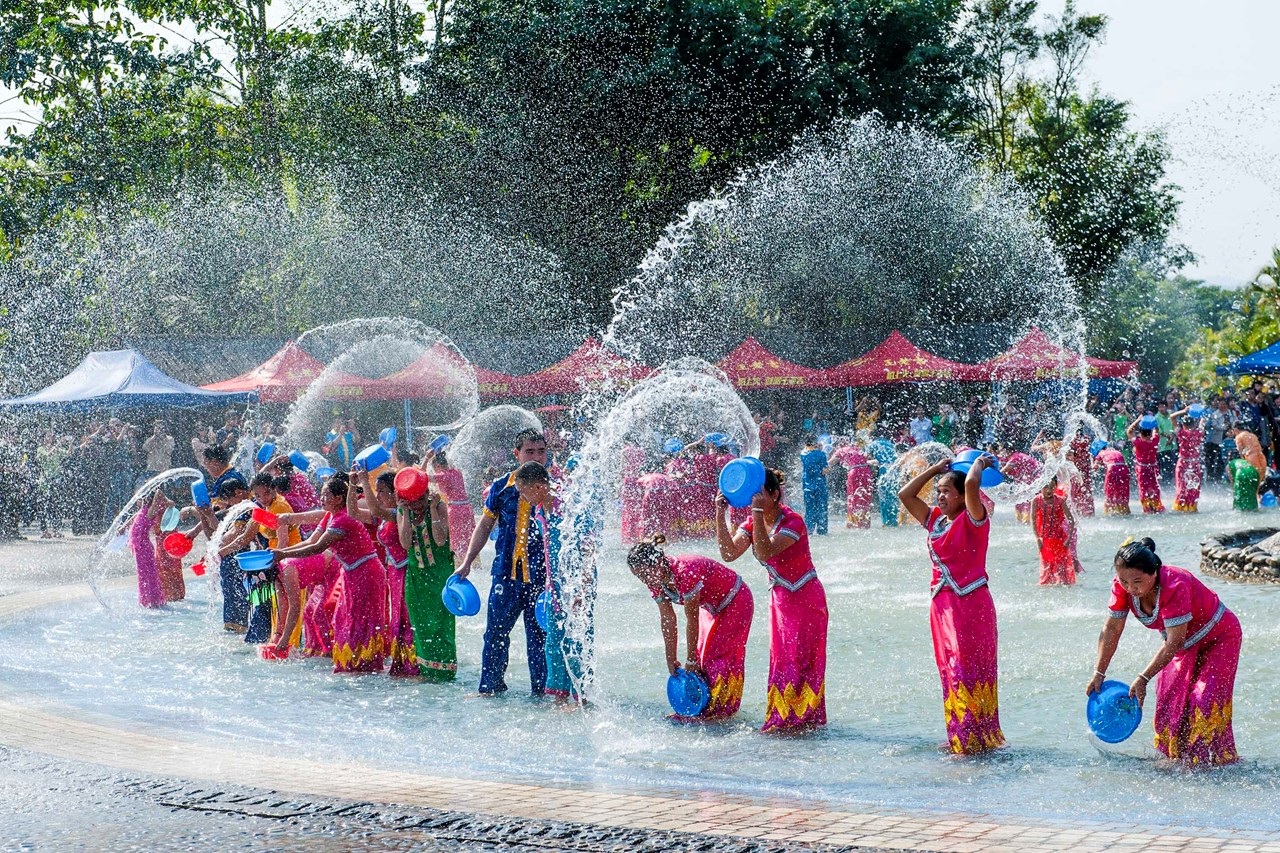
Thailand is renowned for its vibrant festivals and celebrations, which are a reflection of the country's rich cultural heritage. From the dazzling lantern displays of Loy Krathong to the frenzied water battles of Songkran, Thai festivals offer a unique and unforgettable experience.
Thailand has a diverse range of festivals and celebrations, ranging from religious ceremonies to secular events. Some of the most popular festivals include:
- Songkran: The Thai New Year, celebrated in April, is marked by a nationwide water festival, where people douse each other with water to wash away bad luck and purify the soul.
- Loy Krathong: Held in November, Loy Krathong is a festival of lights where people float small decorated baskets made of banana leaves and flowers on waterways.
- Phi Ta Khon: This is a unique and colorful festival in the northeastern province of Loei, where locals dress up in elaborate masks and costumes and parade through the streets.
Songkran is the most widely celebrated festival in Thailand, marking the traditional Thai New Year. The festival is celebrated from April 13 to 15 and is marked by a nationwide water fight. People splash water on each other with buckets, water guns, and hoses, symbolizing the washing away of the old and the ushering in of the new. In addition to the water fight, people also visit temples, make offerings to monks, and engage in other religious activities.
Loy Krathong, also known as the Festival of Lights, is celebrated on the full moon night of the 12th lunar month, usually in November. The festival is marked by floating krathongs, or small baskets made of banana leaves and flowers, on waterways. The krathongs are lit with candles and incense, creating a beautiful and serene display. Loy Krathong is a time of renewal, and people use the festival to make wishes and offer gratitude.
Other notable celebrations include the Vegetarian Festival, which involves a period of abstinence from meat and other stimulants, and the annual Boon Bang Fai Rocket Festival, where locals launch homemade rockets into the sky in hopes of bringing rain for the upcoming planting season.
Thai festivals and celebrations offer a unique glimpse into the country's rich cultural heritage. Whether it's the boisterous water fights of Songkran or the serene beauty of Loy Krathong, these events are an unforgettable experience that truly capture the essence of Thailand.
Beliefs and Practices in Thai Culture
The beliefs and practices of the Thai people reflect their values, traditions, and identity as a nation. In this article, we will explore some of the main aspects of Thai culture, such as religion, customs, superstitions, and festivals.
Religion in Thai Culture
The dominant religion in Thailand is Buddhism, which is practiced by about 94% of the population. Buddhism in Thailand belongs to the Theravada school, which emphasizes the teachings of the Buddha and the attainment of enlightenment. Buddhism is not only a religion but also a way of life for many Thais, who follow the five precepts (moral rules), observe the Buddhist holidays, and make merit (good deeds) by donating to temples, monks, and charities.
Buddhism in Thailand is also influenced by other belief systems, such as Animism, Brahmanism, and Hinduism. Animism is the belief in spirits that inhabit natural objects, animals, and humans. Many Thais believe in guardian spirits that protect their homes, villages, and businesses. They often build spirit houses or shrines to honor and appease these spirits. Brahmanism is the belief in angelic beings or gods that can grant wishes and blessings. Many Thais worship these deities at shrines or temples, especially Brahma, Indra, Ganesha, and Shiva. Hinduism is the source of many myths and legends that are depicted in Thai art and literature, such as the Ramakien (the Thai version of the Ramayana) and the Mahabharata.
Other religions in Thailand include Islam (5%), Christianity (1%), and Sikhism (0.1%). Islam is mainly practiced by the Malay minority in the southern provinces near the border with Malaysia. Christianity is mostly followed by ethnic groups such as the Karen, Hmong, Lahu, Lisu, and Akha in the northern and western regions. Sikhism is a minority religion among some Indian immigrants in urban areas.
Customs in Thai Culture
Thai culture is characterized by its politeness, respectfulness, and non-confrontational attitude. Thais value harmony and avoid conflict or criticism in public. They also value hierarchy and status, which are determined by factors such as age, education, occupation, wealth, and family background. Thais show respect to their elders and superiors by using honorific titles such as khun (Mr./Mrs./Ms.), ajarn (teacher), than (sir/madam), or luang (lord/lady).
One of the most distinctive customs in Thai culture is the wai, which is a gesture of greeting, farewell, gratitude, apology, or reverence. The wai consists of placing the palms together at chest level and bowing slightly. The higher the hands are raised and the lower the head is bowed, the more respect is shown. The wai is usually initiated by the younger or lower-status person to the older or higher-status person. However, there are exceptions to this rule depending on the situation and relationship.
Another important custom in Thai culture is sanuk, which means fun or enjoyment. Thais love to have fun and make any activity or situation more enjoyable. They often joke around, laugh, and smile even when facing difficulties or challenges. They also enjoy socializing with friends, family, and strangers, and sharing food, drinks, and stories. Sanuk is a way of expressing happiness and optimism in life.
Superstitions in Thai Culture
Thai culture is full of superstitions that influence many aspects of daily life. Some of these superstitions are based on ancient beliefs, folklore, or astrology, while others are derived from modern influences such as media, fashion, or celebrities. Some of the most common superstitions in Thai culture are:
- Do not cut your hair on Wednesdays or you will have bad luck.
- Do not point at a rainbow or your finger will fall off.
- Do not whistle at night or you will attract ghosts or snakes.
- Do not step over a person or they will stop growing.
- Do not sleep with your head facing west or you will have nightmares.
- Do not break a mirror or you will have seven years of bad luck.
- Do not walk under a ladder or you will have bad luck.
- Do not eat chicken wings or you will fly away from your lover.
- Do not eat banana peels or you will slip on them.
- Do not wear black on auspicious occasions such as weddings or birthdays.
Festivals in Thai Culture
Thai culture celebrates many festivals throughout the year that showcase its diversity, creativity, and spirituality. Some of these festivals are religious, some are cultural, and some are both.
Some of the most popular festivals in Thai culture are:
- Songkran: The Thai New Year festival that takes place in mid-April. It is a time of cleansing, renewal, and joy. People splash water on each other to wash away the bad luck and sins of the past year and to wish each other good luck and happiness for the new year. They also visit temples to make merit, offer food to monks, and pay respect to Buddha images and elders.
- Loy Krathong: The festival of lights that takes place on the full moon night of the 12th lunar month (usually in November). It is a time of gratitude, forgiveness, and romance. People float krathongs (small boats made of banana leaves, flowers, candles, and incense) on rivers, lakes, or ponds to thank the water goddess and to release their worries and regrets. They also make wishes for the future and watch the fireworks and lanterns in the sky.
- Yee Peng: The lantern festival that coincides with Loy Krathong in the northern city of Chiang Mai. It is a time of beauty, peace, and illumination. People release khom loy (paper lanterns) into the air to symbolize their hopes and dreams. They also admire the spectacular sight of thousands of lanterns floating in the night sky.
- Vegetarian Festival: The festival that takes place in late September or early October, especially in Phuket and other southern provinces. It is a time of purification, abstinence, and devotion. People follow a strict vegetarian diet for nine days to cleanse their bodies and minds. They also participate in various rituals and ceremonies, such as walking on fire, piercing their cheeks, or carrying heavy objects, to show their faith and endurance.
Beliefs and practices in Thai culture are fascinating and diverse, reflecting the country's history, geography, and identity. They also offer insights into the Thai people's values, traditions, and worldview. By learning more about Thai culture, one can appreciate its uniqueness and richness, as well as its similarities and differences with other cultures.
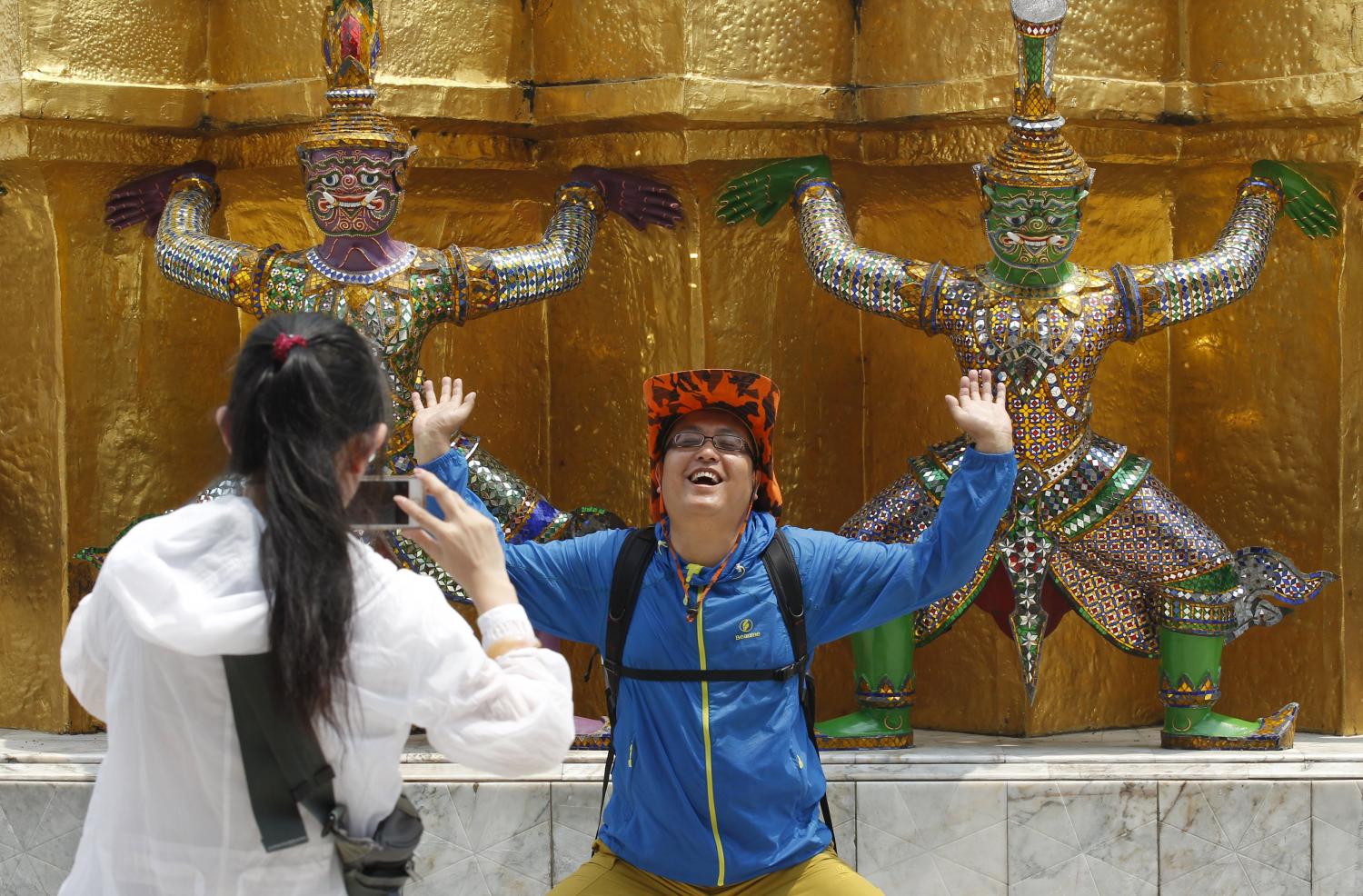
Thailand is a country with a unique and vibrant culture that has evolved over centuries. Its culture is influenced by religion, art, language, food, and festivals, and has a distinct identity that sets it apart from other countries in the region. Thai culture is not only fascinating but also deeply significant, as it reflects the values, beliefs, and customs of the Thai people. Therefore, it is crucial to preserve and promote Thai culture for future generations to appreciate and learn from.
The cultural diversity of Thailand provides a fascinating glimpse into a rich and complex society that is constantly evolving. The country's festivals and celebrations are an integral part of Thai culture, and a great way to experience it firsthand. From the colorful Songkran festival to the stunning Loy Krathong ceremony, Thai festivals are a celebration of life, culture, and community.
In conclusion, to truly understand Thailand, one must immerse oneself in its rich culture. By exploring its art, religion, language, food, and festivals, one can gain a deeper appreciation for the country and its people. We hope that this article has provided you with a glimpse into the fascinating world of Thai culture, and has inspired you to learn more about this enchanting country.
Other Travel Guides
- Top 23 foods to try in Thailand
- 24 Best Things to Do in Thailand: A Comprehensive Guide
REQUEST A FREE QUOTE
About travel thailand.
Indochina’s foremost active travel company designs journeys of comfort and authenticity to the most amazing destinations in the region since 2005. Best Tours, Best Service & Best Rates, guaranteed!
Why Choose Travel Thailand?
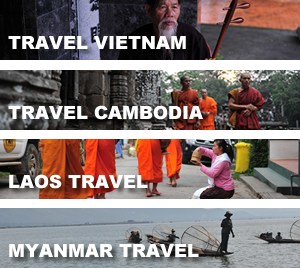
- Laos & Thailand Tours
- Cambodia & Thailand Tours
- Thailand & Myanmar Tours
- Vietnam Cambodia Thailand Tours
- Cambodia & Laos Tours
- Laos & Myanmar Tours
- Laos & Vietnam Tours
- Cambodia & Vietnam Tours
- Vietnam & Thailand Tours
- Cambodia & Myanmar Tours
Top Thailand Tour Packages
Fabulous indochina - 15 days.
A 15 day magical adventure through the highlights of Vietnam and Thailand, two countries that are very different and yet so rich in history and culture. Begin in Hanoi, with motorbike filled streets, French influenced boulevards, and romantic lakes. Cruise...
Price: from US $2,152
Bangkok & Chiang Mai - 7 days
This tour is designed for those who are short on time but still want to experience the true essence of Thailand. The journey begins in Bangkok, a bustling city with a mixture of stunning temples, views that take your breath...
Price: from US $712
Taste of Thailand - 9 days Culinary Tour
Thai cuisine, delicious and complex, is a delicate balance of sweet, spicy, sour and salty flavors. On this culinary tour of Thailand, learn how to use exotic ingredients such as keffir lime, lemongrass, coconut milk, and gangal ginger to prepare...
Price: from US $1,422
The Treasures of Thailand & Myanmar …
Combine the highlights of these two picturesque Buddhist countries. You’ll come face-to-face with the centuries-old rural lifestyle of the Shan people as you visit their floating villages on stunning Inle Lake. You’ll be invited into the homes of these tranquil...
Price: from US $1,757
Essential Thailand - 10 days
This 10 day 9 night journey introduces you to “all that is Thailand”. It features the best of Thailand’s cities, rural countryside, and breathtaking beaches, with an emphasis on regional culture, history, arts, and traditional Thai cuisine. You will even...
Price: from US $1,122
- Travel Blogs
- Travel News
- Testimonial
- Privacy Policy
- Payment & Travel Terms
17 things you need to know before visiting Thailand

Oct 28, 2023 • 7 min read
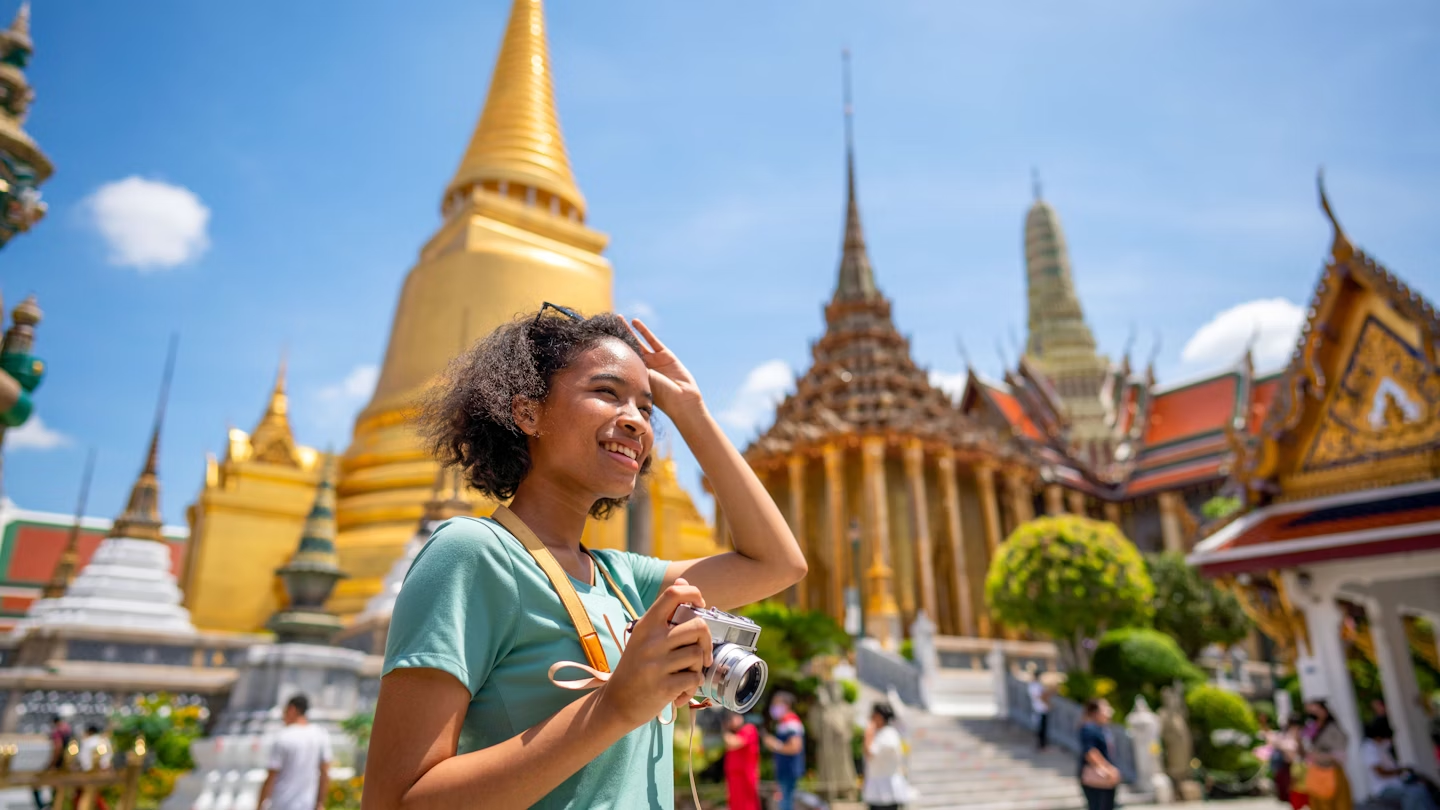
Thailand is one of the easiest places to travel in Asia, but there are some top tips that first-time visitors should know © Witthaya Prasongsin / Getty Images
Thailand has a deserved reputation as one of the easiest places to travel in Asia. There’s an amazing amount to see , hassles are limited, English-language signs and menus are commonplace, and you can get around easily at almost any time of day or night.
However, there are a few things every traveler should know. Here are our top tips for making the most of your trip.
1. Rainy season varies depending on where you are
The June to October rainy season brings heavy showers and regular storms to northern, central and southwestern Thailand, creating dangerous conditions for travel by sea. The southeast coast and the Gulf of Thailand get soaked slightly later, from October to December.
Rainy-season travel means lower prices and smaller crowds, but some accommodations close and many island ferries stop running, including services to the Tarutao archipelago . If this is when you decide to visit, you'll definitely want to pack some kind of wet weather gear.
2. Check for recommended vaccinations
You’ve probably already been jabbed for COVID-19, but most doctors also recommend vaccination against tetanus and hepatitis A. Also consider a rabies shot – dogs, cats and monkeys can all carry the viral disease. Malaria is present along the borders with Laos , Cambodia , Myanmar and Malaysia . If you visit these regions, use anti-malarial prophylaxis such as atovaquone/proguanil or doxycycline.
3. Sensible travelers to Thailand book ahead
If you have your heart set on a particular boat journey, train trip, trek, tour or boutique stay, book ahead for the busy tourist season from November to March or during any religious holiday. During the rainy season, call or email ahead to check if places are open.
4. Follow local etiquette when meeting Thai people
When meeting locals in Thailand, the standard greeting is the wai – a respectful dip of the head with the hands held palms together in front of the chest. Don’t shake hands unless the other person initiates the handshake. If you get invited into a Thai home, remove your shoes before you enter and avoid pointing the soles of your feet towards another person.

5. Be respectful of Buddhism, a part of everyday life in Thailand
Some 95% of Thais are Buddhist, and the national religion weaves through every aspect of life. To show proper respect, remove footwear before entering any Buddhist structure, and wear clothing that covers the shoulders, upper arms and upper legs.
Never point the soles of your feet towards any Buddhist image (or monk), and don’t touch Buddha statues on the head. Give way to monks when walking on footpaths, and don’t sit next to them on public transport. It is also taboo for a woman to touch a monk or their belongings.
6. Dress modestly
Thai women and men usually avoid revealing outfits that show off a lot of skin. Swimsuits are fine for the beach, but away from the sand, throw on a sarong or fisher's pants, plus something that covers the shoulders if you visit religious sites. Topless or nude sunbathing is frowned upon and can attract unwanted attention.
7. Show respect for the king and royal family
The Thais take respect for the monarchy extremely seriously, and lèse-majesté (maligning the royal family) is a criminal offense. Never show disrespect towards the monarch or depictions of the royal family (including on money).
8. Know what to expect at the dining table
When dining out in Thailand, everything tends to arrive on the table at the same time, usually placed in the middle of the table for everyone to share. Thailand abandoned chopsticks in the 19th century. You’ll get a spoon and fork but no knife – but most dishes come as bite-sized morsels, so you won’t need one. Sticky rice is usually bundled up into balls and eaten with the fingers.

9. Vegetarian is a relative term in Thailand
Fish sauce, oyster sauce and egg are widely used as cooking ingredients in Thailand. The safest bet for people who don't eat fish or meat is to seek out Indian-owned vegetarian restaurants, or restaurants serving kin jay Buddhist cuisine. If in doubt, ask the person making the food if it is jay – the term mang sa wirat just means food that doesn’t contain pieces of meat or fish but doesn't mean it's necessarily suitable for vegetarians.
10. Health risks include stomach bugs, mosquito bites and rabies
The most common trouble travelers face in Thailand is trip-spoiling stomach bugs. Never drink tap water, wash your hands before eating, stick to busy eating establishments and be cautious of ice, unwashed or unpeeled fruit and uncooked vegetables. If you become unwell, seek out private hospitals in larger cities rather than public hospitals.
Mosquito bites can easily become infected in Thailand’s tropical climate. Bring mosquito repellent, and use mosquito nets (or bring your own). Rabies is another risk – always seek medical attention if you are bitten by a dog, cat or monkey.
11. Smart travelers steer clear of drugs in Thailand
In June 2022, marijuana and hemp were removed from the Category 5 narcotics list in Thailand. However, there are still restrictions and smoking marijuana in public is not recommended.
Crossing borders with Class A drugs carries the death penalty, and even the possession of small quantities can bring a hefty prison sentence – it’s really not worth the risk. Also note that smoking in public can attract heavy fines. If you take any prescription medicines, check that these are allowed into Thailand before you travel.

12. Prices may well be inflated for tourists
In general, Thailand is hassle-free, but tourists are often charged inflated prices for tuk-tuks and unmetered taxi rides – ask a local how much journeys should cost and use that as a yardstick for a fair fare.
Major tourist sites are popular stalking grounds for cab drivers and touts who will try to steer you towards dubious souvenir shops, fake "tourist offices" and second-rate places to stay, where you’ll inevitably pay more to cover their commission. Book transport directly with the operators to avoid dodgy deals from unscrupulous travel agents.
13. You may be approached by sex workers
Thailand’s sex industry may find you whether you want it to or not. Single male travelers (and even couples) can expect to be approached by sex workers or touts drumming up business, so be ready with a firm refusal.
Be aware that some bars, restaurants and karaoke venues are fronts for sex work – warning signs include red or pink strip lights, large numbers of skimpily dressed female staff and lots of foreign male customers.
14. Political protests can be tense and are best avoided
Thailand can have a lot of protests. When tensions flare up between the government and opposition groups, it can lead to blockades, flight cancellations and sometimes violence. Monitor local news sites such as the Nation for information on simmering political troubles, and avoid protests and other potential flash points.
15. Some governments advise against travel in Thailand’s south
The far south of Thailand, along the Malaysian border, has been wracked by a separatist insurgency since the 1940s. Most foreign governments advise against travel to the districts of Yala, Pattani, Narathiwat and parts of Songkhla.
16. Be very cautious when riding a scooter
Thousands of travelers rent a scooter or motorcycle in Thailand, but make sure your home driving license covers you for any vehicle you hire, and carry your passport (or a copy of the ID pages) in case the police ask for it.
Wear a helmet, ride cautiously and make sure the rental comes with liability insurance – every year, hundreds of tourists are injured in motorcycle and scooter accidents in Thailand. Always give way to larger vehicles, and watch out for livestock, potholes and other hazards on the road.
17. Follow local advice if there's a natural disaster
Thailand is vulnerable to earthquakes and tsunamis, as well as flooding, landslides and cyclones during the rainy season. Heed official advice in the event of a natural disaster, and contact your embassy for up-to-the-minute information on evacuation procedures.
This article was first published January 2022 and updated October 2023
Explore related stories
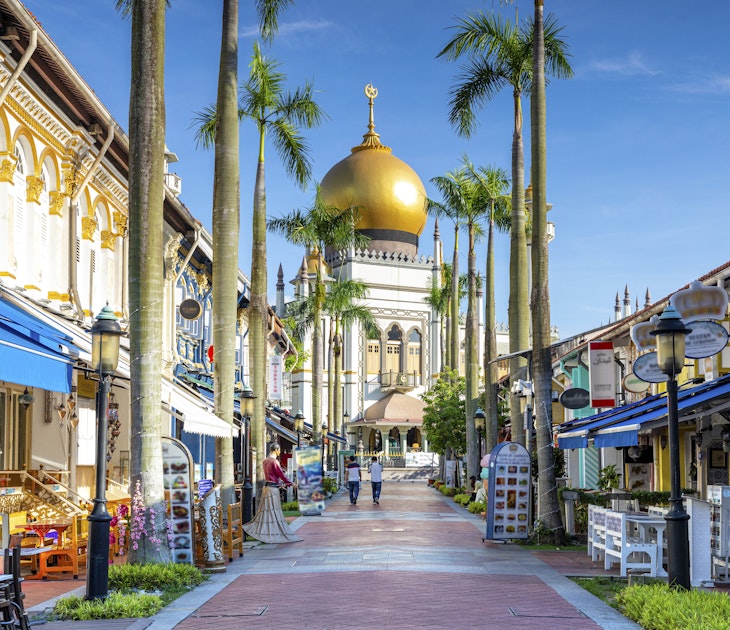
Tips & Advice
Apr 16, 2024 • 12 min read
Singapore's allure goes beyond its iconic hotels, manicured gardens and world-class airport – here are the best places to visit when you arrive.
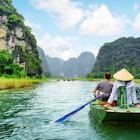
Mar 14, 2024 • 10 min read

Feb 24, 2024 • 8 min read

Feb 3, 2024 • 7 min read
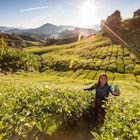
Jan 29, 2024 • 8 min read

Jan 5, 2024 • 20 min read
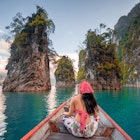
Jan 3, 2024 • 5 min read

Dec 27, 2023 • 8 min read
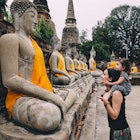
Dec 16, 2023 • 9 min read

Dec 15, 2023 • 7 min read
APRIL SALE: Book now and get up to 60% off!
Incredible Thailand and Laos by Train
- Fully Guided
- Train & Rail
- Personalized
Places You’ll See

- Explore Bangkok with a Local Insider
- Tuck into authentic Thai street food in Chiang Mai
- Feed, bathe and walk with Asian elephants at an ethical sanctuary
- See the atmospheric ruins of the Khmer city of Sukhothai
- Embark on a two-day cruise along the Mekong River
- Experience local village life in Laos
- Kayak along the Namsong River
- Introduction
- Day 1 Welcome to Thailand!
- Day 2 Take the train north to the ancient ruins of Sukhothai
- Day 3 Get back on track to Chiang Mai
- Day 4 Learn to cook authentic Thai cuisine
- Day 5 Walk with elephants, go bamboo rafting and glamp out in the jungle
- Day 6 Travel to Chiang Khong
- Day 7 Hop aboard a Laos river cruise
- Day 8 Continue downriver and meet whiskey-making locals
- Day 9 Hike through the rainforest to an otherworldly waterfall
- Day 10 Take a high-speed train to Vang Vieng
- Day 11 Explore the Nam Song River by kayak
- Day 12 Take the sleeper train back to Bangkok
- Day 13 Take an Insider-led tour of Bangkok
- Day 14 So long, Thailand and Laos
Want to read it later?
Download this tour’s PDF brochure and start tour planning offline
What's Included
- Accommodation
- Additional Services
Where You'll Stay
Adventure type.
- Group of 16 travelers max.
- Fast booking confirmation
- Carefully planned itineraries
- Travel with like-minded people
- Travel with your own group of min. 4 travelers
- Choose your preferred dates and duration
- Upgrade your accommodation
- Customize the itineraries
Operated by Culture Trip
Culture Trip offers unique small-group adventures for travellers who want to experience extraordinary places. Curated by travel experts and led by Local Insiders, the multi-day itineraries combine authentic activities and immersive experiences with unique places to stay. Join a small group of culturally curious travellers to connect with a place, its people and culture like never before.
Customer Reviews
- Overall Rating Excellent 4.5
- Itinerary Excellent 4.5
- Guide Excellent 5.0
- Transport Average 3.0
- Accommodation Good 4.0
- Food Good 4.0
- Tour Operator Culture Trip 4.7

Dates & Availability
Pay-by-instalments
Take advantage of our 0% interest instalment plan on selected departures. Learn More
- Upcoming departures
- August 2024
- September 2024
- October 2024
- November 2024
- December 2024
- January 2025
- February 2025
- -20% Saturday 11 May, 2024 Friday 24 May, 2024 English Filling Fast Multiple Room Types €2,839 €2,271 Confirm Dates
- -20% Get Instant Confirmation Saturday 8 Jun, 2024 Friday 21 Jun, 2024 English Filling Fast Multiple Room Types €2,839 €2,271 Confirm Dates Hold space for 48h
- -15% Get Instant Confirmation Saturday 13 Jul, 2024 Friday 26 Jul, 2024 English Filling Fast Multiple Room Types €2,839 €2,413 Only Pay €100 Deposit Confirm Dates Hold space for 48h
- Get Instant Confirmation Saturday 10 Aug, 2024 Friday 23 Aug, 2024 English Filling Fast Multiple Room Types €2,839 0% Interest Instalments Only Pay €100 Deposit Confirm Dates Hold space for 48h
- -20% Get Instant Confirmation Saturday 14 Sep, 2024 Friday 27 Sep, 2024 English Filling Fast Multiple Room Types €2,839 €2,271 0% Interest Instalments Only Pay €100 Deposit Confirm Dates Hold space for 48h
- Saturday 12 Oct, 2024 Friday 25 Oct, 2024 English Sold Out €2,839 Only Pay €100 Deposit See Similar Tours For These Dates
- -10% Get Instant Confirmation Saturday 2 Nov, 2024 Friday 15 Nov, 2024 English Filling Fast Multiple Room Types €3,089 €2,780 0% Interest Instalments Only Pay €100 Deposit Confirm Dates Hold space for 48h
- Get Instant Confirmation Saturday 16 Nov, 2024 Friday 29 Nov, 2024 English Filling Fast Multiple Room Types €3,089 0% Interest Instalments Only Pay €100 Deposit Confirm Dates Hold space for 48h
- Get Instant Confirmation Saturday 7 Dec, 2024 Friday 20 Dec, 2024 English Filling Fast Multiple Room Types €3,089 0% Interest Instalments Only Pay €100 Deposit Confirm Dates Hold space for 48h
- Get Instant Confirmation Saturday 28 Dec, 2024 Friday 10 Jan, 2025 English Filling Fast Multiple Room Types €3,089 0% Interest Instalments Only Pay €100 Deposit Confirm Dates Hold space for 48h
Frequently Asked Questions
We are there for you! If you have any questions about this tour, then please don't hesitate to contact us 24/7 and we will get back to you latest within 2 hours!
Got a question about this tour?
Reach out to our travel experts.
Good to Know
- Currencies ₭ Kip Laos ฿ Baht Thailand
As a traveller from USA, Canada you will need an adaptor for types C, E, F. As a traveller from England, Australia, New Zealand, South Africa you will need an adaptor for types A, B, C, E, F.
- These are only indications, so please visit your doctor before you travel to be 100% sure.
- Typhoid - Recommended for Laos and Thailand. Ideally 2 weeks before travel.
- Hepatitis A - Recommended for Laos and Thailand. Ideally 2 weeks before travel.
- Cholera - Recommended for Laos and Thailand. Ideally 2 weeks before travel.
- Tuberculosis - Recommended for Laos and Thailand. Ideally 3 months before travel.
- Hepatitis B - Recommended for Laos and Thailand. Ideally 2 months before travel.
- Yellow fever - Certificate of vaccination required if arriving from an area with a risk of yellow fever transmission for Laos and Thailand. Ideally 10 days before travel.
- Japanese B encephalitis - Recommended for Laos and Thailand. Ideally 1 month before travel.
- Unfortunately we cannot offer you a visa application service. Whether you need a visa or not depends on your nationality and where you wish to travel. Assuming your home country does not have a visa agreement with the country you're planning to visit, you will need to apply for a visa in advance of your scheduled departure.
- Here is an indication for which countries you might need a visa. Please contact the local embassy for help applying for visas to these places.
- For any tour departing before 20th June 2024 a full payment is necessary. For tours departing after 20th June 2024, a minimum payment of €100 is required to confirm your booking with Culture Trip. The final payment will be automatically charged to your credit card on the designated due date. The final payment of the remaining balance is required at least 55 days prior to the departure date of your tour. TourRadar never charges you a booking fee and will charge you in the stated currency.
- Some departure dates and prices may vary and Culture Trip will contact you with any discrepancies before your booking is confirmed.
- The following cards are accepted for "Culture Trip" tours: Visa, Maestro, Mastercard, American Express or PayPal. TourRadar does NOT charge you an extra fee for using any of these payment methods.
- Insurance Unless otherwise mentioned, TourRadar does not provide travel insurance. We do however recommend purchasing it through our tried and trusted partner, World Travel Nomads .
- Accessibility Some tours are not suitable for mobility-restricted traveller, however, some operators may be able to accommodate special requests. For any enquiries, you can contact our customer support team , who are ready and waiting to help you.
- Kimberley Tours
- Africa Tours
- South Africa Safari
- Hawaii Tours
- Morocco Tours
- China Tours
Similar Tours
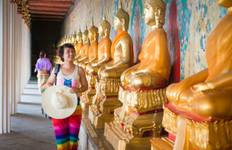
Keep Exploring Asia
- Thailand Travel Guide | All You Need to Know
- Two-Week / 14 Days Thailand Itineraries 2024/2025
- Best Explorer Tours and Trips 2024/2025
- Asia from Bangkok
- Asia Explorer
- 14 days Asia
- Operators in Asia
- Northern Thailand
- Central Laos
- Luang Prabang
- Incredible Thailand and Laos by Train Tours in Thailand
- Mekong Tours
- Explorer Tours
- Group Tours
- Fully Guided Tours
- Train & Rail Tours
- Personalized Tours
- Thailand tours
Thailand Cultural Tours & Cruises
- Start Date Select Month April 2024 May 2024 June 2024 July 2024 August 2024 September 2024 October 2024 November 2024 December 2024 January 2025 February 2025 March 2025 April 2025 May 2025 June 2025 July 2025 August 2025 September 2025 October 2025 November 2025 December 2025 January 2026 February 2026 March 2026 April 2026 OR, More specific start
- Easy Active
- Food & Wine
- Most Popular
- River Cruises
- Archaeological Site Visits
- Cooking Classes
- Local Market Visits
- Urban Exploration
- Village Visits
- Whitewater Rafting
- Wildlife Viewing
- RV Laos Pandaw
- Thai Cultural Discovery
- Tour the Grand Palace
- Peruse the Railway Track Market
- Visit a traditional Lanna family
- Interact with rescued elepants
- Taste of Thailand
- Wander through Chinatown
- Experience a hands on cooking class
- View ancient temples of Thailand
- Learn traditional culinary delights
Thailand and Laos
- Visit amazing sites of Bangkok
- Travel to Chiang Mai
- Visit an Elephant Sanctuary
- Tour the city of Luang Prabang
Thailand Travel Guide
- All Thailand Trips
- Best Times to Visit Thailand
- Brief History of Thailand
- Thai Religion
- Thai Cuisine
- Thailand FAQs
- Thailand Cruises
- Elephant Nature Park
Favorite Thailand All Trips
- Best of Thailand
- Exclusive Thailand
- Thailand Multisport
- Active Southern Explorer
- Siam Adventure
- Escape to Paradise
Top Thailand Travel Destinations
Thailand trips by departure date.
- 2024 Thailand trips (13)
- 2025 Thailand trips (12)
- 2026 Thailand trips (9)
- June 2024 (11)
- July 2024 (11)
- August 2024 (11)
- September 2024 (11)
- October 2024 (13)
- November 2024 (11)
- December 2024 (11)
- January 2025 (11)
- February 2025 (11)
Top Experiences in Thailand
- Thailand Land Tours (10)
- Thailand Family (4)
- Thailand Active (4)
- Thailand Cultural (3)
- Thailand Beaches (3)
Thailand Trips by Activity
- Thailand local market visits (9)
- Thailand kayaking (6)
- Thailand village visits (5)
- Thailand urban exploration (4)
- Thailand cooking classes (4)
- Thailand biking (4)
- Thailand snorkeling (4)
- Thailand wildlife viewing (3)
Why Travel With Adventure Life
Recognized by.


Culture of Thailand for travelers
A few years ago, a friend came to Thailand on his dream trip to Southeast Asia. Like most tourists on their first trip to the land of smiles, he didn’t have a clue about the culture of Thailand. He is a very friendly guy, and he was in a great mood since he was on vacation. So while he traveled and enjoyed this beautiful country and its exquisite food, wherever he went, he kept greeting enthusiastically everyone he met on the way, intending to get closer to the customs of Thailand , with this expression:
‘ Khop khun kha! ‘
‘Hey, wait a second’, I said. ‘These words mean thank you ‘. Unknowingly, he had been thanking everyone he met . In response, people would smile at him, nodding their heads … sometimes with a warm “ khop khun khrap/kha .” And maybe Thais smiled as well because he was using the respectful word ‘ kha ‘ at the end of the sentence, which is habitually only used by females and transgenders, instead of ‘ khrap ‘, used by males.
And of course, the reason for this misunderstanding was that he often heard that phrase in restaurants, markets and many other corners of the kingdom of Thailand, and he wrongly assumed that it was the local greeting according to the culture of Thailand .
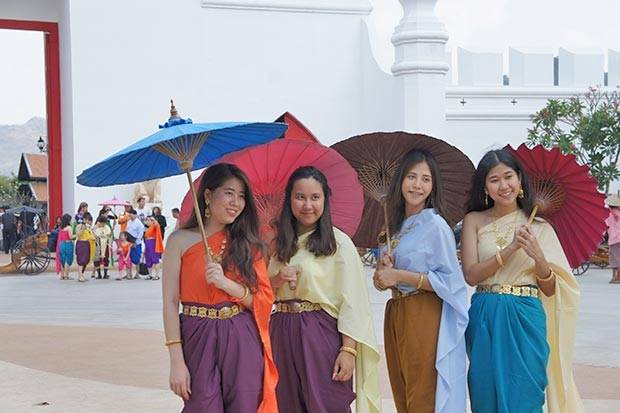
Popular wisdom tells us “wherever you go, do what you see”, and to some extent it is a good advice. But, along with this, it is always good to try to understand what lies underneath what we see, in order to understand it and apply it correctly .
One of the ways to get into the customs of Thailand is to learn a few basic words and phrases . Thais will really appreciate it if you try to express yourself in the local language, even if you can only say a few words with a terrible accent. It is also good to know some aspects of the local culture, the underlying customs that guide people’s behavior , so that you can better adapt to the environment and avoid unknowingly disturbing or offending anyone. This can even save you from certain penalties and bad times.
Therefore, below I will share some Thai customs so that you can avoid some common misunderstandings like what happened to my friend.
Here you can find:
Culture of Thailand: basic words that will be useful to you
How to greet in thailand.
Unlike in western countries, where people greet each other by shaking hands, hugging or kissing on the cheek, in Thailand greeting does not involve any kind of physical contact .
The most usual greeting in Thailand consists of making a slight bow (more pronounced if the person is much older) and brining palms together at chest level (actually the hands height is much more complicated, but chest level will suffice), saying :
- Men: sawaat dee khrap
- Women: sawaat dee kha
The ending khrap (used by men) and kha (used by women) is a particle with no definite meaning that adds a cordial and respectful tone to the sentence .
‘ Sawaat dii khrap ‘ or ‘ sawaat dii kha ‘ is equivalent to saying ‘hello’.
Sometimes they will shake your hand when they see that you are a foreigner. But there are no hugs or kisses in the greeting .
You can pronounce the same phrase when you want to say goodbye . So you can just say “ sawaat dii krap ” or “ sawaat dii ka ” to say “goodbye”.
Gratitude is a universal virtue that will be appreciated wherever you. To express it in Thailand, with its customs and traditions, you just have to say:
- Men: kawp khun krap!
- Women: kawp khun ka!
Knowing and trying to use some local words will open local peolple’s minds, but I assure you that if you manage to show gratitude and warmth, you will also open their hearts and get an even friendlier attitude towards you .
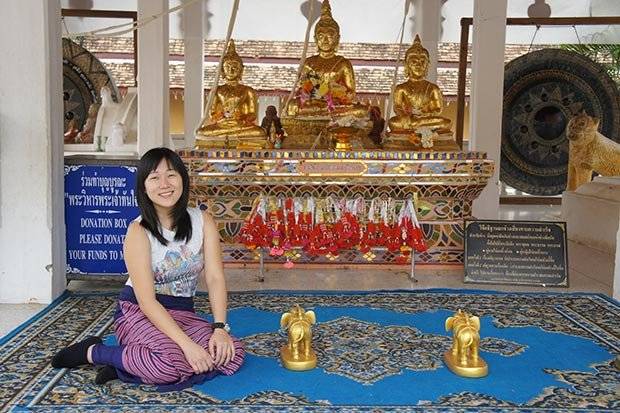
Knowing how to say ‘I don’t speak Thai’
‘I can’t speak (language)’ is a phrase that comes handy quite often when traveling abroad. It can get you out of misunderstandings and even trouble, in case someone wrongly assumes that you are understanding him/her . In Thai you can say:
- Men: phom phuut phaasaa thai mai daai khrap
- Women: chan phuut phaasaa thai mai daai kha
Anyway, people who work in tourist areas and tourism-oriented businesses like hotels and restaurants usually understand and can speak English.
But if you want to delve into the customs of Thailand, and show off some more proficiency in the language , you can say ‘Sorry, I don’t speak Thai’ by saying the following sentence instead:
- Men: kho thoot khrap, phom phuut phaasaa thai mai daai khrap
- Women: kho thoot kha, chan phuut phaasaa thai mai daai kha
The phrase ‘ kho thoot khrap / kha ‘ is equivalent to saying: sorry, my apologies . You can also use it on the subway, when you want to get off the train and ask people to let you pass.
🇹🇭 Here you have an article about Thai Language for Travelers .
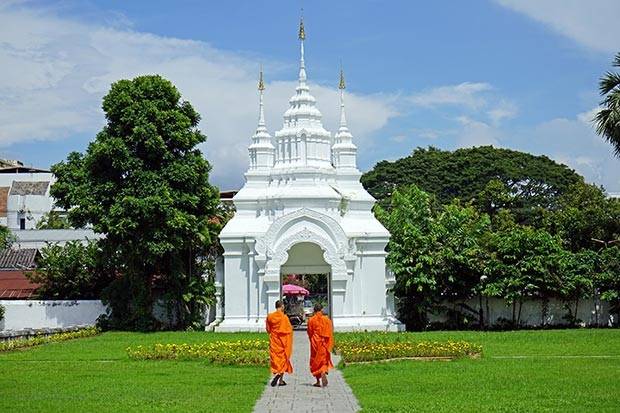
Thai manners for your trip
Let’s put the language aside to refer to other cultural aspects, to the pure customs and traditions of Thailand , which are good to know in order not to unwillingly annoy Thai people around us.
If you are familiar with these Thailand customs, you will get a better response from the Thais you interact with, and will avoid misunderstandings and problems that could give you a hard time. Pay attention to the following tips!
Don’t complain because not everyone can speak English
Yes, Thailand is a very touristy country and one of the most visited in the world. However, it is not an English-speaking country ; it has its own language and people are proud of it.
Unsurprisingly, any complaint about the general (or specific) English language level in Thailand will only close doors for you , and it will be a barrier preventing you from discovering the real country beyond the landscape.
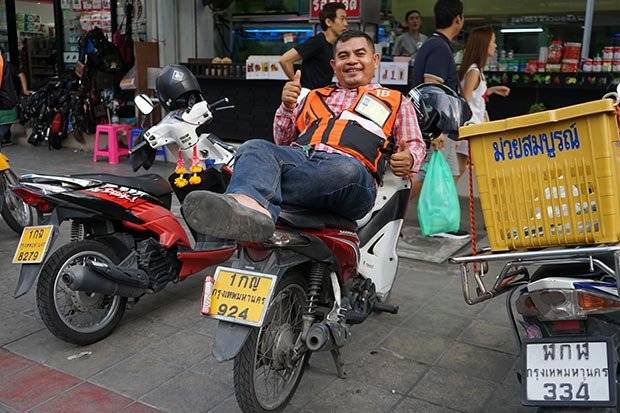
Let them know that you like their food… and if you don’t, better keep quiet!
Food is very important to Thais. They are very proud of Thai food, and really enjoy the act of eating. Thai gatherings usually involve a wide variety of Thai dishes with many different flavors . Therefore, if you tell them that Thai food is delicious, they will be very happy and will advise you to try local dishes that you probably have not heard of.
But if you don’t like local food, you better keep it to yourself . Besides the fact that no one likes to be told that the food they passionately love is bad, you would just be seen as another narrow-minded tourist
However, Thais will be very understanding if you tell them that you cannot eat spicy dishes . They are used to it, and it is rather a reason for amusement. Although, no doubt, if you like spicy they will be happier!
😙🚫 Avoid kissing in public
If you are traveling with your partner, don’t even think about kissing in a public space. No matter how romantic the place or moment may seem to you, kissing in public is frowned upon. You will notice that nobody in Thailand does, not even in series or movies . Kissing is reserved for privacy away from anyone else’s sight.
However, you can walk hand in hand with your partner, no problem with that. It goes without saying that you should avoid any attitude that may be considered unseemly.
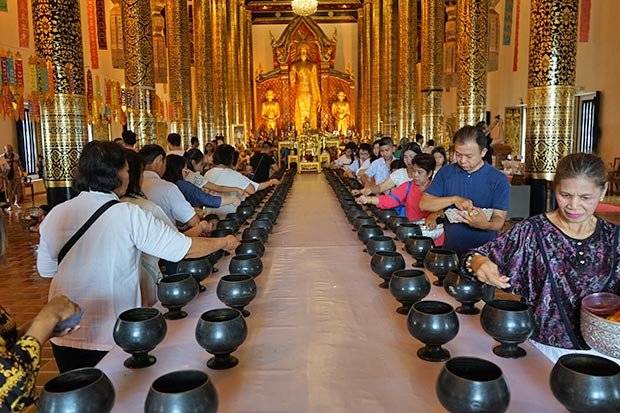
🙂 Don’t stop yourself from smiling
There is good reason why Thailand is often referred to as ‘The Land of Smiles’ in tourism campaigns. Thai people smile much more than the world average, and that gesture from you will be very well received by Thais . Smiling, along with a warm and respectful attitude, is a winning combination in Thailand. It is one of the customs of Thailand that will get you the best results with a very small effort.
🦶 Feet are not for pointing out things
One evening I was walking in a night market in Bangkok with my girlfriend (she is Thai). It was one of our first dates. We were thirsty so we stopped at a beverages stall where they sold iced tea and other soft drinks. A signpost hung from the counter at knee height, displaying pictures of the drinks available. My girlfriend asked me which one I wanted.
“That one” I replied, pointing with my left foot to a photograph of a milk tea glass .
For a couple of seconds she looked at me embarassed, like I just did something extremely rude, and she looked around hoping no one had noticed. When I noticed her reaction, I gave her the most tender look I managed to improvise. But I really had no clue about what I had done wrong!
She explained to me that feet are the most impure body part in Buddhist religion . They come into direct contact with the ground and its dirt, so pointing at things with your foot is considered rude, and is very frowned upon .
Therefore, pointing your feet at someone is also considered to be very disrespectful, according to the customs and traditions of Thailand.
👑 The figure of the king and the royal family
If you don’t live in a monarchy, it’s possible that the concept of ‘king’ rather makes you evoke fairy tales. Or maybe you live in a kingdom where it is accepted that both the king and the royal family are mocked by comedians and memes. In the case of Thailand, many aspects of the royal family resemble a fairy tale, but you better don’t make fun of them!
Thailand is a kingdom. And although the king in theory plays no part in politics and has only a symbolic role, law requires respect for the king and his family from both locals and foreigners .
In Thailand it is forbidden to speak ill of the king and other members of the royal family . There is a lese majeste law that punishes with very severe prison sentences for disrespecting the monarchy. The state media keeps making a big effort to pretend that virtually every ‘good’ Thai supports monarchy, although it is clearly not the case. So, unless they are effusively monarchical, what most Thais do is just avoid talking about it. In many settings, monarchy is a taboo subject .
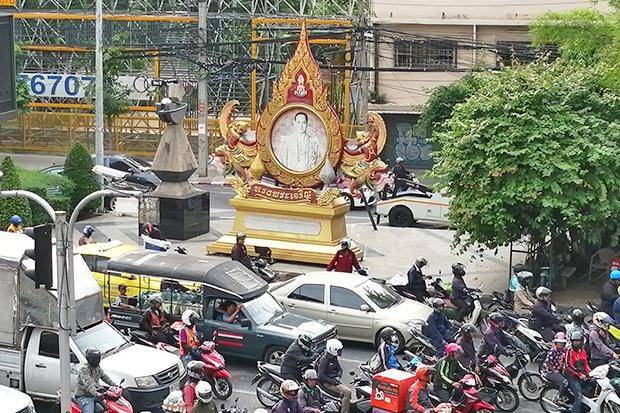
🇹🇭 Show respect when the national anthem is sung
This was something that took me by surprise when I first saw it. I was walking through Lumphini Park, a very beautiful urban park in Bangkok, where locals go to practice sports and sometimes you can see lovely huge lizards. People were running and exercising around me, when suddenly music began to blare through the speakers, with a melody that sounded familiar to me although I couldn’t identify it.
Suddenly everyone froze on the spot where they were standing at the same second that the music began to play . After taking a few steps while looking around me in bewilderment, I stood still. I saw some people look up to the sky, bringing their right hand to their chests. Others seemed to sing, or at least moved their lips following the lyrics.
The music lasted just over a minute, and right after it ended everyone went on with their activities .
The national anthem plays daily in public places at 8:00 a.m. and 6:00 p.m. You’ll experience something similar if you go to the cinema in Thailand. Before the beginning of every movie they play the national anthem, and everyone is expected to stand up to show respect.
🔮 Thailand is land of superstitions: Have a look at our article about 9 surprising Thai Superstitions and beliefs
Thai culture: visiting temples and interacting with monks
Visiting the temples is a must in Thailand. Buddhist temples captivate the traveler’s attention with their beautiful architecture and colorful decoration. If you have an interest in Buddhism, either as a religion or a philosophical tradition, visiting a temple and having the opportunity to speak with a monk will be a rewarding experience.

To visit a temple people must follow a few special rules , so when you visit these icons of Thai tradition and culture, keep the following in mind:
When visiting a Thai temple you must wear appropriate clothing . Rules are a bit stricter for women than for men, but generally speaking:
- Long trousers or skirts that cover at least below the knees (long trousers/skirts covering down to the ankles are only mandatory in Bangkok’s Grand Palace).
- Covering your shoulders is preferable (again, only mandatory in the Grand Palace in Bangkok).
- Do not wear semi-transparent garments that allow to see the part of the body it is supposed to cover.
- Avoid plunging necklines .
- You will have to remove your footwear before entering the main areas (inside the enclosure).
Are you a woman planning to travel solo? Don’t miss our article on Solo Female Travel in Thailand
Interaction with monks
Monks enjoy a special status in Thai culture . They are revered with great respect for leading a lifestyle that is undisturbed by worldly pleasures and sorrows. They have an important social role as spiritual guides, counselors and mediators to solve conflicts between members of their community, especially in small cities and towns.
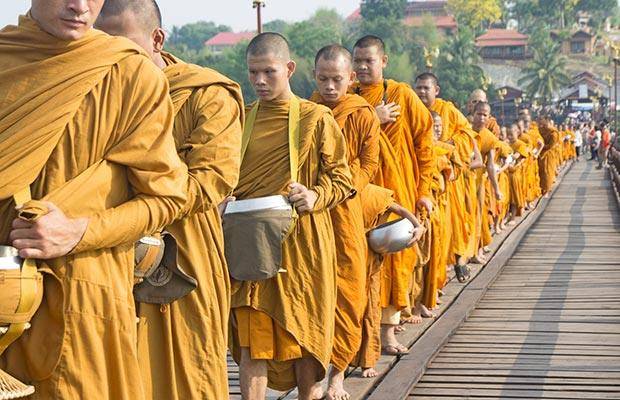
There are also exceptions, of course, and on many occasions monks have made headlines for their eccentric or fraudulent behaviors. Thais are well aware that all that glitters is not gold, and that it applies both to secular and monastic life.
In any case, the special role that Thai society reserves for monks means that, in general, monks receive a special treatment . You should keep in mind the following:
- Women cannot have any kind of physical contact with monks , and not even stay alone in a room with them (although it would be very strange for a tourist to find in such a situation).
- In general, men should also try to avoid touching the monk or his robe, or sitting very close to a monk . This is another of the customs and traditions of Thailand.
- In the temple, you should sit in a place that is lower than that occupied by a monk .
- On public transportation (although it is rather rare to see monks there), lay people are expected to offer their seats to any monk entering the vehicle/carriage .
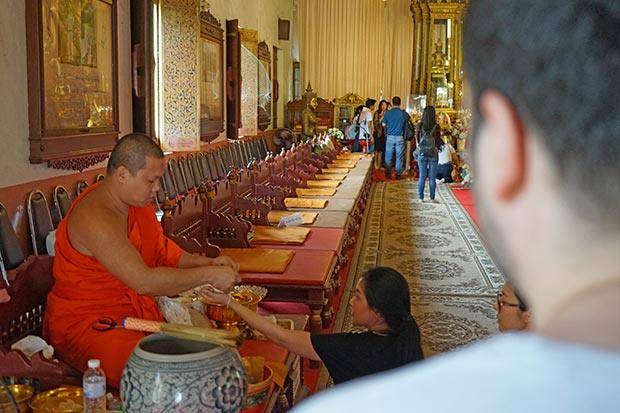
Respect Buddha images
For Thais, respect for the figure of Buddha is not only a cultural tradition, but in some cases it is even regulated and enforced by law .
No one with common sense will willingly disrespect the religiosity of the country he visits. However, ignorance of local customs could easily lead to involuntary offenses . Therefore, it is necessary to keep in mind:
- Buddha is not a decorative figure : therefore, buying a Buddha as a mere decoration is not allowed, and its decorative or disrespectful use can even be sanctioned . Well, at least this is the theory: you will see loads of Buddha figures offered in tourist markets, which is a bit contradictory. As a tourist, you might run into trouble if you try to exit Thailand with a Buddha figurine in your carry-on bag. If you put it in your checked baggage, there should be no problem .
- Buddha figures should never stand on the ground : they must be placed in a high place as a show of respect.
- Never climb on a Buddha figure or even its base or pedestal, even if you think you will miss out on taking the best photo of your trip .
- Don’t even consider getting a Buddha tattoo : since 2011 it is forbidden in Thailand to tattoo a Buddha on tourists, and doing so is illegal. In stricter countries like Myanmar they have even fired tourists for wearing Buddha tattoos.
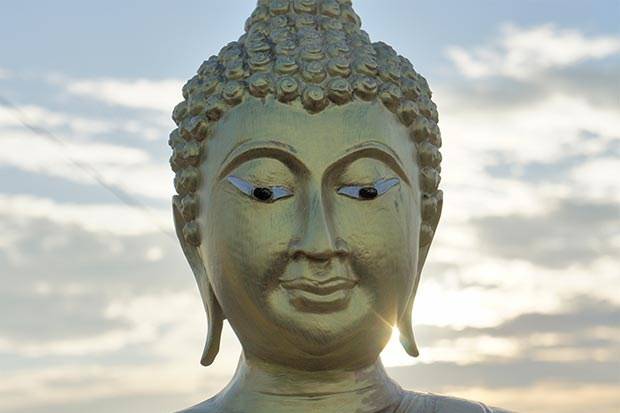
Are you interested in meditation? Have a look at our article in which a Spaniard nun narrates her experience doing a Vipassana meditation retreat in Northern Thailand .
Other Thai customs to take into account on your trip
🚇 when using the subway.
I think taking the subway (MRT and BTS) was one of the things that surprised me the most in my first days in Bangkok. Specifically, the fact that people lined up to board the train even at rush hour .
It is extremely unusual to see someone in Bangkok trying to get into the carriage before whoever gets there first. When entering and leaving the station they also do it in this orderly manner, which facilitates movement on the platforms.
So, even if you’re in a rush, stick to the line . The train frequency is good, so you never have to wait for too long
🚬 If you are a smoker …
Smokers should be very careful while in Thailand, as the inhabitants of the land of smiles tend to be very sensitive to cigarette smoke , and many even detest it. For this reason, it is frowned upon to smoke on the streets near other people .
If you smoke, I recommend:
- Avoid smoking in outdoor bar/restaurant and other places where you are surrounded by people , or where pedestrians are walking. Always try to smoke away from other people so smoke does not reach them. Especially if there are children.
- In closed places smoking is generally not allowed (for example, indoors restaurants).
- Dispose properly of cigarette butts .
❌ Drug use is severely penalized
Beyond tobacco, alcohol and prescription drugs, Thailand laws don’t make a clear distinction between hard and soft drugs: punishment is always very harsh . If you are a marijuana user, it is advisable that you abstain while you are in Thailand, since its use (as well as any other drug) is severely penalized with long prison terms . Drugs are no joke in Thailand, and can get you in serious trouble.
These are some rules of behavior and customs of Thailand to keep in mind while traveling around the country. They will help you enjoy Thailand without getting into unnecessary trouble!
Pol Comaposada
Pol has been traveling and creating content about Thailand and others parts of Asia since 2010. Founder and manager of Mundo Nómada Travel, a DMC (tour operator) with office in Bangkok that offers high quality tours and tailor-made packages in Thailand.
Related Posts

9 surprising Thai Superstitions and beliefs

Passing Thru Travel
Discover Thailand: Your Ultimate Guide to 20 Incredible Destinations in 2024
Posted: March 5, 2024 | Last updated: March 5, 2024
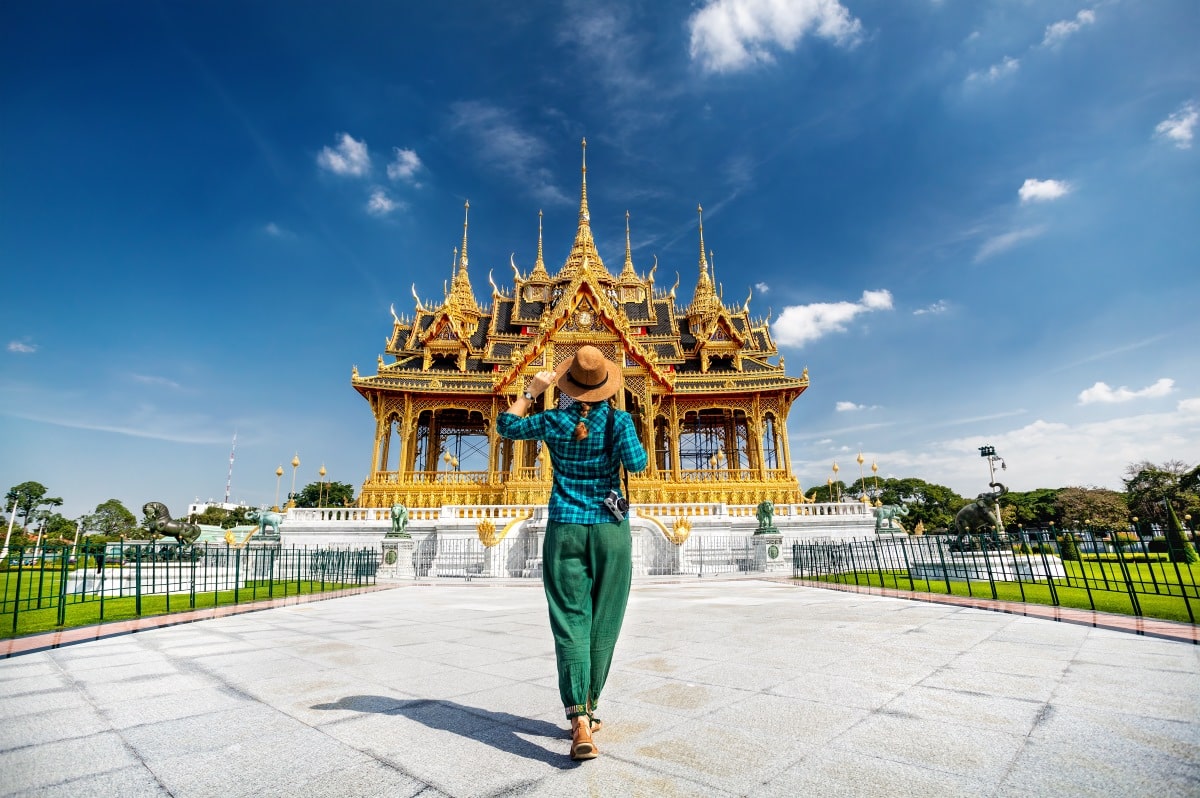
Thailand, with its rich cultural heritage, stunning landscapes, and renowned hospitality, offers a plethora of experiences for every traveler. From the bustling streets of Bangkok to the serene beaches of the south and the lush mountains of the north, this guide will take you through the diverse facets of Thailand, ensuring a journey filled with discovery and wonder.
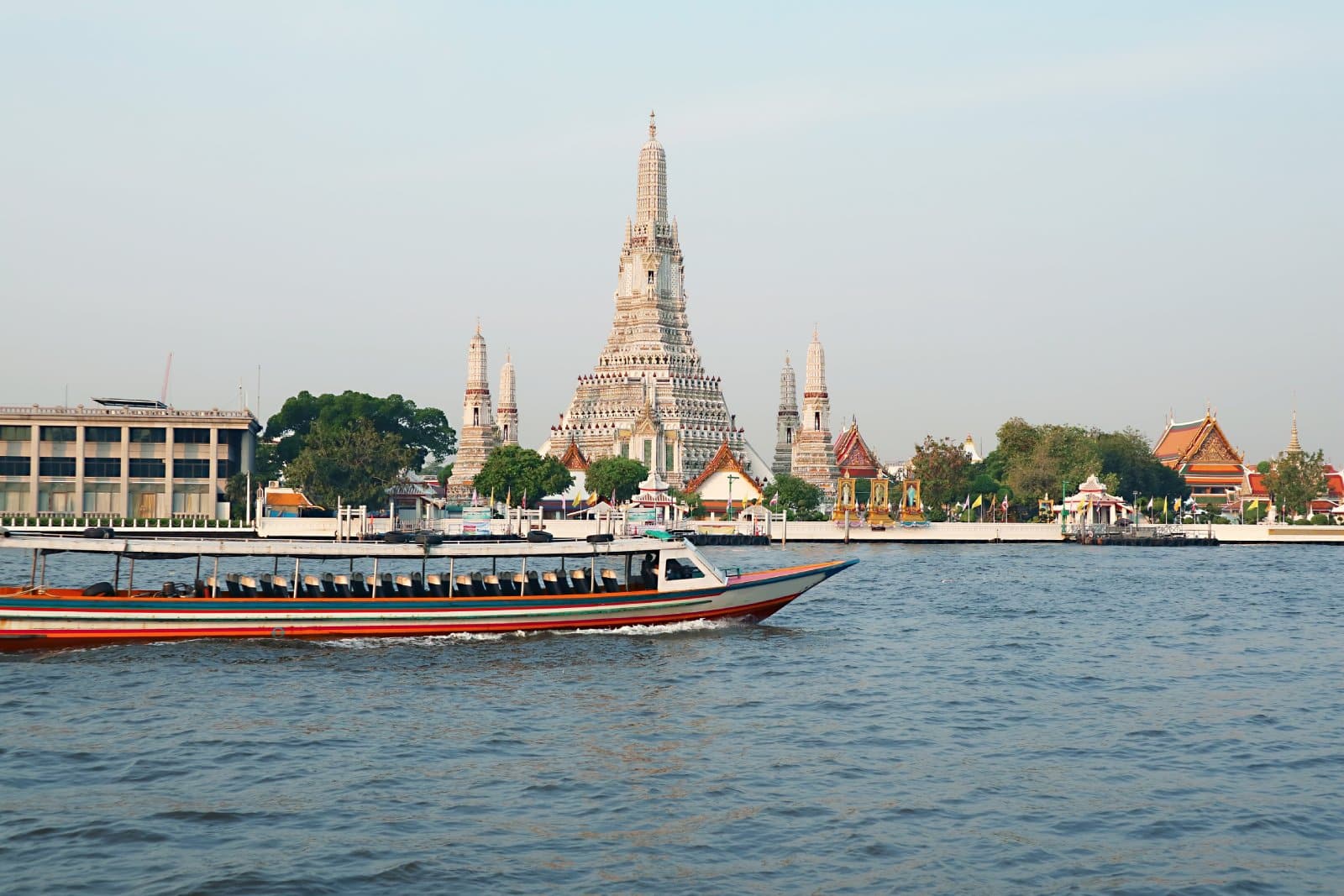
Bangkok, a city where ancient traditions seamlessly blend with modernity, offers an experience like no other. As you navigate its bustling streets, you’ll encounter magnificent temples such as Wat Phra Kaew and Wat Arun, standing as serene sanctuaries amidst the urban chaos. The Grand Palace, a former royal residence, highlights the city’s rich history and architectural grandeur.
For shopping enthusiasts, the sprawling Chatuchak Weekend Market presents a labyrinth of stalls selling everything from vintage clothing to local handicrafts. Don’t miss the opportunity to indulge in Bangkok’s renowned street food, where dishes like Pad Thai and Som Tam are served with authentic flavors.
The city’s vibrant nightlife, from rooftop bars to lively street markets, pulsates with energy, offering a glimpse into the contemporary lifestyle of Bangkok’s residents. Navigating Bangkok explores contrasts, where each turn presents a new facet of this dynamic city.
Insider’s Tip: Visit the lesser-known but equally impressive Wat Benchamabophit for a more tranquil temple experience.
How To Get There: Bangkok is accessible by its two main airports, Suvarnabhumi and Don Mueang. The city has an extensive public transport system, including the BTS Skytrain and MRT.
Best Time To Travel: The cool season from November to February is ideal, with pleasant weather and numerous festivals.

2. Chiang Mai
In Chiang Mai, the cultural heart of Northern Thailand, you’ll find a more laid-back atmosphere than Bangkok’s frenetic energy. The city is replete with historic temples, the most famous being Wat Phra Singh and Wat Chedi Luang, each offering a peaceful retreat and a look into the spiritual practices of the locals. The Night Bazaar and Sunday Walking Street Market are hubs for artisanal crafts and street food, reflecting the city’s artistic flair and culinary richness.
Just outside the city, the lush landscapes of Doi Inthanon National Park await, with trekking trails leading to waterfalls and hill tribe villages. Chiang Mai’s charm lies in its blend of history, culture, and nature, providing a holistic experience of Thailand’s northern region.
Whether you’re exploring its ancient temples, engaging in a traditional Thai cooking class, or wandering through its vibrant markets, Chiang Mai captivates with its serene beauty and rich cultural tapestry.
Insider’s Tip: Take a Thai cooking class to delve deeper into the region’s unique flavors.
How To Get There: Chiang Mai has an international airport and is also accessible by train or bus from Bangkok.
Best Time To Travel: Visit during the cool season, particularly in November, for the Yi Peng Lantern Festival.
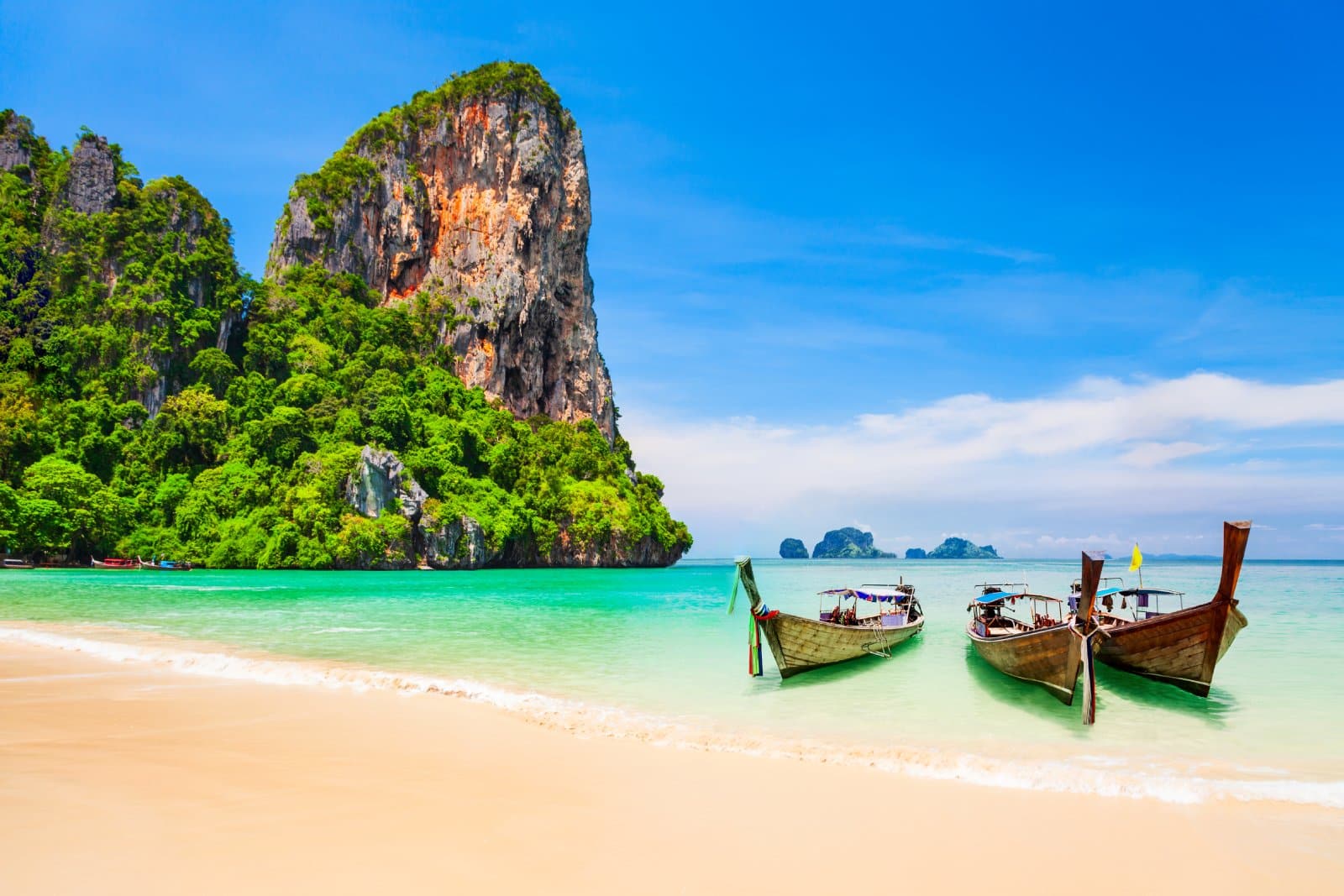
Phuket, Thailand’s largest island, is a blend of experiences catering to those seeking relaxation and adventure. The island’s beaches, like Patong, Kata, and Karon, offer a range of atmospheres, from bustling shores with water sports activities to more tranquil retreats. Beyond its stunning beaches, Phuket’s Old Town reveals a different side of the island, with Sino-Portuguese architecture and a burgeoning arts scene.
A visit to the Big Buddha is a must for a panoramic view of the island. The surrounding waters of Phuket, particularly the Phi Phi Islands and Similan Islands, are a paradise for divers and snorkelers, boasting vibrant marine life and crystal-clear waters.
Phuket’s nightlife, especially in Patong, pulsates with energy, offering many entertainment options. The island’s diversity, from its natural beauty to cultural richness, makes Phuket a microcosm of Thailand’s allure.
Insider’s Tip: Take a day trip to the Phi Phi Islands for some of the best snorkeling and diving.
How To Get There: Phuket is accessible by its international airport or by bus and ferry from the mainland.
Best Time To Travel: The best weather is from November to February, with calm seas and sunny skies.
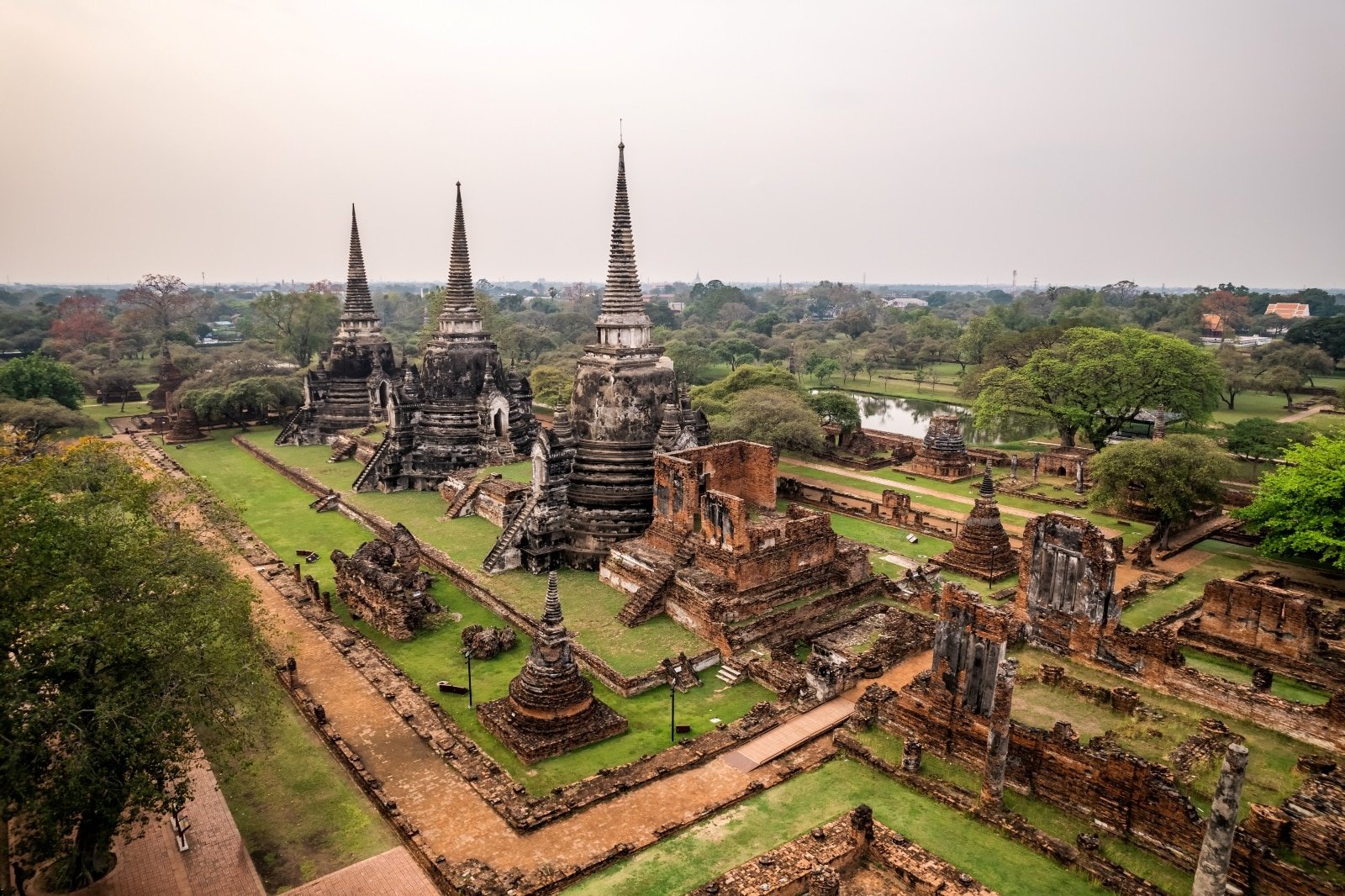
4. Ayutthaya
The ancient city of Ayutthaya, once the capital of the Kingdom of Siam, stands today as a UNESCO World Heritage Site, offering a journey through Thailand’s storied past. As you wander through the historical park, you’ll encounter the ruins of temples and palaces, each telling a tale of the city’s former glory and subsequent destruction.
The site’s most iconic structures, such as Wat Mahathat and Wat Phra Si Sanphet, showcase the sophisticated art and architecture of the Ayutthaya period. Exploring Ayutthaya is not just a historical excursion; it’s an immersive experience that transports you back to when the city was a major trading hub of Asia.
The juxtaposition of ancient ruins against a backdrop of modern life underscores the enduring legacy of Ayutthaya’s historical and cultural significance in Thailand.
Insider’s Tip: Visit during the early morning or late afternoon to avoid the heat and crowds.
How To Get There: Ayutthaya is a short train or bus ride from Bangkok.
Best Time To Travel: The cool season, from November to February, offers comfortable exploring conditions.
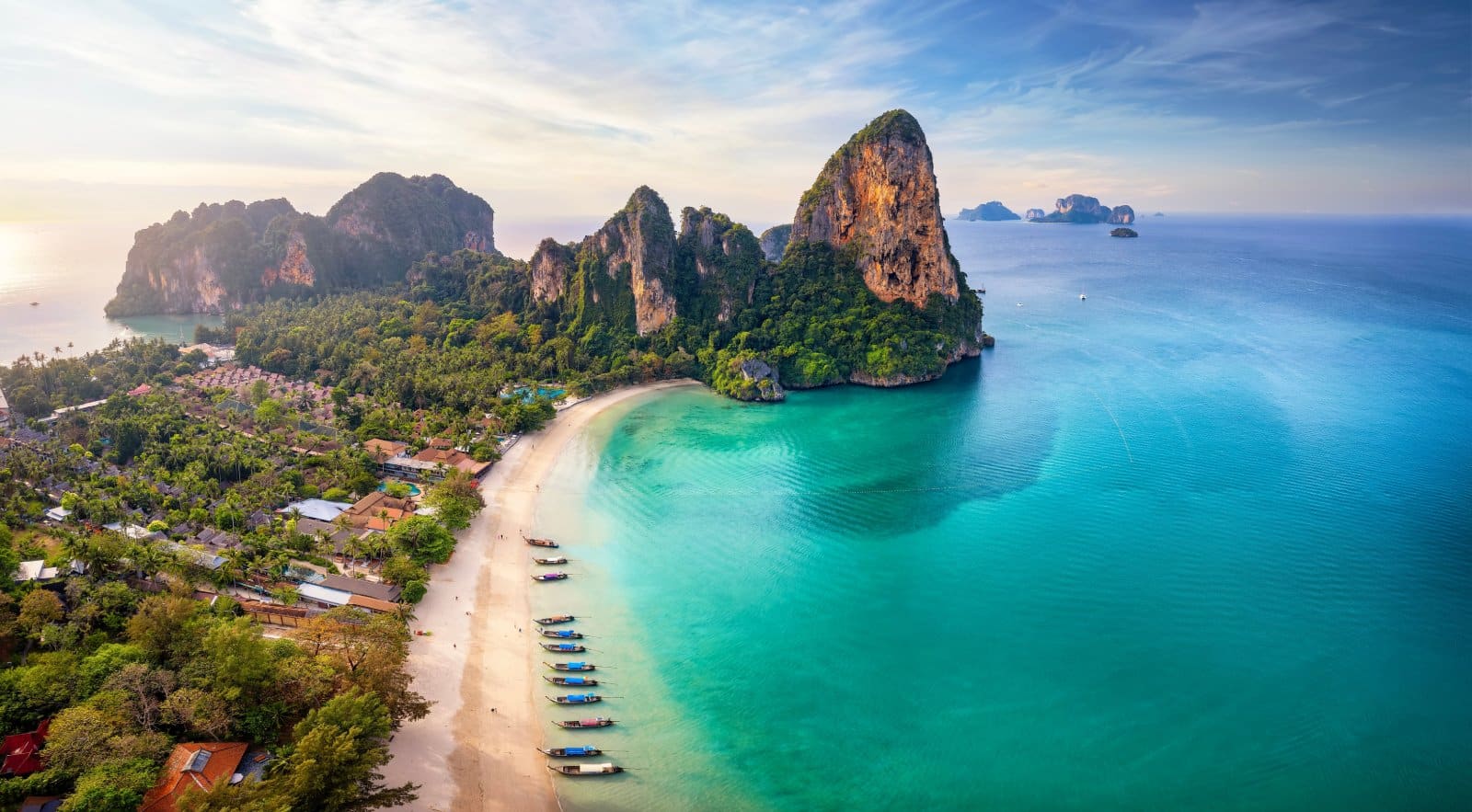
In Krabi Province, you’ll find yourself amidst some of Thailand’s most picturesque landscapes, marked by dramatic limestone cliffs, pristine beaches, and clear blue waters. The province is renowned for destinations like Railay Beach, which is accessible only by boat. It offers world-class rock climbing and stunning beachscapes.
The Phi Phi Islands, with their iconic beaches and vibrant marine life, are perfect for day trips, offering opportunities for snorkeling and diving. For a more tranquil experience, the lesser-known Koh Lanta provides a laid-back atmosphere with its long, sandy beaches. Krabi’s natural beauty extends beyond its coastline, with inland attractions like the Emerald Pool and the Tiger Cave Temple, each offering unique experiences.
Whether you’re seeking adventure on the cliffs of Railay or tranquility on the beaches of Koh Lanta, Krabi presents a diverse array of natural wonders waiting to be explored.
Insider’s Tip: Explore the mangroves and limestone caves by kayak for a unique perspective.
How To Get There: Krabi has an airport, and it’s also accessible by bus and boat from other parts of Thailand.
Best Time To Travel: Visit from November to March for the best beach weather.
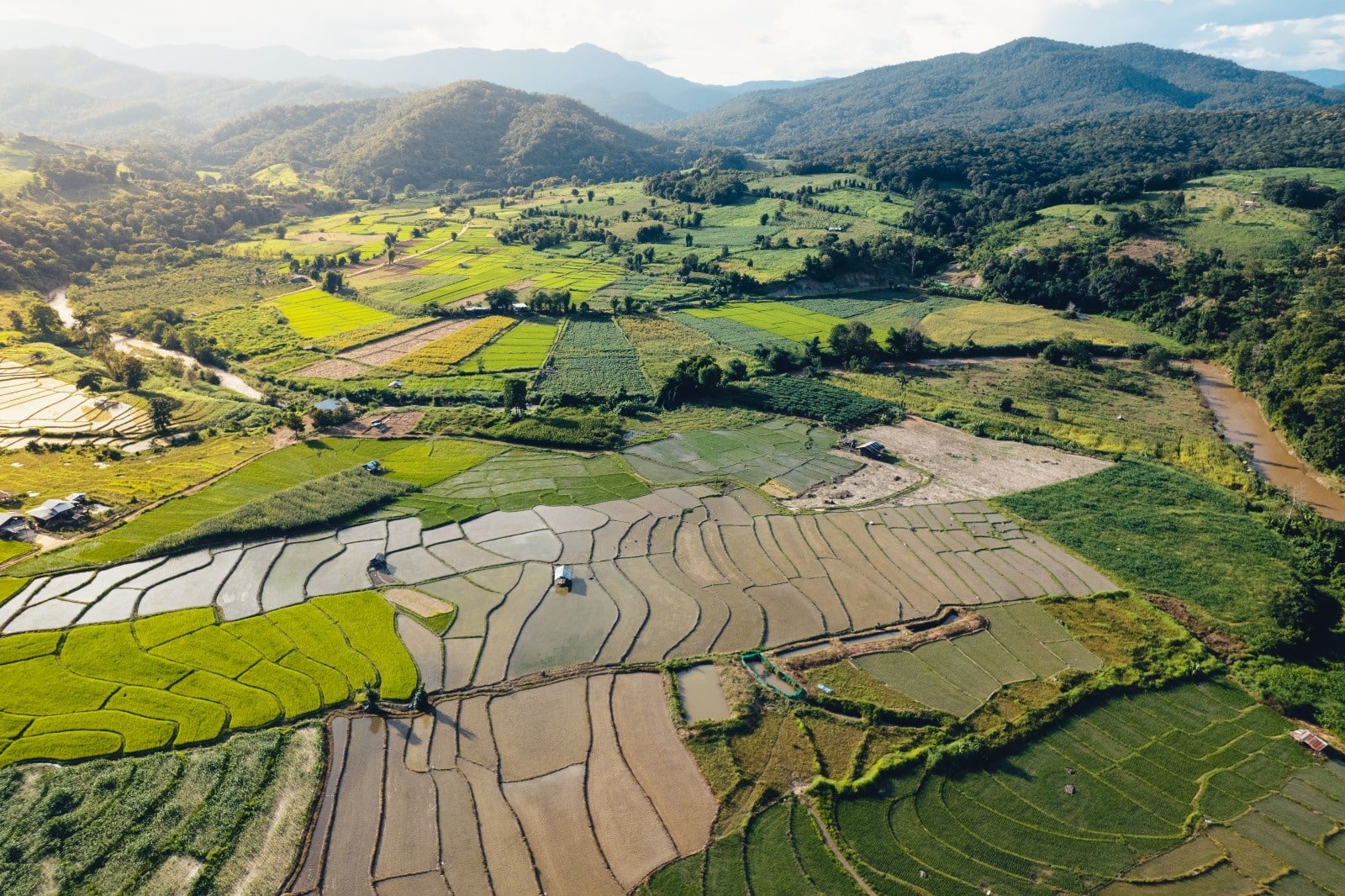
Pai, nestled in the mountains of Northern Thailand, is a haven for those seeking tranquility and natural beauty. With its relaxed atmosphere, this small town attracts travelers looking to escape the hustle of city life. Surrounded by rolling hills and lush greenery, Pai is perfect for outdoor activities like hiking, visiting waterfalls, and exploring hot springs.
The Pai Canyon offers stunning views, especially at sunset, and is a must-visit for nature enthusiasts. The town’s charming cafes, night markets, and art galleries reflect a unique blend of local Thai culture and bohemian influences.
Renting a scooter to explore the surrounding countryside is a popular way to discover the area’s hidden gems, but be cautious on the winding roads. Pai’s natural beauty, laid-back vibe, and cultural richness make it a refreshing stop in your Thailand journey.
Insider’s Tip: Rent a scooter to explore the surrounding countryside, but be cautious on the winding roads.
How To Get There: Pai is accessible by bus from Chiang Mai.
Best Time To Travel: The cool season, particularly from October to February, is ideal for comfortable temperatures.
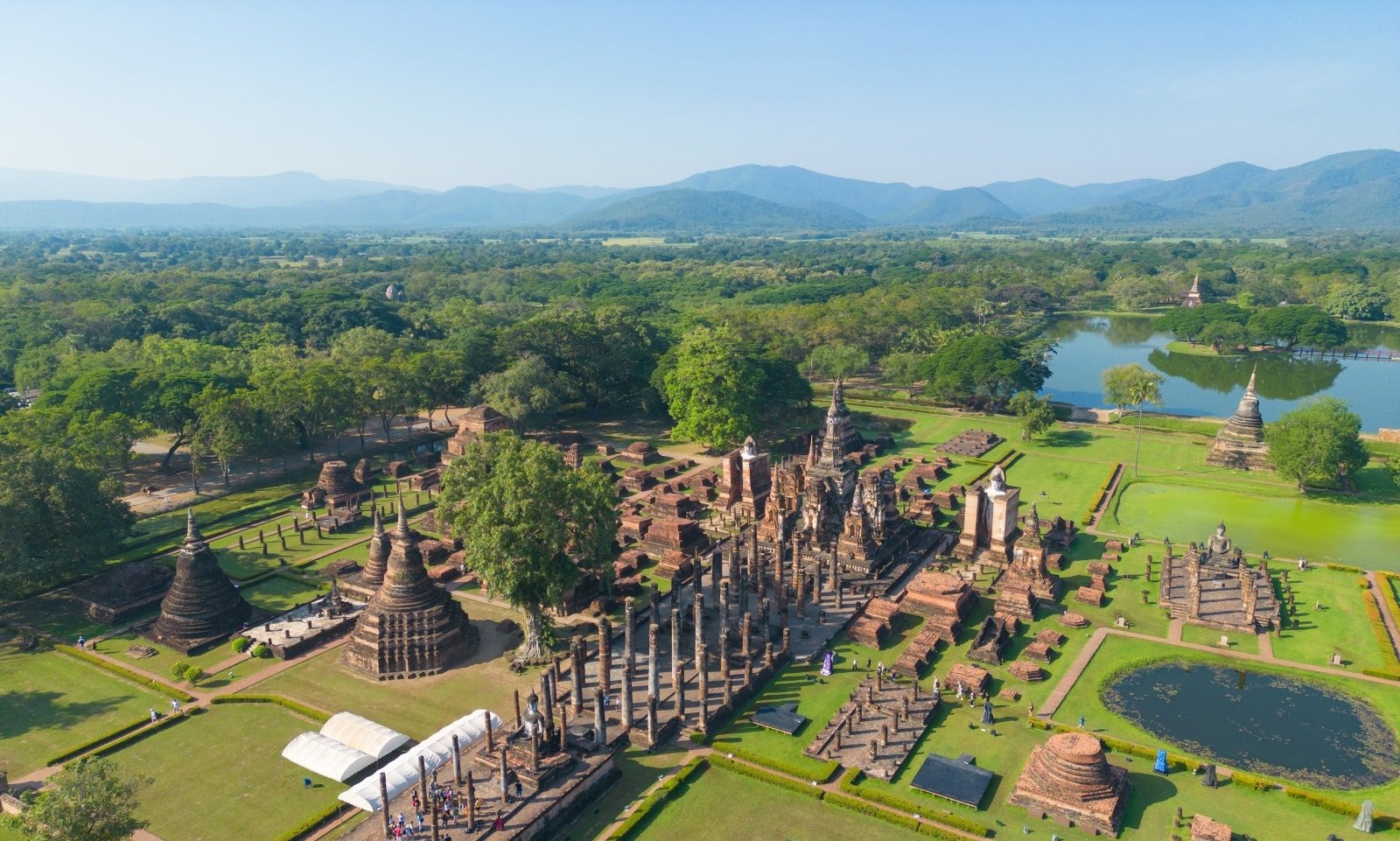
7. Sukhothai
Sukhothai, the first capital of Thailand, is where Thai art, architecture, and language began to develop and flourish. The Sukhothai Historical Park, a UNESCO World Heritage Site, is an archaeological delight with well-preserved ruins and majestic Buddha statues set amidst scenic lakes and gardens.
Exploring this ancient city on a bicycle offers a leisurely and intimate experience of the park’s vast grounds. Highlights include Wat Mahathat, with its impressive central stupa, and Wat Si Chum, known for its gigantic seated Buddha.
The historical significance of Sukhothai, coupled with its serene and picturesque setting, provides a profound insight into the origins of Thai culture and the nation’s early history.
Insider’s Tip: Visit during the Loy Krathong festival in November, when the park is beautifully lit with lanterns.
How To Get There: Sukhothai is accessible by bus or plane from Bangkok and Chiang Mai.
Best Time To Travel: The cool season is the best time to visit, especially around the Loy Krathong festival.
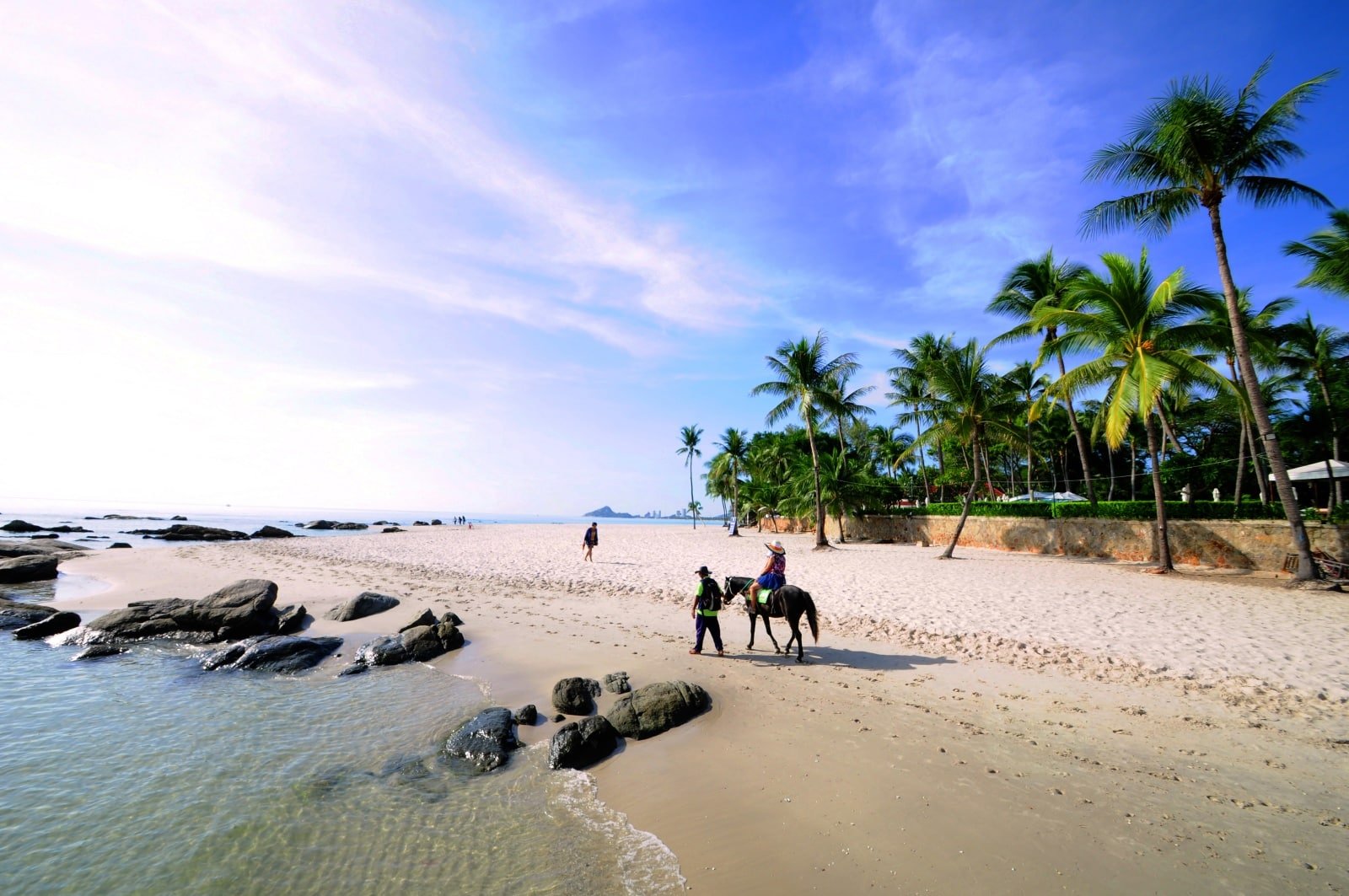
Hua Hin, once a quiet fishing village and now a popular beach resort town, offers a perfect blend of relaxation and cultural experiences. Known for its beautiful beaches, golf courses, and the summer palace of the Thai royal family, Hua Hin exudes an air of sophistication and tranquility.
The night markets in Hua Hin, particularly the Cicada Market, are great for experiencing local crafts and cuisine. Nearby natural attractions like Sam Roi Yot National Park, with its limestone mountains and mangrove forests, provide opportunities for nature exploration.
Hua Hin’s combination of beachside leisure, royal heritage, and natural beauty makes it an ideal destination for those seeking a more laid-back experience in Thailand.
Insider’s Tip: Try the local seafood at the night market, known for its freshness and variety.
How To Get There: Hua Hin is about a three-hour drive from Bangkok and is also accessible by train.
Best Time To Travel: Visit from November to February for the best beach weather and fewer rain showers.
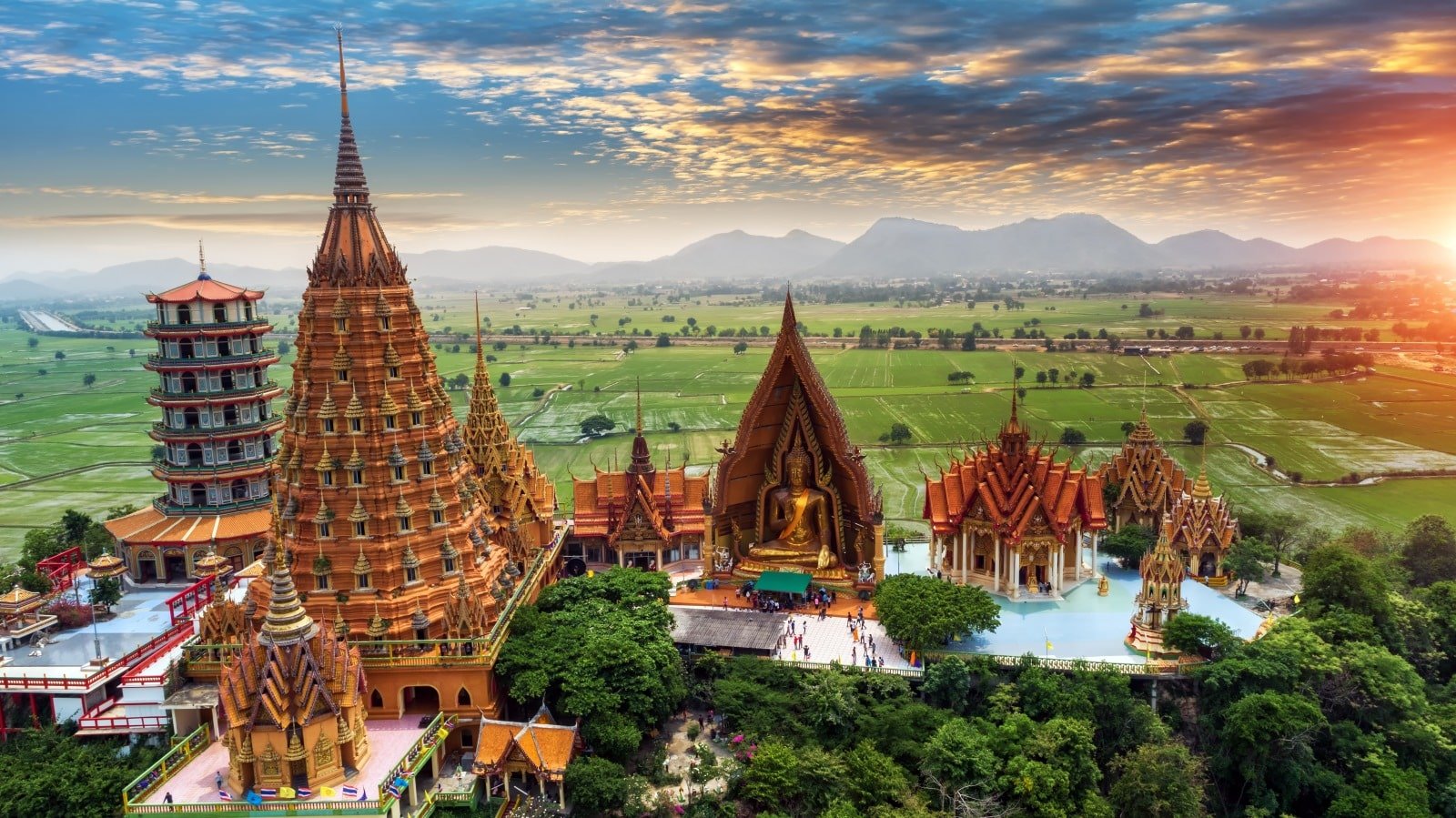
9. Kanchanaburi
Kanchanaburi, known for the Bridge over the River Kwai and its World War II history, offers a poignant reminder of the past, set against a backdrop of stunning natural scenery. The Death Railway, war cemeteries, and museums provide a deep understanding of the region’s wartime history.
Beyond its historical significance, Kanchanaburi is also home to beautiful national parks like Erawan and Sai Yok, offering trekking, waterfalls, and river rafting. The province’s blend of history and natural beauty provides a multifaceted experience, making it a destination that appeals to history buffs and nature lovers.
Insider’s Tip: Take a train ride on the Death Railway for a scenic and historical journey.
How To Get There: Kanchanaburi is accessible by bus or train from Bangkok.
Best Time To Travel: The cool and dry season from November to February is ideal for exploring and outdoor activities.
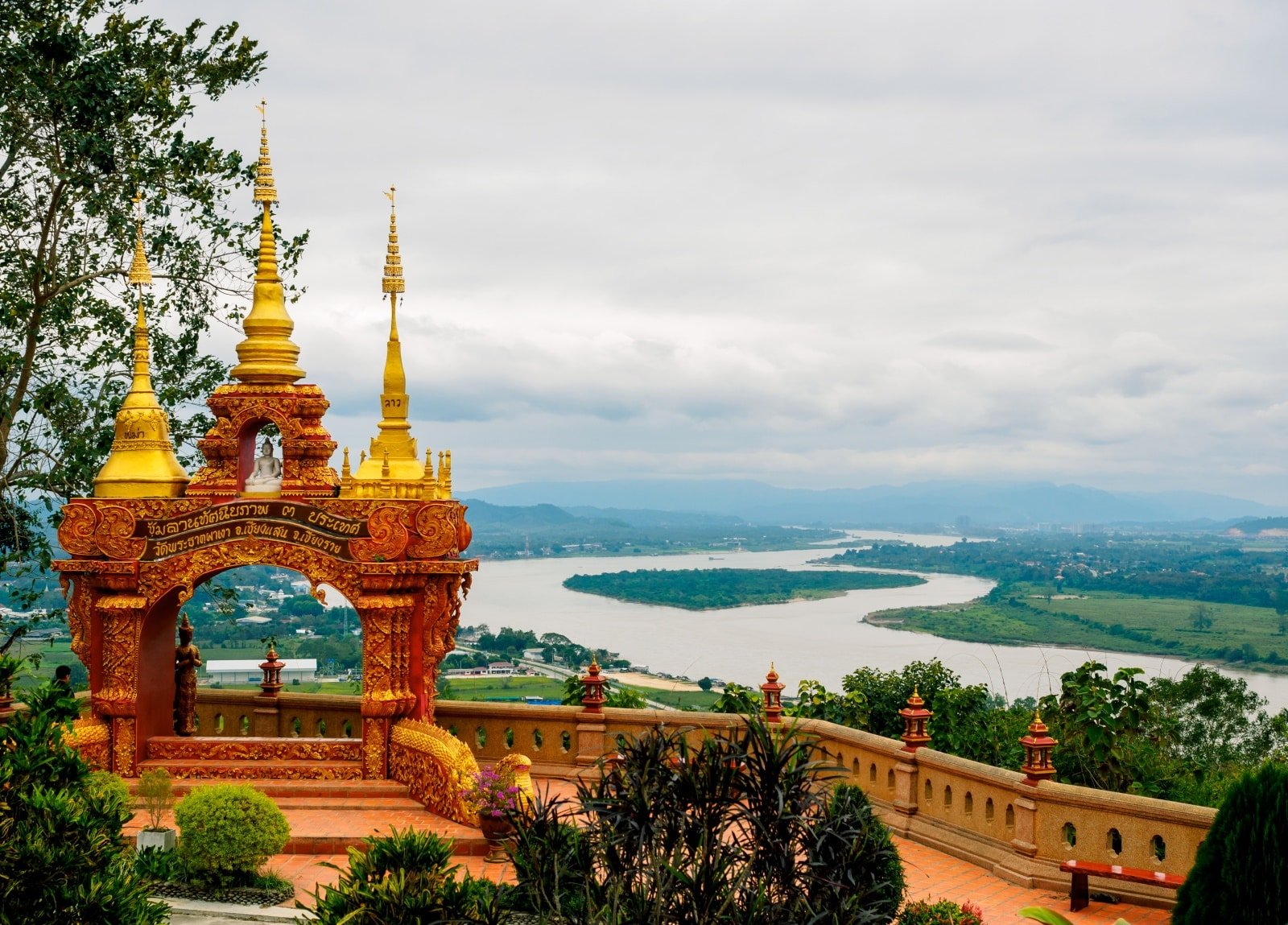
10. The Golden Triangle
The Golden Triangle, where the borders of Thailand, Laos, and Myanmar converge, offers a unique cultural and geographical experience. This area, once notorious for its opium production, now provides insights into the region’s history with attractions like the Hall of Opium Museum.
A boat ride on the Mekong River is a serene way to experience the beauty of this area and the confluence of the three countries. The ancient city of Chiang Saen nearby, with its ruins and temples, adds a historical dimension to your visit. The Golden Triangle’s cultural influences and stunning landscapes make it a fascinating destination in Northern Thailand.
Insider’s Tip: For a panoramic view of the three countries, visit the viewpoint at Wat Phra That Pu Khao.
How To Get There: The Golden Triangle is accessible by bus or car from Chiang Rai.
Best Time To Travel: The cool season, from November to February, offers comfortable weather for exploring.
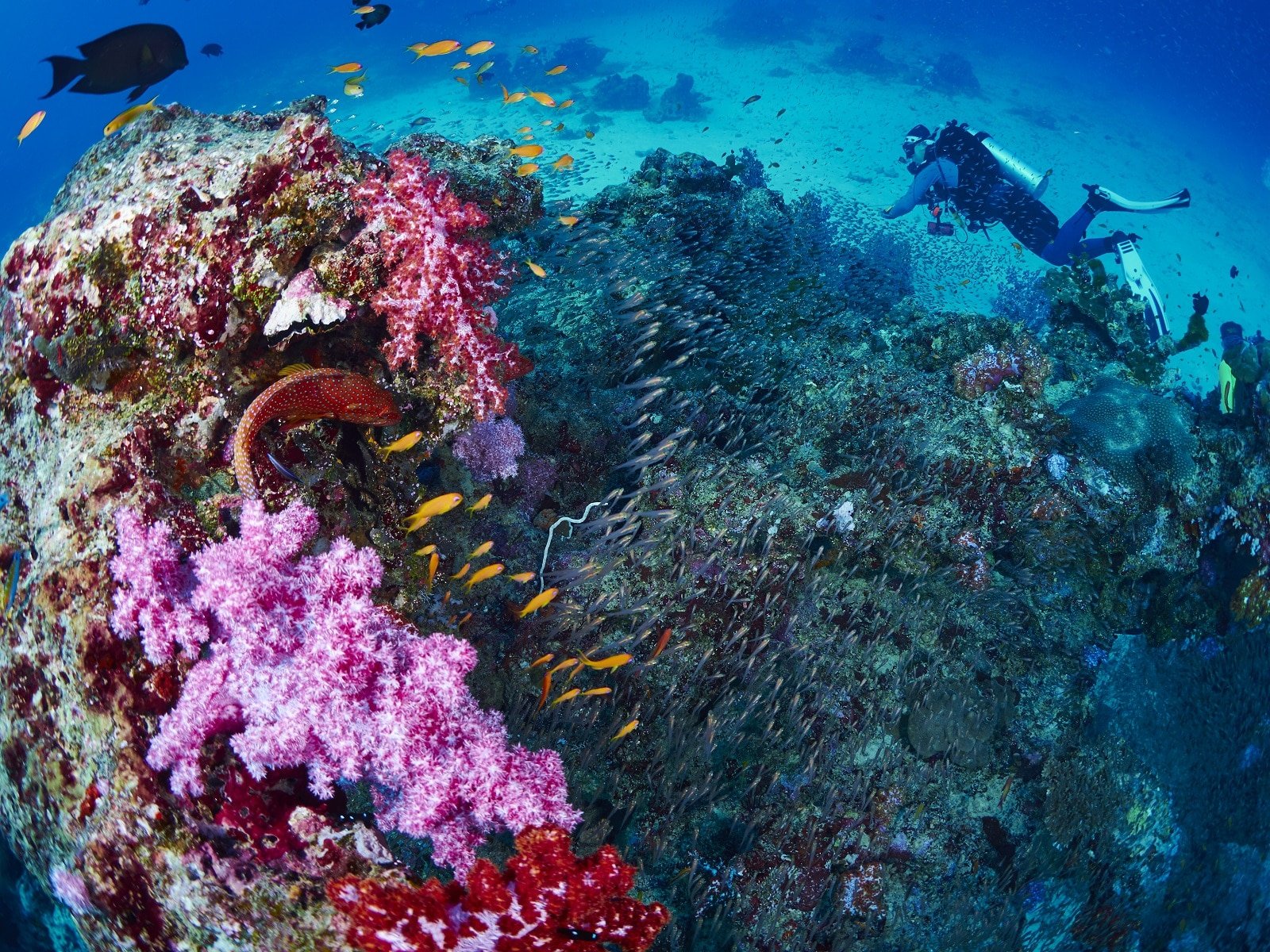
11. Similan Islands
The Similan Islands in the Andaman Sea are a pristine archipelago renowned for their exceptional diving and snorkeling opportunities. These islands, part of a protected national park, boast some of the clearest waters in Thailand, with visibility often extending up to 30 meters.
The underwater landscape of coral reefs teeming with diverse marine life, including manta rays, whale sharks, and a myriad of colorful fish species. Above water, the islands are equally stunning, with powdery white sand beaches and lush tropical forests. The Similan Islands are perfect for a retreat for anyone seeking unspoiled natural beauty.
Whether you’re exploring the depths of the ocean or simply relaxing on a secluded beach, the Similans offer a tranquil escape from the world, where nature’s wonders are on full display.
Insider’s Tip: Book a liveaboard diving trip for an immersive experience in the islands’ underwater world.
How To Get There: The Similan Islands are accessible by boat from Khao Lak or Phuket.
Best Time To Travel: The diving season runs from November to April, with the best conditions from February to April.

12. The Isaan Region
The Isaan region, located in northeastern Thailand, is a land steeped in tradition and history, offering a stark contrast to the country’s more tourist-centric areas. This region is the heartland of Thai culture, where ancient customs and lifestyles are preserved. Isaan’s rural landscapes, dotted with rice paddies and traditional villages, provide a glimpse into a simpler way of life.
The region is also home to some of Thailand’s most significant archaeological sites, including the prehistoric Ban Chiang and the Khmer ruins of Phanom Rung. Isaan’s cuisine, known for its bold flavors and spiciness, is a highlight, with dishes like som tam (spicy papaya salad) and larb (minced meat salad) being local staples
A journey through Isaan is a journey through the soul of Thailand, where the richness of the country’s heritage and the warmth of its people are palpable in every experience.
Insider’s Tip: Try the local dishes like som tam (spicy papaya salad) and larb (minced meat salad) for an authentic taste of Isaan.
How To Get There: Isaan is accessible by bus or train from Bangkok, or by plane to regional airports like Udon Thani.
Best Time To Travel: Visit during the cool season, from November to February, for comfortable travel conditions.
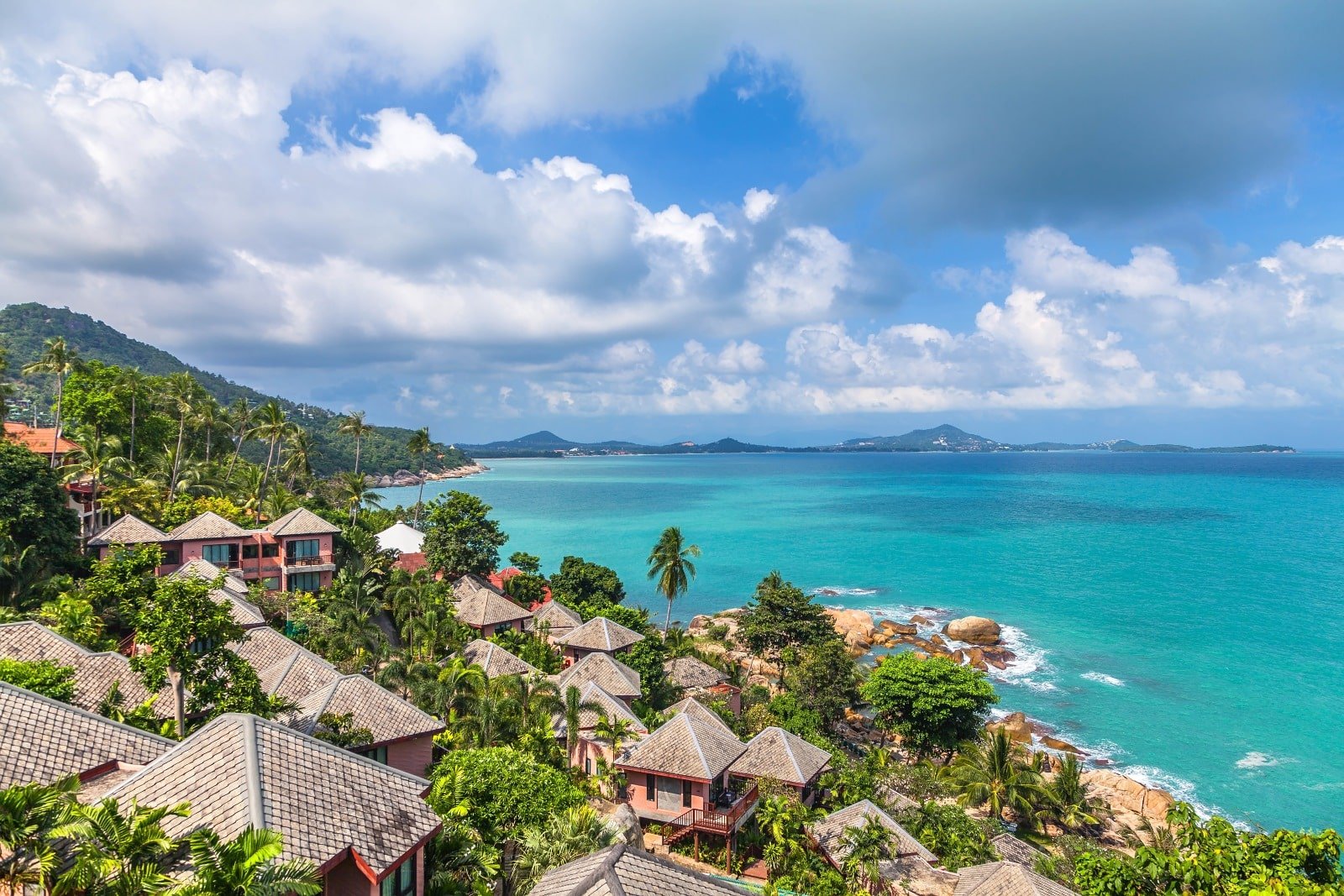
13. Koh Samui
Koh Samui, nestled in the Gulf of Thailand, is a tropical paradise combining natural beauty, luxury, and relaxation. The island is renowned for its idyllic beaches, such as Chaweng and Lamai, which offer crystal-clear waters and powdery white sands. Beyond its stunning coastline, Koh Samui has various attractions, from the majestic Big Buddha statue to the enchanting Na Muang Waterfalls.
The island’s interior is a lush landscape of coconut groves and rainforests, offering opportunities for hiking and exploring. Koh Samui’s culinary scene is a blend of traditional Thai flavors and international cuisine, with a plethora of dining options ranging from beachside shacks to upscale restaurants.
The island’s vibrant nightlife, centered around Chaweng Beach, provides entertainment well into the early hours. Koh Samui caters to all types of travelers seeking a romantic getaway, a family vacation, or a luxurious retreat.
Insider’s Tip: Explore the Ang Thong National Marine Park for stunning landscapes and snorkeling opportunities.
How To Get There: Koh Samui has an airport with flights from Bangkok, Chiang Mai, and international destinations.
Best Time To Travel: The best time to visit is from December to February, with dry weather and calm seas.
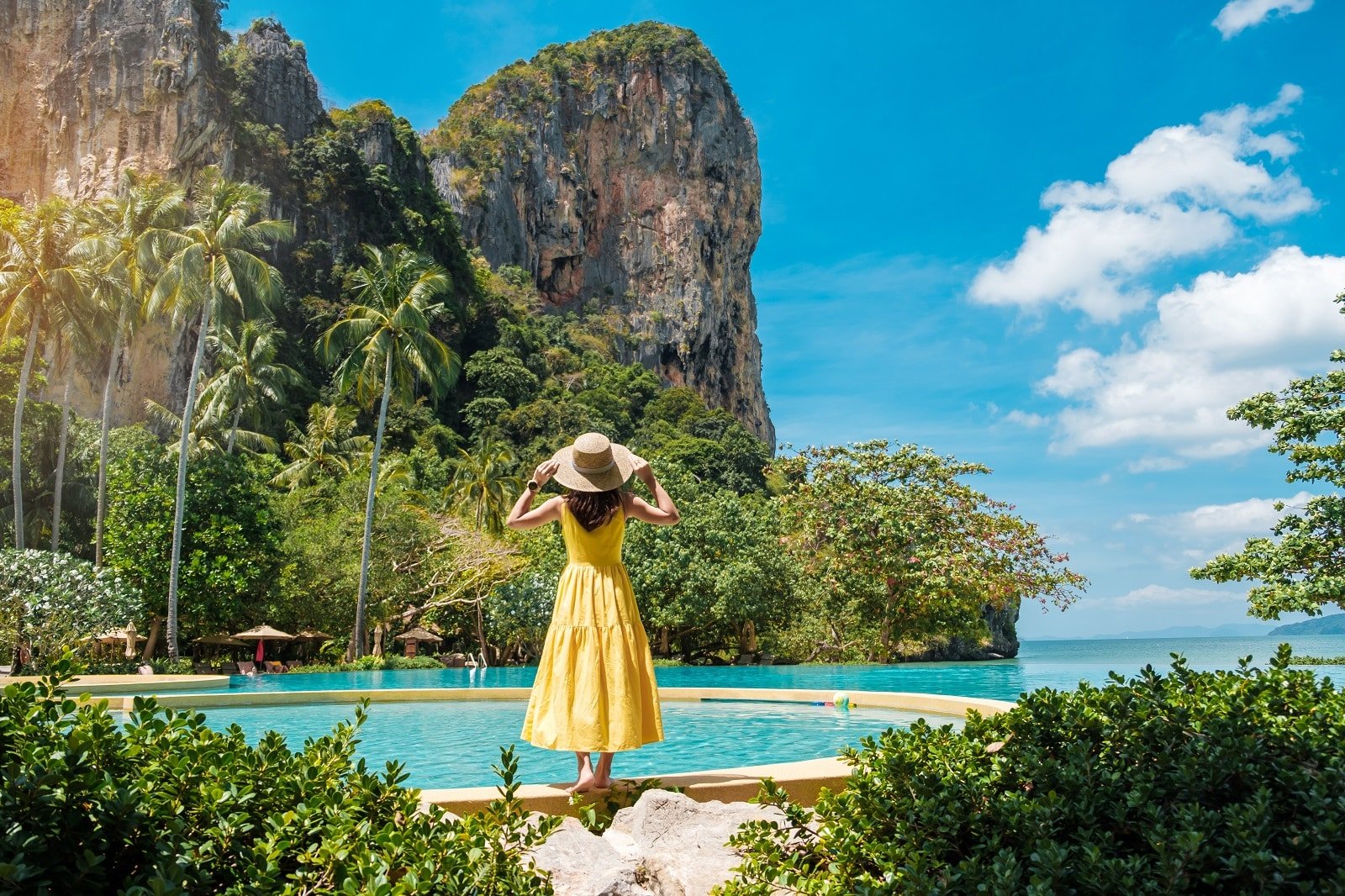
14. Railay Beach
Railay Beach, accessible only by boat, is a hidden gem offering a serene escape from the more crowded tourist spots. This peninsula, known for its stunning limestone cliffs and pristine beaches, is a haven for rock climbers and beachgoers.
The turquoise waters are perfect for swimming and kayaking, while the viewpoints and caves provide opportunities for exploration. Railay maintains a laid-back atmosphere, with a small selection of bars and restaurants, making it an ideal spot for adventure and relaxation in a tranquil setting.
Insider’s Tip: Take a rock climbing course if you’re a beginner to safely enjoy the sport under expert guidance.
How To Get There: Railay Beach is accessible by boat from Ao Nang or Krabi Town.
Best Time To Travel: Visit from November to April when the weather is dry, and the seas are calm.
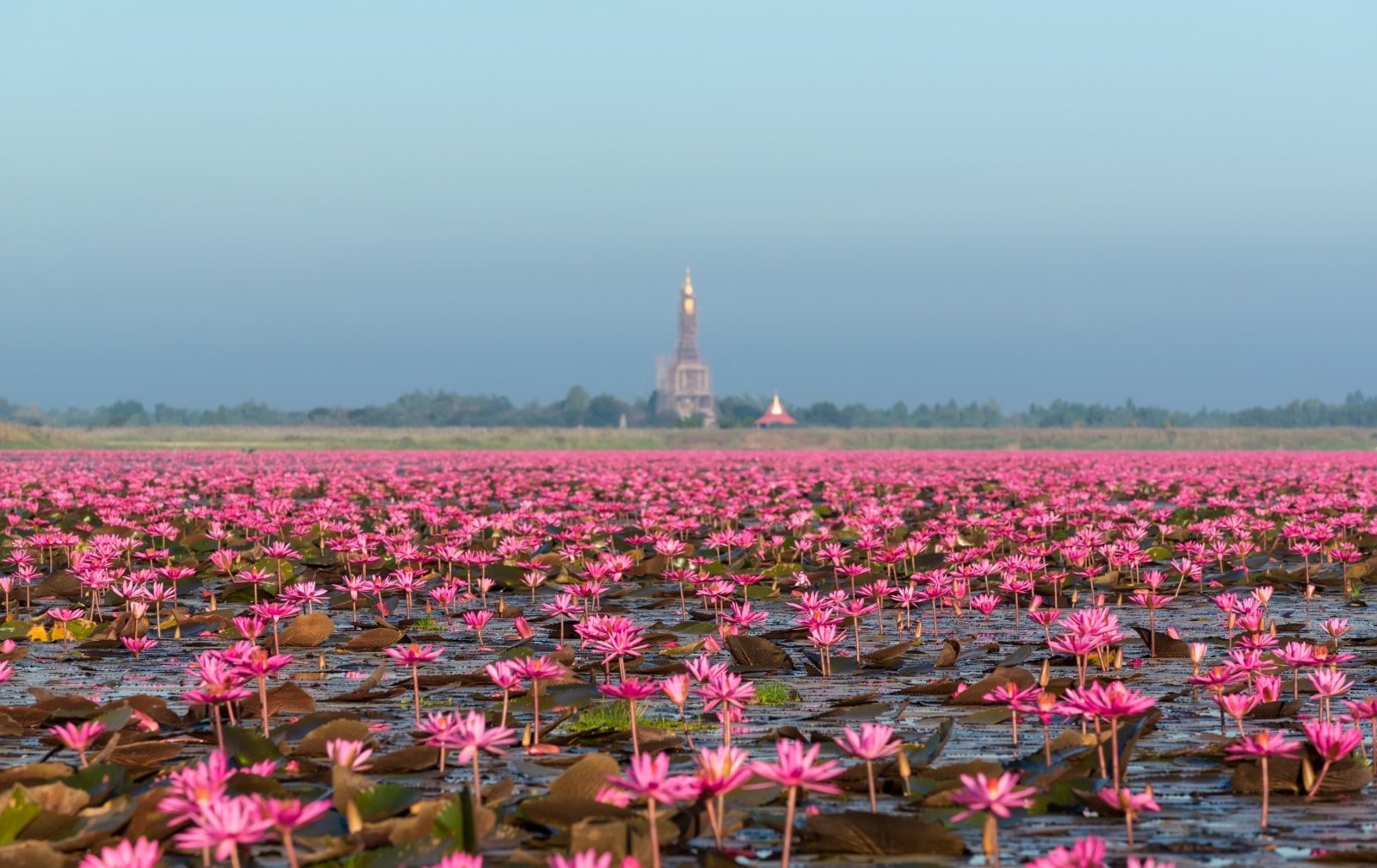
15. Udon Thani and the Red Lotus Sea
Udon Thani, a vibrant city in Thailand’s northeastern region, is the gateway to the mesmerizing Red Lotus Sea (Lake Nong Han). It’s best visited in the cool season, as it transforms into a breathtaking expanse of pink and red lotuses stretching as far as the eye can see. A boat ride through the serene waters, dotted with these vibrant blooms, offers a truly unique and tranquil experience.
Beyond the lake, Udon Thani boasts a rich cultural heritage, with various temples, museums, and markets reflecting the local Isan culture. The Ban Chiang Archaeological Site, a UNESCO World Heritage Site near Udon Thani, provides fascinating insights into the region’s ancient history.
This area’s blend of natural beauty and cultural depth makes it a compelling destination for those exploring beyond Thailand’s typical tourist paths.
Insider’s Tip: Visit early in the morning when the lotuses are fully bloomed and the lake is less crowded.
How To Get There: Udon Thani is accessible by plane from Bangkok, and the Red Lotus Sea is a short drive from the city.
Best Time To Travel: The lotuses bloom from December to February, making it the ideal time to visit.
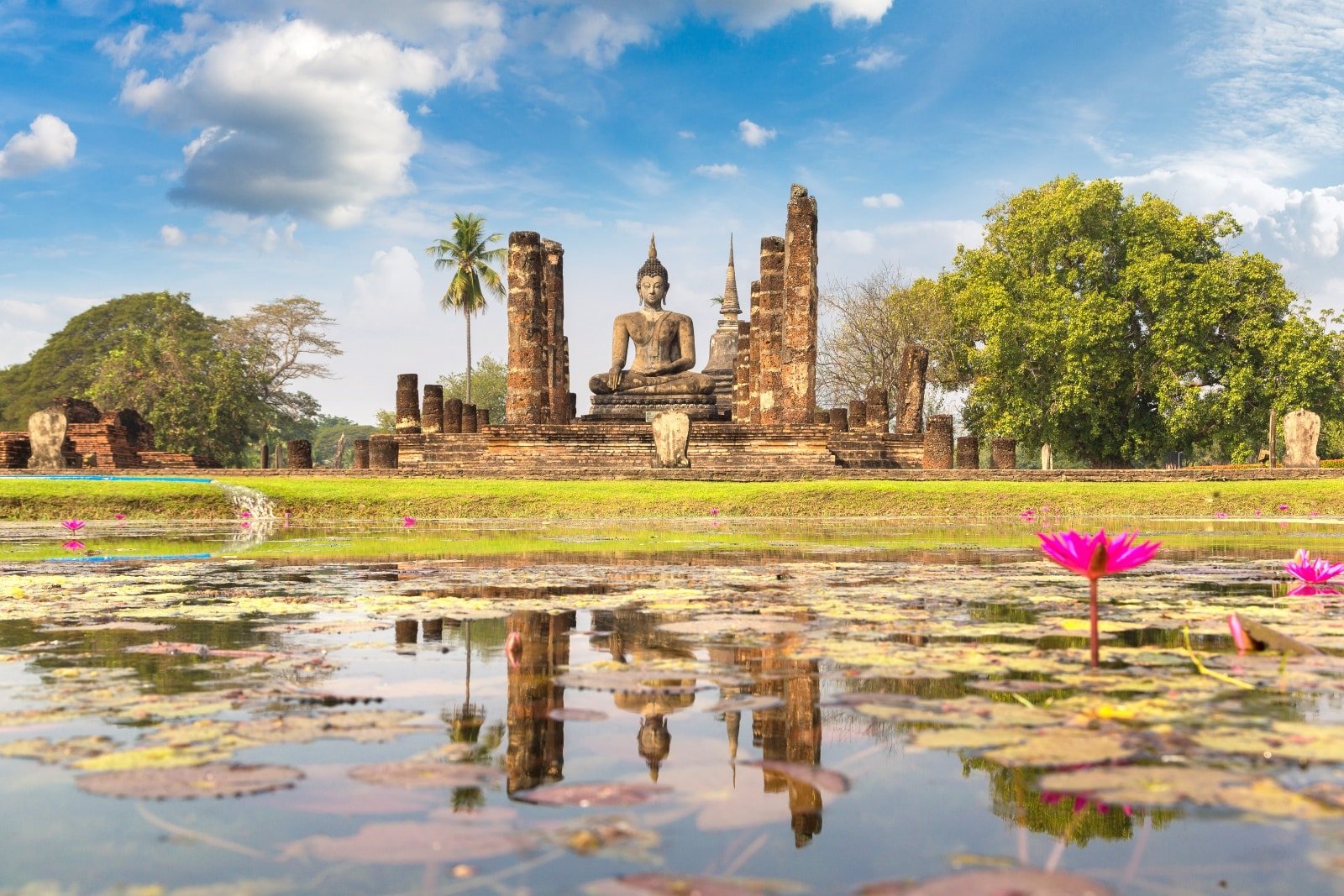
16. The Ancient City of Sukhothai
The ancient city of Sukhothai, a UNESCO World Heritage Site, is a journey back in time to the roots of Thai civilization. As the first capital of Thailand, it holds a special place in the nation’s history. The Sukhothai Historical Park, with its well-preserved ruins set amidst lush greenery and tranquil ponds, offers a glimpse into the grandeur of the 13th-century Sukhothai Kingdom.
Exploring the park, you’ll encounter majestic Buddha figures, towering stupas, and intricate carvings, all evocative of the city’s past splendor. Cycling through the park’s vast grounds allows for an intimate exploration of its numerous sites, including Wat Mahathat, the park’s largest temple, and Wat Si Chum, famous for its gigantic seated Buddha. A visit to Sukhothai immerses ancient Thailand’s artistic and spiritual legacy.
Insider’s Tip: Rent a bicycle to explore the extensive grounds of the historical park at your own pace.
How To Get There: Sukhothai is accessible by bus or plane from Bangkok, and the historical park is a short ride from the city center.
Best Time To Travel: The cool season from November to February offers pleasant weather for exploring the outdoor ruins.
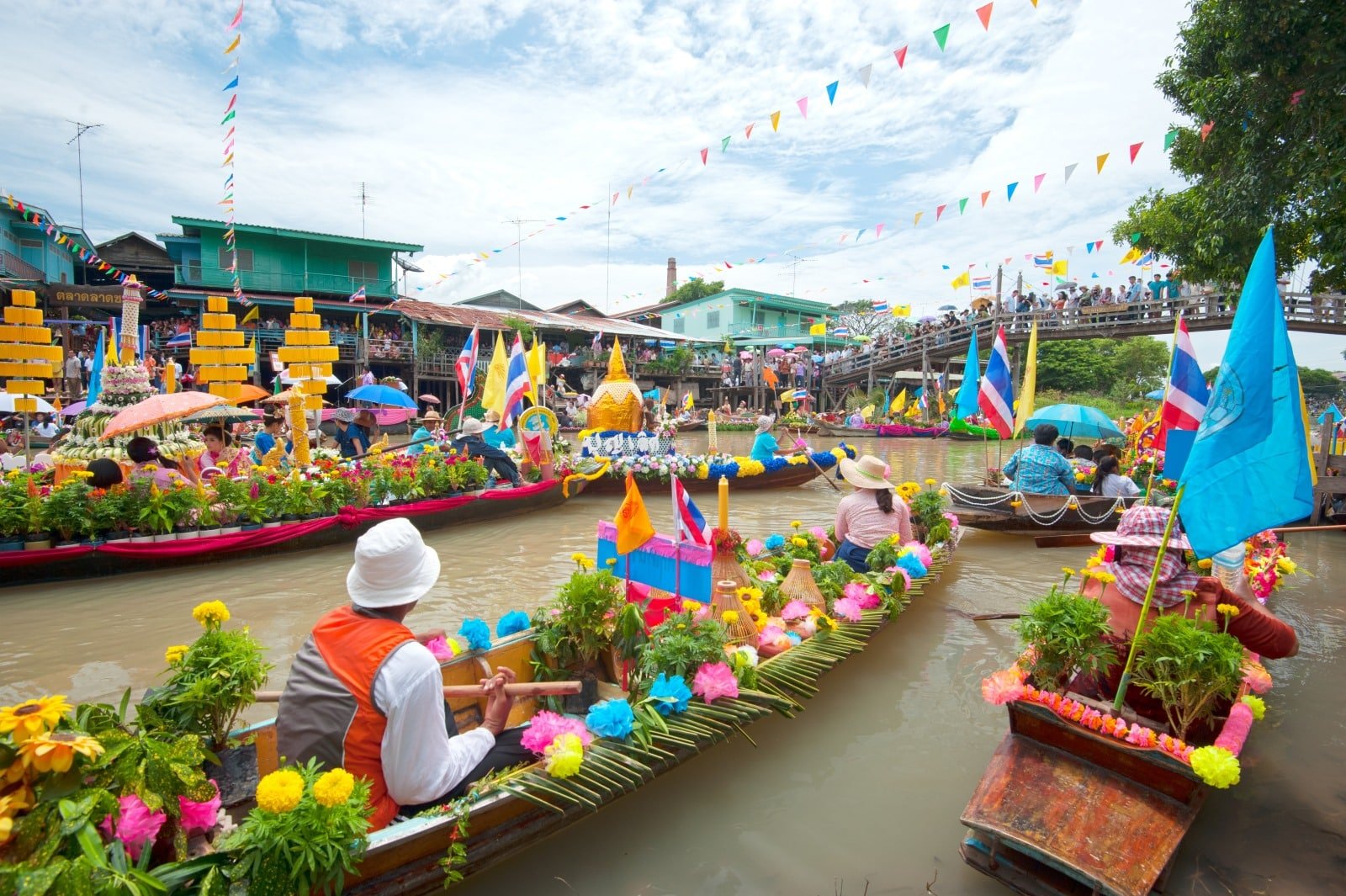
17. The Floating Markets Near Bangkok
The floating markets near Bangkok, such as Damnoen Saduak and Amphawa, offer a vibrant and colorful glimpse into traditional Thai life. These bustling waterways, lined with boats laden with fresh produce, local delicacies, and handicrafts, present a lively and picturesque scene.
A visit to these markets is a sensory experience, with the sights, sounds, and smells of authentic Thai commerce and cuisine. Damnoen Saduak, the most famous of these markets, provides a more tourist-focused experience, while Amphawa offers a more local atmosphere and is primarily known for its evening seafood vendors.
Exploring these floating markets by boat or along the canalside walkways is a unique way to experience the local culture and indulge in some of Thailand’s most delicious foods and charming souvenirs.
Insider’s Tip: Take a boat tour to fully experience the market and try local snacks from the floating vendors.
How To Get There: The floating markets are accessible by bus or organized tours from Bangkok.
Best Time To Travel: Visit early in the morning to avoid the crowds and the heat.
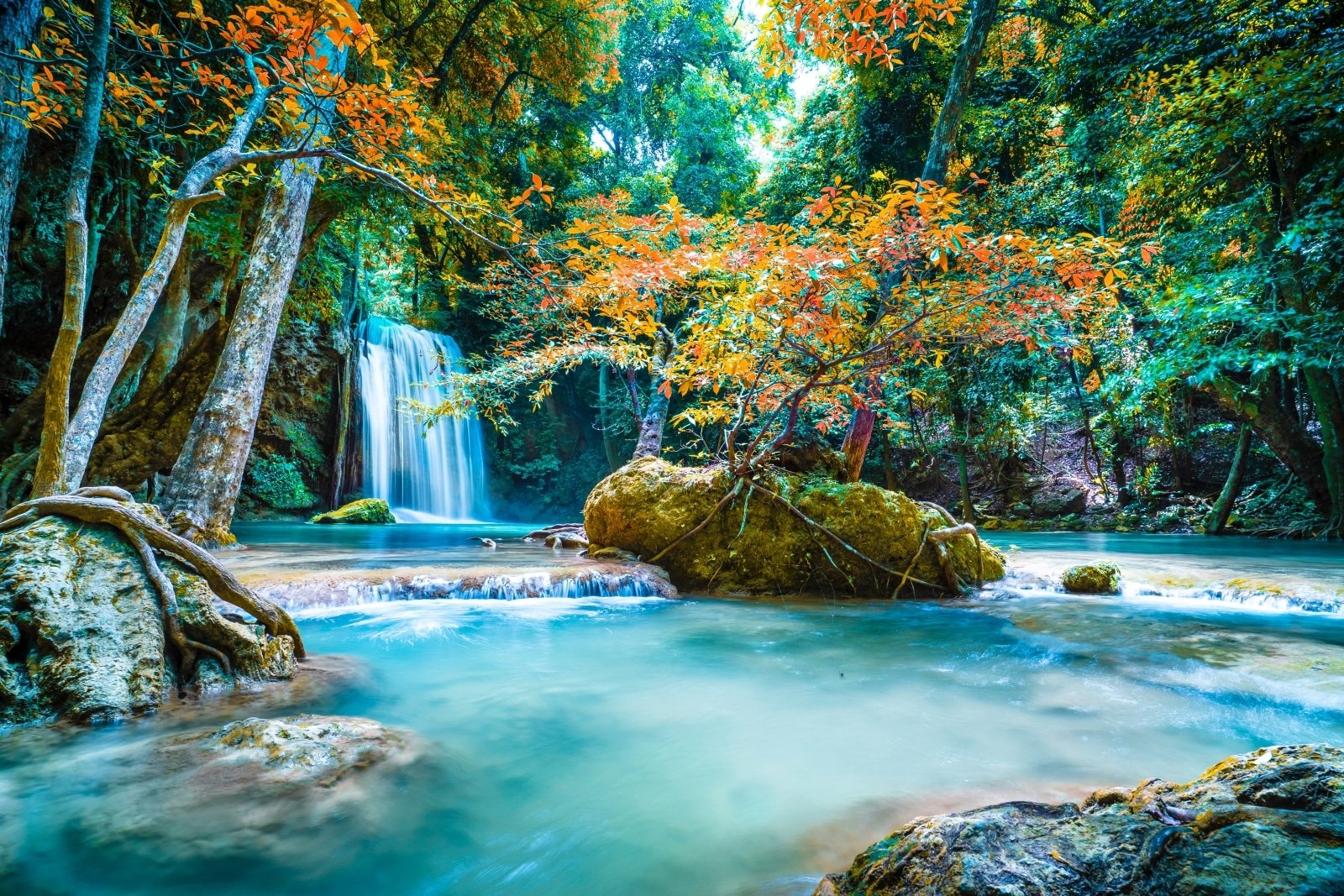
18. Erawan National Park and Waterfalls
Erawan National Park, located in the Kanchanaburi Province, is a natural oasis known for its stunning seven-tiered Erawan Waterfall, named after the three-headed elephant of Hindu mythology. Each tier of the waterfall offers a different shape and character, with natural pools perfect for swimming and relaxation.
The park’s lush forests are home to plentiful wildlife and provide numerous hiking trails for nature enthusiasts. Beyond the waterfalls, the park’s caves, such as Tham Phra That and Tham Ta Duang, offer further exploration opportunities.
Visiting Erawan National Park is a chance to witness one of Thailand’s most beautiful waterfalls and connect with the country’s rich natural landscapes.
Insider’s Tip: Bring swimwear and trek to the upper tiers of the waterfall for a more secluded and serene experience.
How To Get There: The park is located in Kanchanaburi Province and is accessible by bus or car from Bangkok.
Best Time To Travel: Visit from November to April when the water levels are ideal for swimming and the trails are dry.
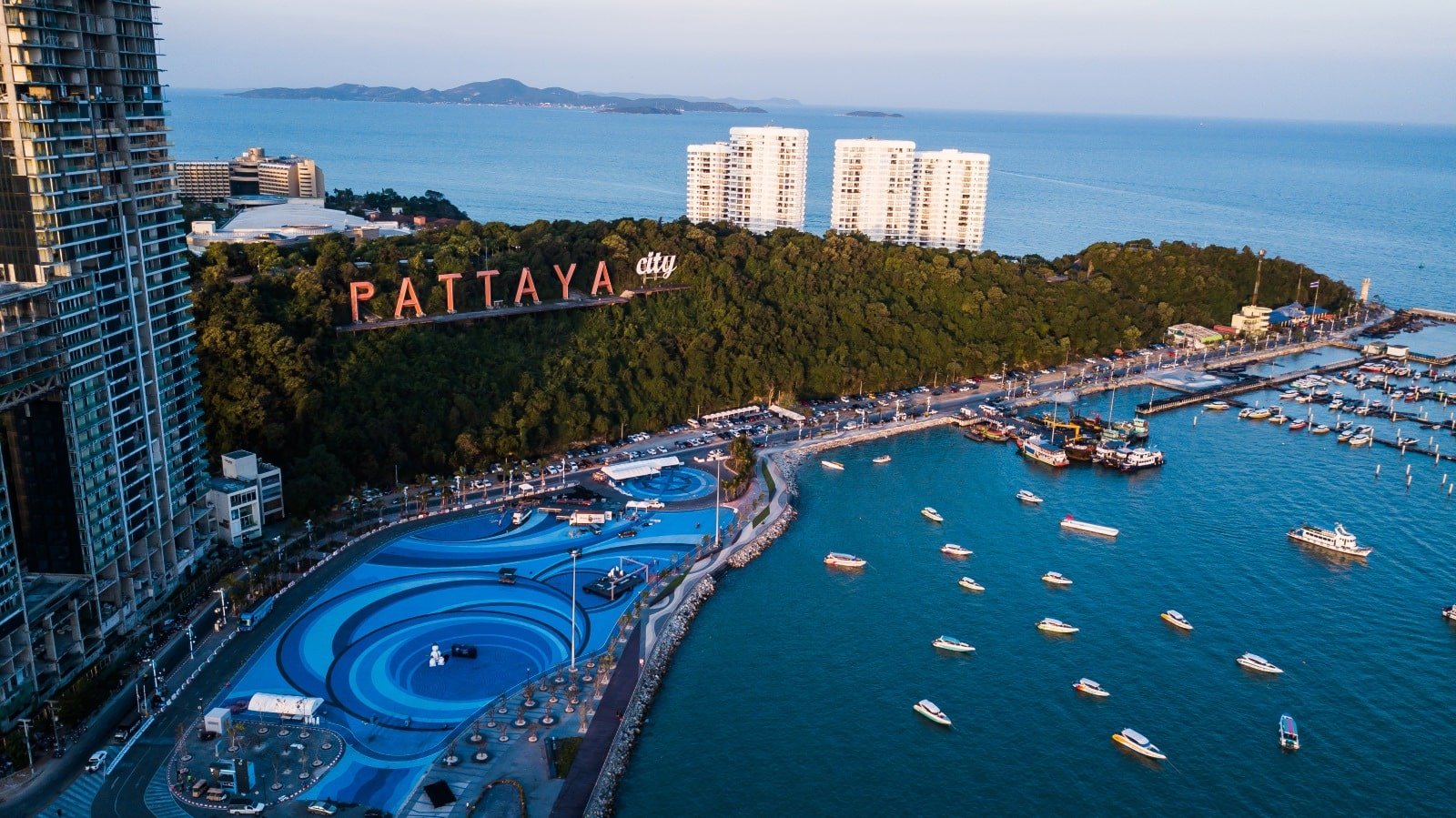
19. Pattaya
Pattaya, once a quiet fishing village and now a bustling coastal city, is known for its vibrant nightlife, sandy beaches, and many tourist attractions. While Pattaya’s reputation is often tied to its entertainment and nightlife, the city offers much more. The Sanctuary of Truth, a stunning all-wood structure filled with intricate carvings, highlights traditional Thai craftsmanship.
For nature lovers, Pattaya offers the Nong Nooch Tropical Botanical Garden, a beautifully landscaped park with themed gardens and cultural shows. The nearby Coral Island (Koh Larn) provides a quick escape to quieter beaches and clear waters, ideal for snorkeling and water sports. Pattaya’s diverse offerings make it a destination that caters to various interests, from cultural exploration to beachside relaxation.
Insider’s Tip: Explore the Pattaya Floating Market for a cultural experience and to sample local Thai dishes.
How To Get There: Pattaya is a two-hour drive from Bangkok and is also accessible by bus or taxi.
Best Time To Travel: Visit from November to February for pleasant weather and to avoid the rainy season.
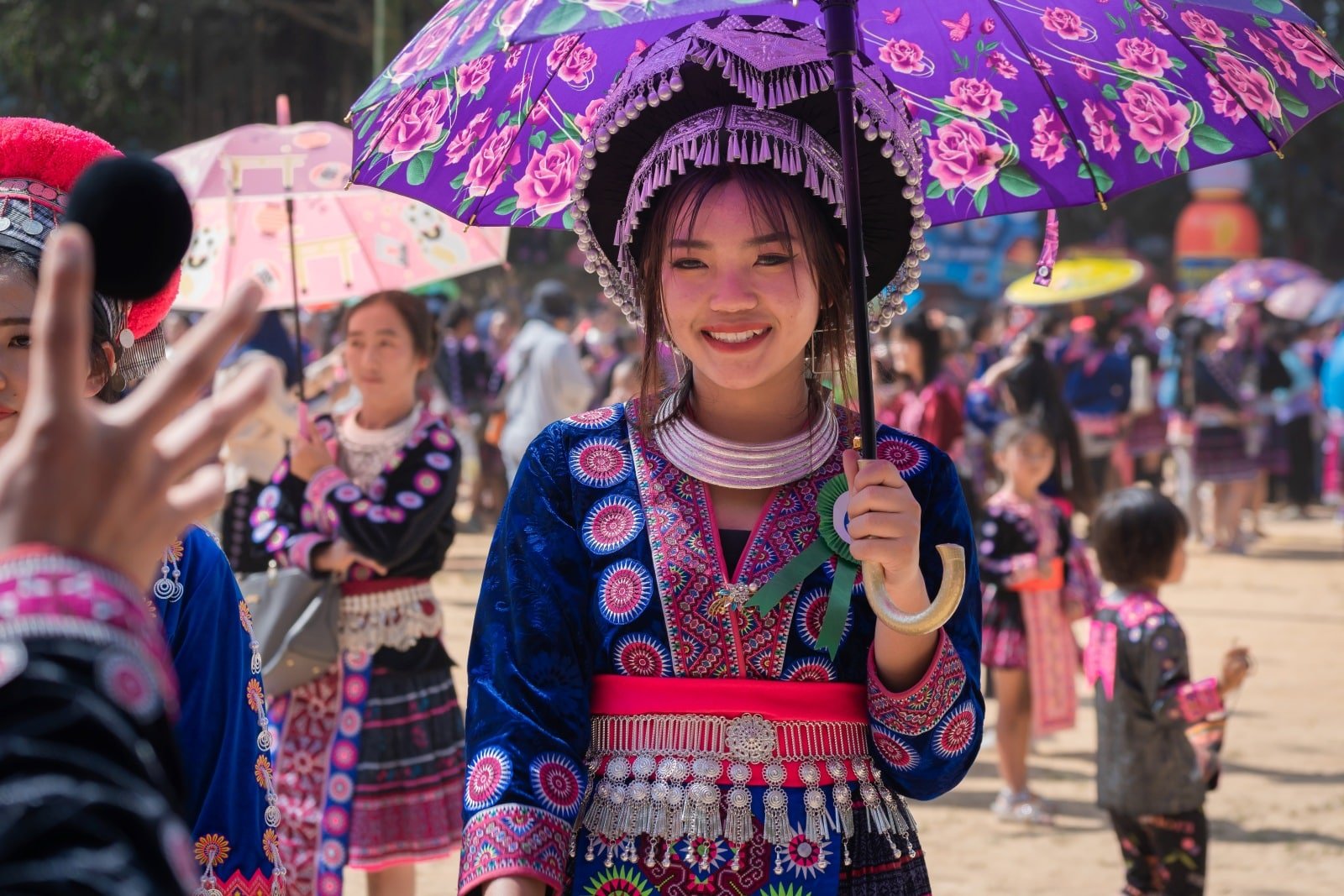
20. The Hill Tribes of Northern Thailand
Northern Thailand’s hill tribes offer a unique cultural experience, distinct from the rest of the country. These ethnic groups, including the Karen, Hmong, Akha, and Lisu, each have their own customs, languages, and traditional dress. Visiting these hill tribe villages, often nestled in the picturesque mountains and valleys of the region, provides insight into their traditional ways of life, which remain largely untouched by modernization.
Responsible and respectful tourism is key when visiting these communities. Many villages welcome visitors to learn about their culture, participate in traditional crafts, and even stay overnight for a more immersive experience. Engaging with the hill tribes of Northern Thailand offers a deeper understanding of the country’s ethnic diversity and rich cultural tapestry.
Insider’s Tip: Choose a community-based tourism program that benefits the tribes directly and respects their culture.
How To Get There: Hill tribe villages are accessible from Chiang Mai or Chiang Rai, often as part of guided tours.
Best Time To Travel: The cool season, from November to February, is comfortable for visiting the highland areas.
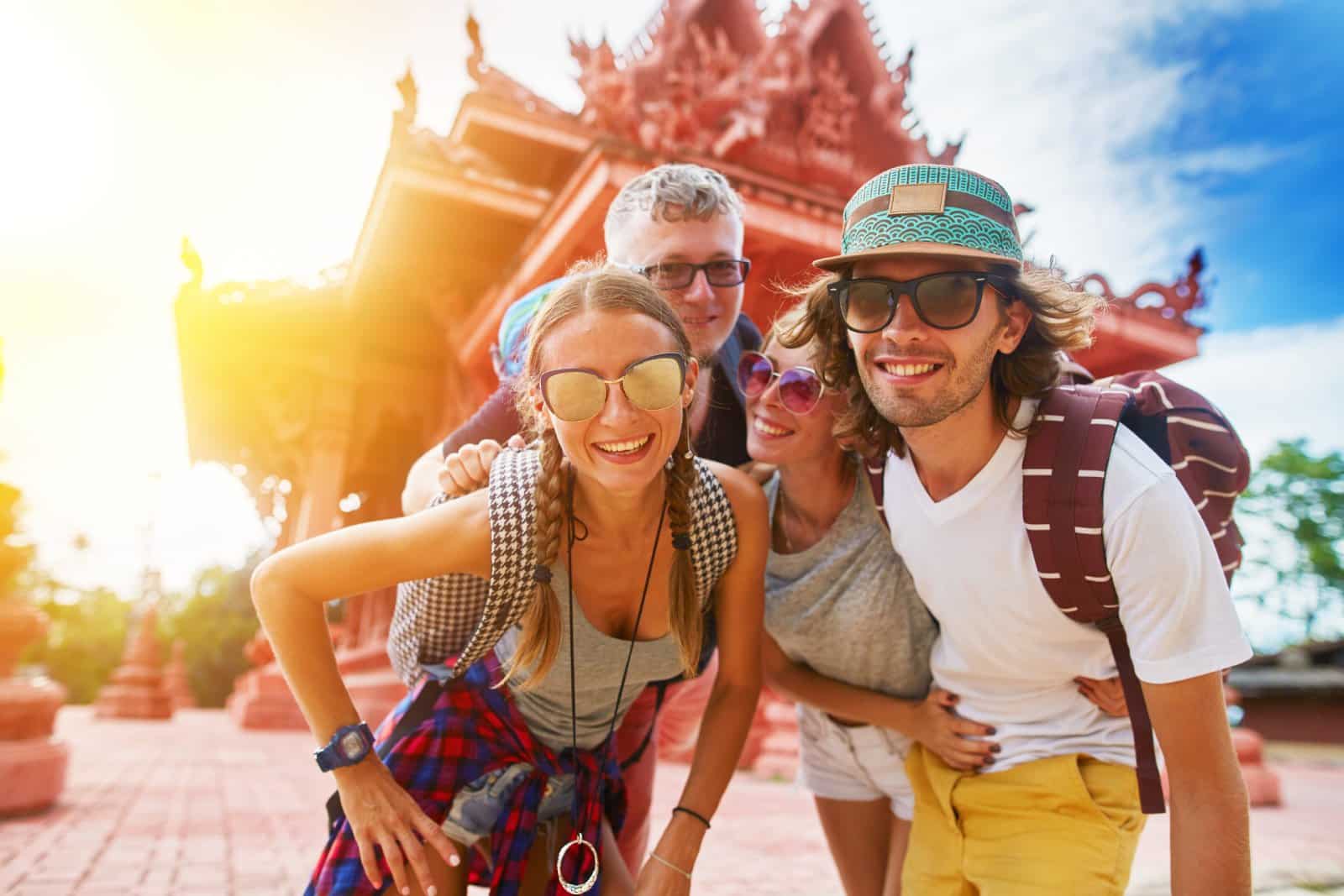
The Bottom Line
Thailand’s magic lies in its diversity – from bustling cities and ancient ruins to serene beaches and lush jungles. As you explore this enchanting country, embrace its history, indulge in its culinary delights, and immerse yourself in its natural beauty. Remember, Thailand offers an experience beyond the ordinary, leaving you with memories that will last a lifetime.
While exploring Thailand, take the time to learn a few phrases in Thai. A simple “hello” (sawasdee) or “thank you” (khob khun) can go a long way in showing respect for the local culture and enhancing your travel experience.
More Articles Like This…
Barcelona: Discover the Top 10 Beach Clubs
2024 Global City Travel Guide – Your Passport to the World’s Top Destination Cities
Exploring Khao Yai 2024 – A Hidden Gem of Thailand
The post Discover Thailand: Your Ultimate Guide to 20 Incredible Destinations in 2024 republished on Passing Thru with permission from The Green Voyage .
Featured Image Credit: Shutterstock / Pikoso.kz.
For transparency, this content was partly developed with AI assistance and carefully curated by an experienced editor to be informative and ensure accuracy.
More for You
‘A big mistake’: Ex-Trump White House lawyer reacts to Trump’s mention of Charlottesville
19 Things That Will Happen When You Stop Drinking Alcohol
29 common human foods you may not realize are poisonous to your dog
This is the salary it takes to be considered rich in every state
Megan Fox Signs With UTA
Do I have to pay off my spouse's debts when they die? Here's what you're responsible for and what you aren't after a loved one's death
One of these pictures of me is real and the other is AI – but which is which?
Trump campaign accused of breaking federal law by hiding millions in legal payments
How Much Beer You'd Have To Drink To Equal A Single Shot Of Liquor
19 Things People Treat As Safe That Actually Are Pretty Dangerous
Here’s What the US Minimum Wage Was the Year You Were Born
Scientists claim people with this blood type more likely to have early stroke
This is one of the most advanced humanoid robots in the world
See the UK destroyer crew that scored the Royal Navy's first missile kill since the Gulf War
NYPD Chief Hits Back at AOC over Columbia Anti-Israel Protests: ‘Self-Entitlement’ Doesn’t ‘Supersede the Law’
223 vs 556: What's the Difference?
Average US annual salary by age revealed – see how you compare
5 Things the Average Retiree Won’t Be Able to Afford in the Next 5 Years
4 Supplements You Shouldn't Take If You're Trying to Lose Weight, According to Dietitians
Scientists have discovered the maximum age a human can live to

Enjoy fast, free delivery, exclusive deals, and award-winning movies & TV shows with Prime Try Prime and start saving today with fast, free delivery
Amazon Prime includes:
Fast, FREE Delivery is available to Prime members. To join, select "Try Amazon Prime and start saving today with Fast, FREE Delivery" below the Add to Cart button.
- Cardmembers earn 5% Back at Amazon.com with a Prime Credit Card.
- Unlimited Free Two-Day Delivery
- Streaming of thousands of movies and TV shows with limited ads on Prime Video.
- A Kindle book to borrow for free each month - with no due dates
- Listen to over 2 million songs and hundreds of playlists
- Unlimited photo storage with anywhere access
Important: Your credit card will NOT be charged when you start your free trial or if you cancel during the trial period. If you're happy with Amazon Prime, do nothing. At the end of the free trial, your membership will automatically upgrade to a monthly membership.
Buy new: $19.99

Download the free Kindle app and start reading Kindle books instantly on your smartphone, tablet, or computer - no Kindle device required .
Read instantly on your browser with Kindle for Web.
Using your mobile phone camera - scan the code below and download the Kindle app.

Image Unavailable

- To view this video download Flash Player

Exploring Thailand: With Facts About History, Culture And Essential Travel And Budgeting Tips Paperback – Large Print, April 14, 2024
Purchase options and add-ons.
- Print length 110 pages
- Language English
- Publication date April 14, 2024
- Dimensions 6 x 0.25 x 9 inches
- ISBN-13 979-8322841999
- See all details

Product details
- ASIN : B0D1P2PK2R
- Publisher : Independently published (April 14, 2024)
- Language : English
- Paperback : 110 pages
- ISBN-13 : 979-8322841999
- Item Weight : 7.8 ounces
- Dimensions : 6 x 0.25 x 9 inches
Customer reviews
Customer Reviews, including Product Star Ratings help customers to learn more about the product and decide whether it is the right product for them.
To calculate the overall star rating and percentage breakdown by star, we don’t use a simple average. Instead, our system considers things like how recent a review is and if the reviewer bought the item on Amazon. It also analyzed reviews to verify trustworthiness.
No customer reviews
- Amazon Newsletter
- About Amazon
- Accessibility
- Sustainability
- Press Center
- Investor Relations
- Amazon Devices
- Amazon Science
- Sell on Amazon
- Sell apps on Amazon
- Supply to Amazon
- Protect & Build Your Brand
- Become an Affiliate
- Become a Delivery Driver
- Start a Package Delivery Business
- Advertise Your Products
- Self-Publish with Us
- Become an Amazon Hub Partner
- › See More Ways to Make Money
- Amazon Visa
- Amazon Store Card
- Amazon Secured Card
- Amazon Business Card
- Shop with Points
- Credit Card Marketplace
- Reload Your Balance
- Amazon Currency Converter
- Your Account
- Your Orders
- Shipping Rates & Policies
- Amazon Prime
- Returns & Replacements
- Manage Your Content and Devices
- Recalls and Product Safety Alerts
- Conditions of Use
- Privacy Notice
- Consumer Health Data Privacy Disclosure
- Your Ads Privacy Choices
Klook Plans Partnership with Thailand as the Country Skyrockets in Popularity
Jesse Chase-Lubitz , Skift
April 25th, 2024 at 2:33 PM EDT
Thailand remains a strong destination post Covid. Tour operators are flocking to the country and playing a significant role in how travel evolves.
Jesse Chase-Lubitz
Klook, a leading platform for travel experiences in Asia, signed a letter of intent with the Tourism Authority of Thailand to boost experiences in the country. The company is hoping to double the number of bookings it has for tourism packages to Thailand this year.
Klook says it is focusing on events, from Muay Thai matches to music festivals to Michelin visits and river cruises. The collaboration should have a particular impact on ticketing, as it allows the company to offer an integrated booking experience to major festivals and top attractions.
Klook is also planning to promote the less obvious attractions and support small to medium operators by providing digitalization tools that can bring offerings online and showcase them to a global audience.
Thailand Gaining in Popularity
Thailand is a long-time travel favorite and it bounced back strong after COVID. Klook says the country has had a 44% growth in foreign tourist arrivals over the past year and a Travel Pulse survey shows that travelers are looking to increase their target budgets for Thailand in 2024 by up to 50%.
The Tourism Authority of Thailand conducted its own survey echoing these results . They found that tourists are spending more on luxury accommodations despite higher airfares and that the use of online platforms for travel arrangements is rising, with tour operators “still playing a significant role.”
Other tour operators, such as EF World Journeys, which offers educational tours, say Thailand is a growing favorite for North American travelers and that it remains one of the top three most popular destinations in Asia.
“Year-to-date, EF Go Ahead Tours has realized nearly 60% year-over-year growth in bookings to Thailand, adding several new tour offerings in the country to meet the demand in the region,” says Heidi Durflinger, President of EF World Journeys which operates two of their offerings.
“Based on our trending destinations data, which is based on thousands of demand indicators amongst younger adult travelers (18-35), tours in Thailand have been a consistent top 5 destination for bookings during Spring Break, but we are also seeing strong demand for Thailand from travelers seeking international beach vacations all year round,” said Heather Leisman, President, EF Ultimate Break.
The Daily Newsletter
Our daily coverage of the global travel industry. Written by editors and analysts from across Skift’s brands.
Have a confidential tip for Skift? Get in touch
Tags: Klook , thailand , tourism
Photo credit: Klook & Thailand Tourism Authority Tuk Tuk at Wat Ratchanadda and the Loha Prasat, Buddhist temples in Bangkok. Source: Klook

COMMENTS
Plan your sightseeing and activities with our recommendations. Explore attractions, book tours, and immerse yourself in the local culture. Show All. Recommendations - Attractions. The Solo Traveller's Guide to Northern Thailand. Recommendations - Sea Experiences. The Best Waterside Restaurants in Thailand.
Cultural Tours & Holidays in Thailand. A culture trip of Thailand lets you learn secrets of ancient times, meet welcoming locals and listen to folklore that has stood the test of time. With 205 cultural adventures lasting from 1 days to 29 days, you're sure to experience a true cultural immersion.
You can wander on your own at any hour - midnight is a good time, to see the arrival of millions of fresh flowers - or learn how to identify and prepare your own. Check out The Market Experience by Expique for its traditional tour and garland-making class. 16. Give in to your sweet tooth at Baan Dok Pud.
18. Royal Grand Palace and Bangkok Temples: Half Day Tour. 88. Bus Tours. 4-5 hours. Discover some of Bangkok's top cultural sights on a half-day private tour of the Grand Palace, Wat Pho, and Wat Traimit. …. Recommended by 90% of travelers. $103. 19.
Immerse yourself in Thai culture with this comprehensive 15-day tour. You'll discover everything from Bangkok street food to war history on the River Khwae and remote hill tribe villages. Tour the UNESCO-listed ruins of ancient Ayutthaya and Sukhothai, then continue north for jungles dotted with hot springs, hill-top temples, and caves. The adventure ends in the stupa-studded city of Chiang Mai.
Ko Samui. Phuket & the Andaman Coast. Northeastern Thailand. Northern Thailand. Ko Samui & the Lower Gulf. Chiang Mai Province. Thailand's best sights and local secrets from travel experts you can trust.
Opt for the Thai "winter" of November to January or the rainy season. 3. Phuket. Best island for a blend of cultures. Although it is the biggest island in Thailand, Phuket hosts an entirely different culture from the rest of the country: a mix of Hokkien Chinese, Thai and Malaysian elements.
Table of Contents. Top 12 Cultural Experiences in Thailand You Must Try. 1. Explore the Grand Palace and Wat Pho Temple in Bangkok. 2. Take a Thai Cooking Class and Learn to Cook Authentic Dishes. 3. Visit the Ancient Siamese Capital of Ayutthaya. 4.
Recently updated on July 10th, 2023 at 02:42 pm. The enchanting Land of Smiles is absolutely packed with rich traditions and cultural heritage. From ancient Buddhist temples and spiritual ceremonies to unique floating markets, delicious cuisine and beautiful arts like silk-making, there are dozens of extraordinary cultural experiences in Thailand you can't miss on your trip.
1. Get wet at Songkran. A traditional Songkran offering, part of Thailand's biggest annual cultural festival. Songkran, a festival that commemorates the Buddhist New Year, has come a long way since the tradition began in central Thailand hundreds of years ago.
Koh Phi Phi. EPasqualli/Getty Images. Thailand has more than 1,400 islands scattered around its coastline, but few are as famous or iconic as the Phi Phi Islands in the Andaman Sea. Comprising two ...
Thailand, a country situated in Southeast Asia, is known for its tropical climate, stunning beaches, and vibrant nightlife. However, beyond the tourist hotspots, Thailand has a rich and complex cultural heritage that has evolved over centuries. Thai culture is deeply influenced by religion, art, language, food, and festivals, and has a unique ...
3. Sensible travelers to Thailand book ahead. If you have your heart set on a particular boat journey, train trip, trek, tour or boutique stay, book ahead for the busy tourist season from November to March or during any religious holiday. During the rainy season, call or email ahead to check if places are open. 4.
Start and end in Bangkok! With the Explorer tour Incredible Thailand and Laos by Train, you have a 14 days tour package taking you through Bangkok, Thailand and 8 other destinations in Asia. Incredible Thailand and Laos by Train includes accommodation in a hotel as well as an expert guide, meals, transport and more. Expand All.
The official site of Tourism Authority of Thailand. Amazing Thailand, Travel information, Travel guide, maps, hotels, accommodation, attractions, events & festivals, food, culture, shopping information to help you plan your Thailand vacations.
Call 1.406.541.2677. No vacation is complete without getting to know the local people and the customs and traditions that make up their culture, which is why we feature several Thailand tours that focus on precisely that. Bangkok and Chiang Mai await with opportunities to learn how to prepare the best Thai dishes made from ingredients you will ...
The Grand Palace, Bangkok. Bangkok is full of cultural attractions, from temples to museums and other interesting buildings. The Grand Palace is one of the most spectacular palaces in the world - a building that served as the official residence of the kings of Thailand for the past couple of centuries. Inside the palace, there is a beautiful ...
Thai manners for your trip. Let's put the language aside to refer to other cultural aspects, to the pure customs and traditions of Thailand, which are good to know in order not to unwillingly annoy Thai people around us.. If you are familiar with these Thailand customs, you will get a better response from the Thais you interact with, and will avoid misunderstandings and problems that could ...
The island's diversity, from its natural beauty to cultural richness, makes Phuket a microcosm of Thailand's allure. Insider's Tip: Take a day trip to the Phi Phi Islands for some of the ...
Start on an adventure of a lifetime with Exploring Thailand! This comprehensive travel guide takes you on a tour of Thailand's most breathtaking destinations, including Bangkok, Chiang Mai, Phuket, Ko Tao, and beyond. From ancient temples to serene beaches, there's something for everyone in this diverse country.
Thailand is a long-time travel favorite and it bounced back strong after COVID. Klook says the country has had a 44% growth in foreign tourist arrivals over the past year and a Travel Pulse survey ...